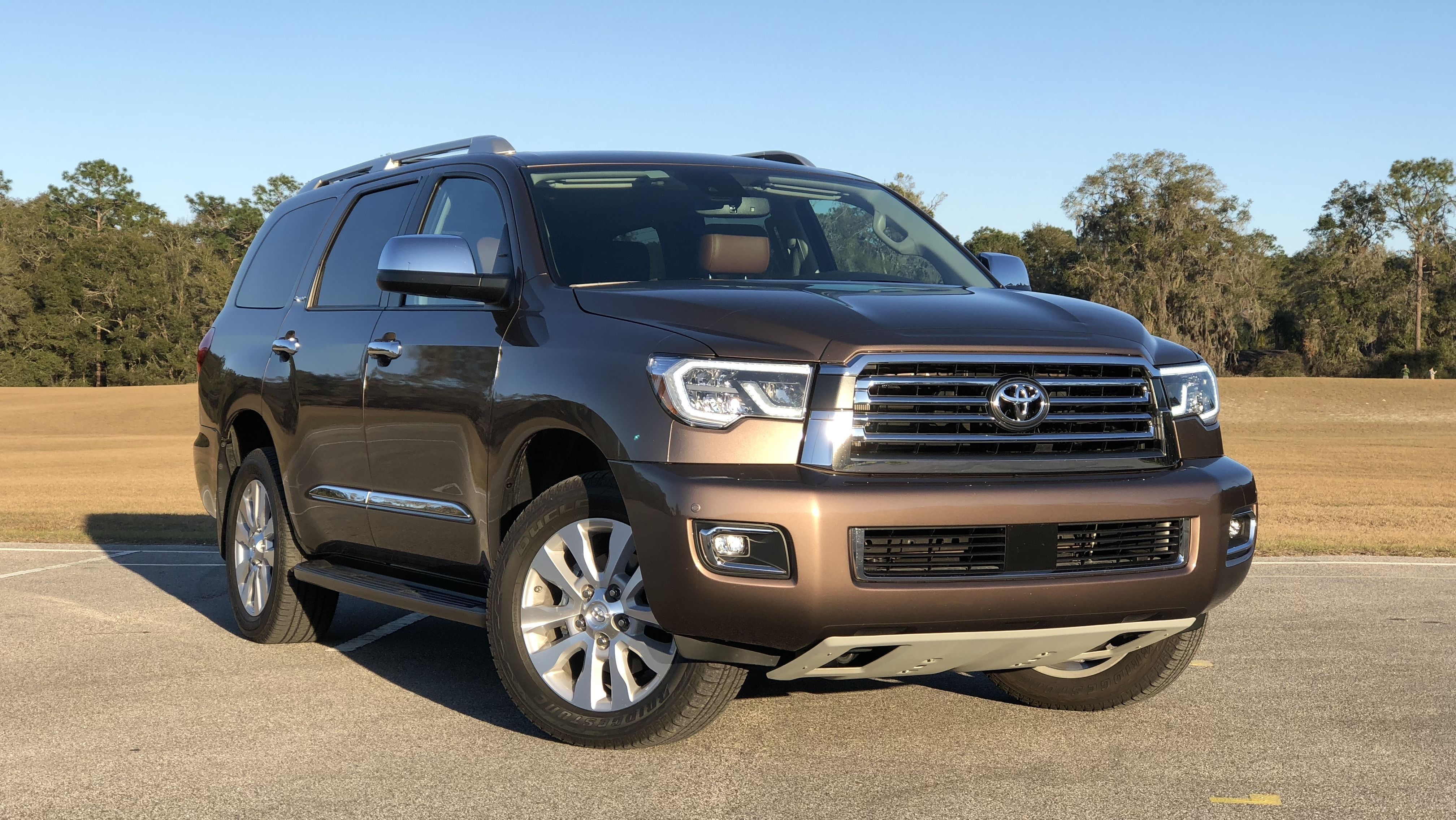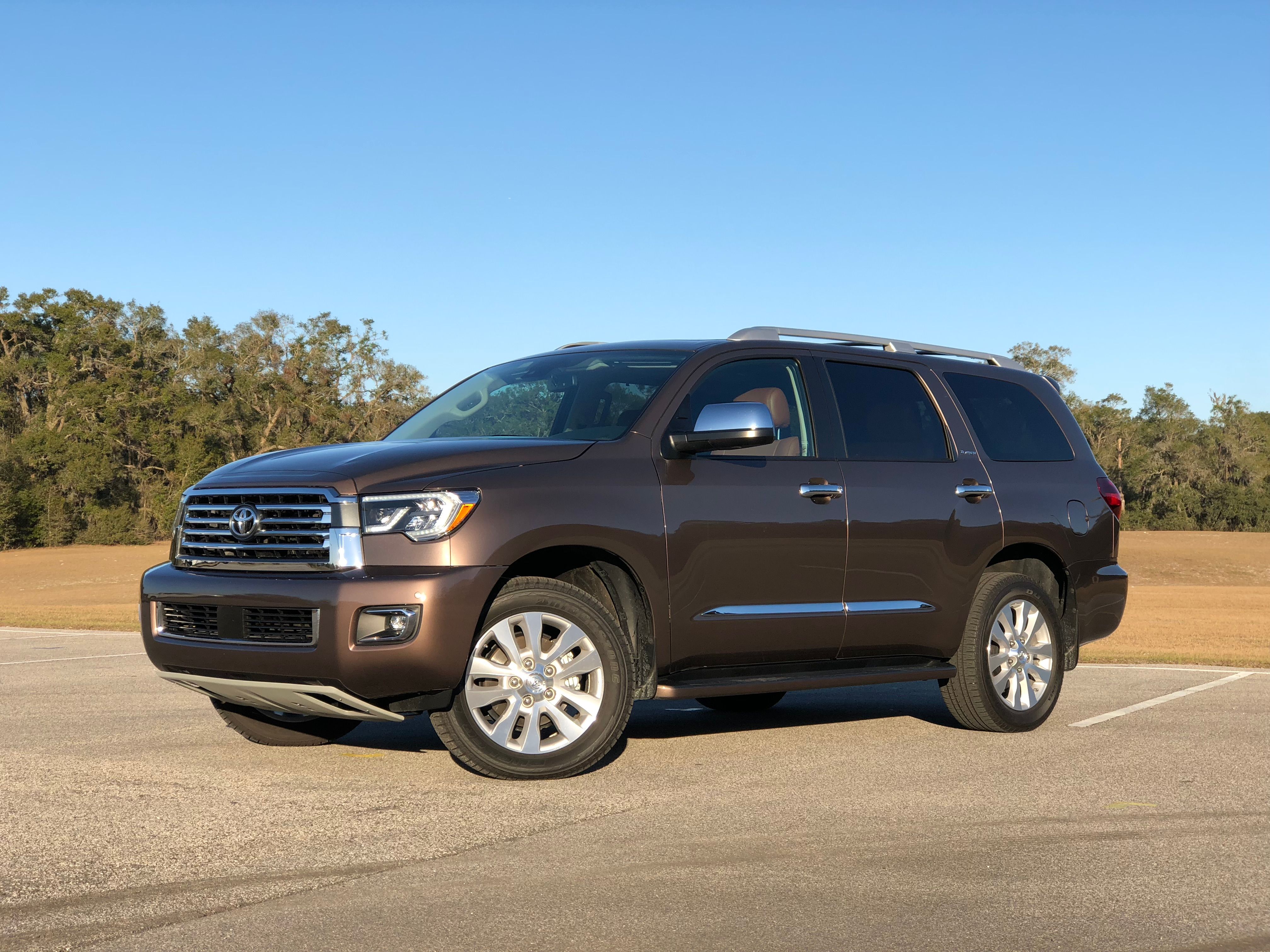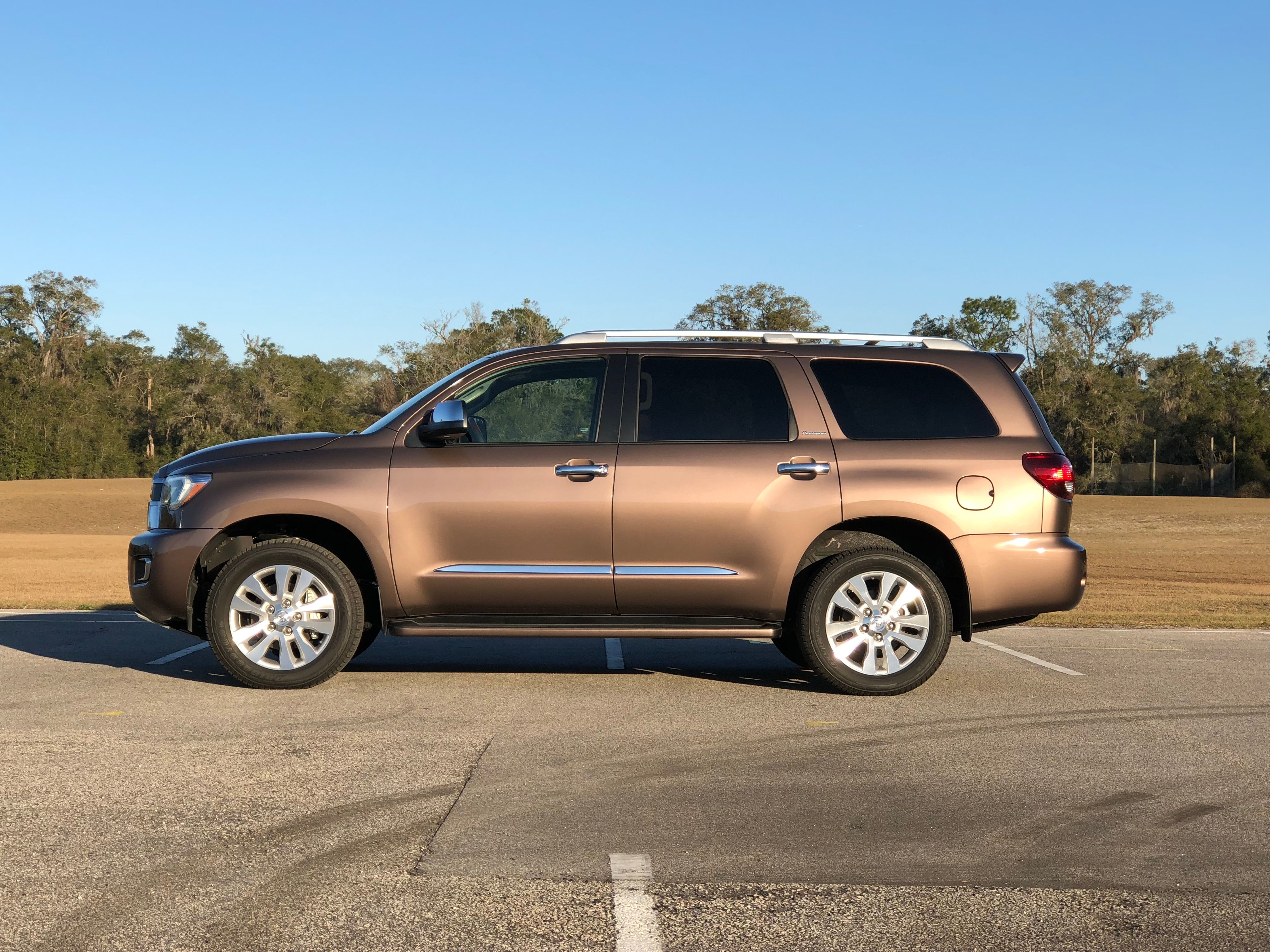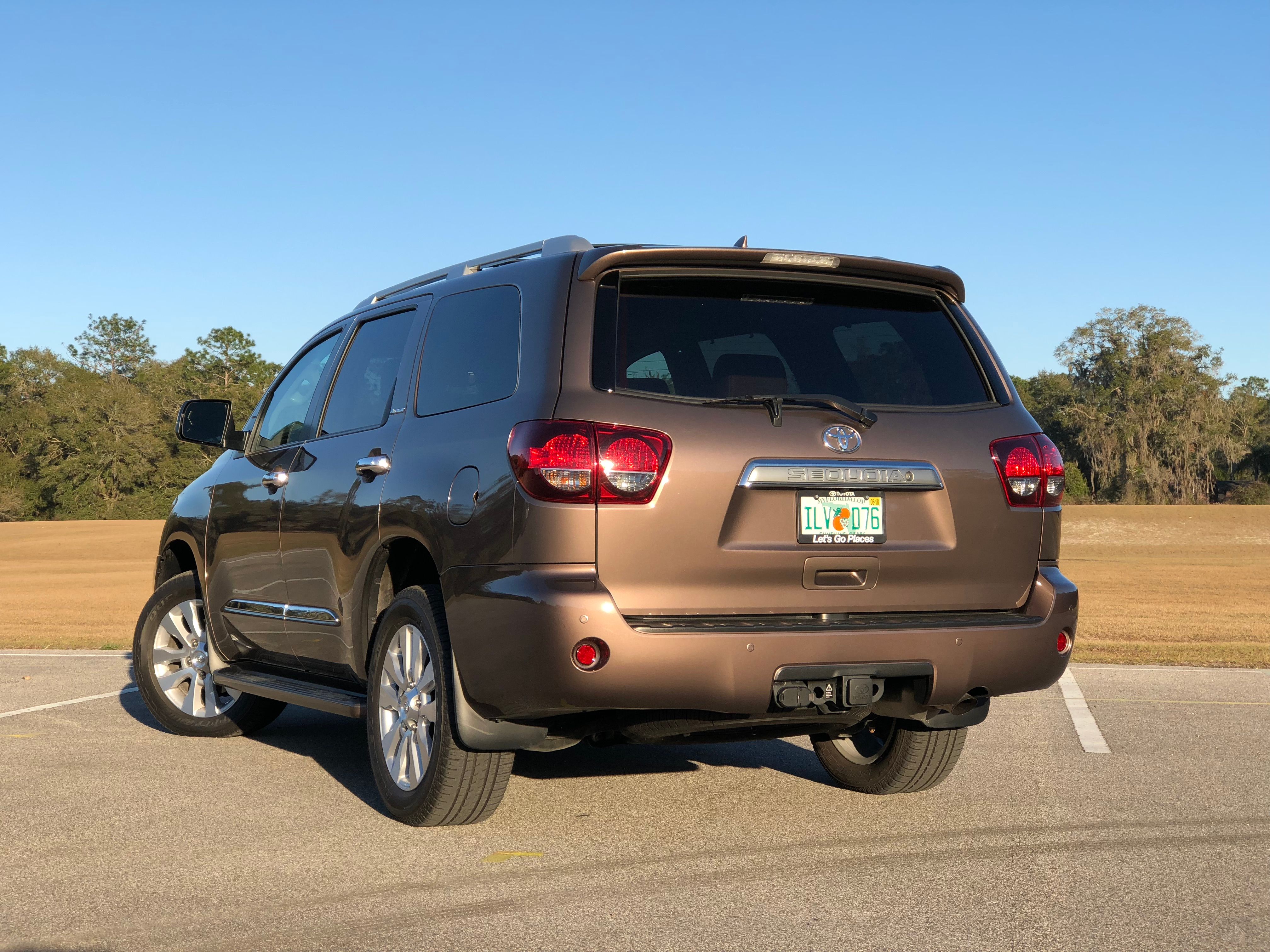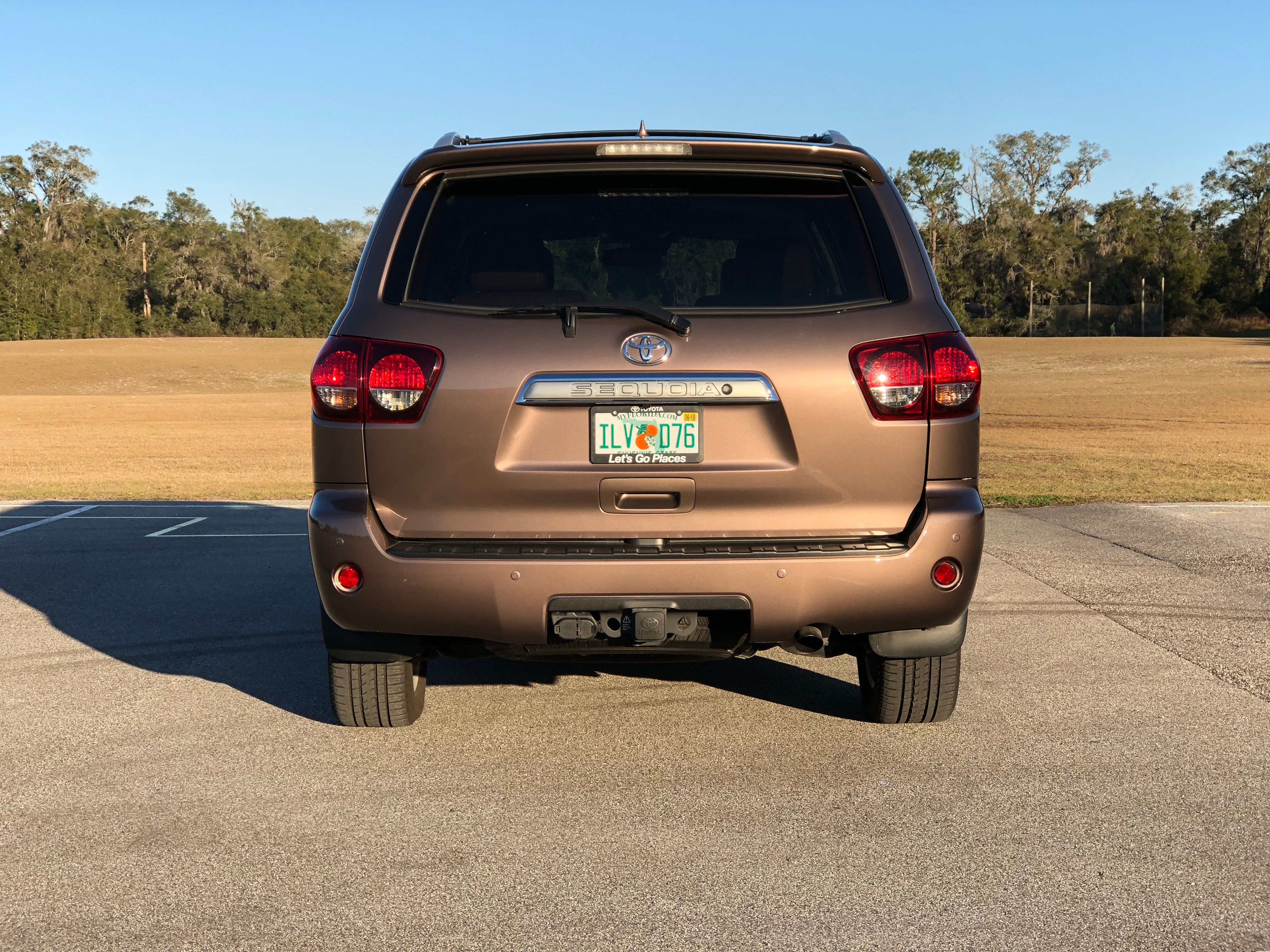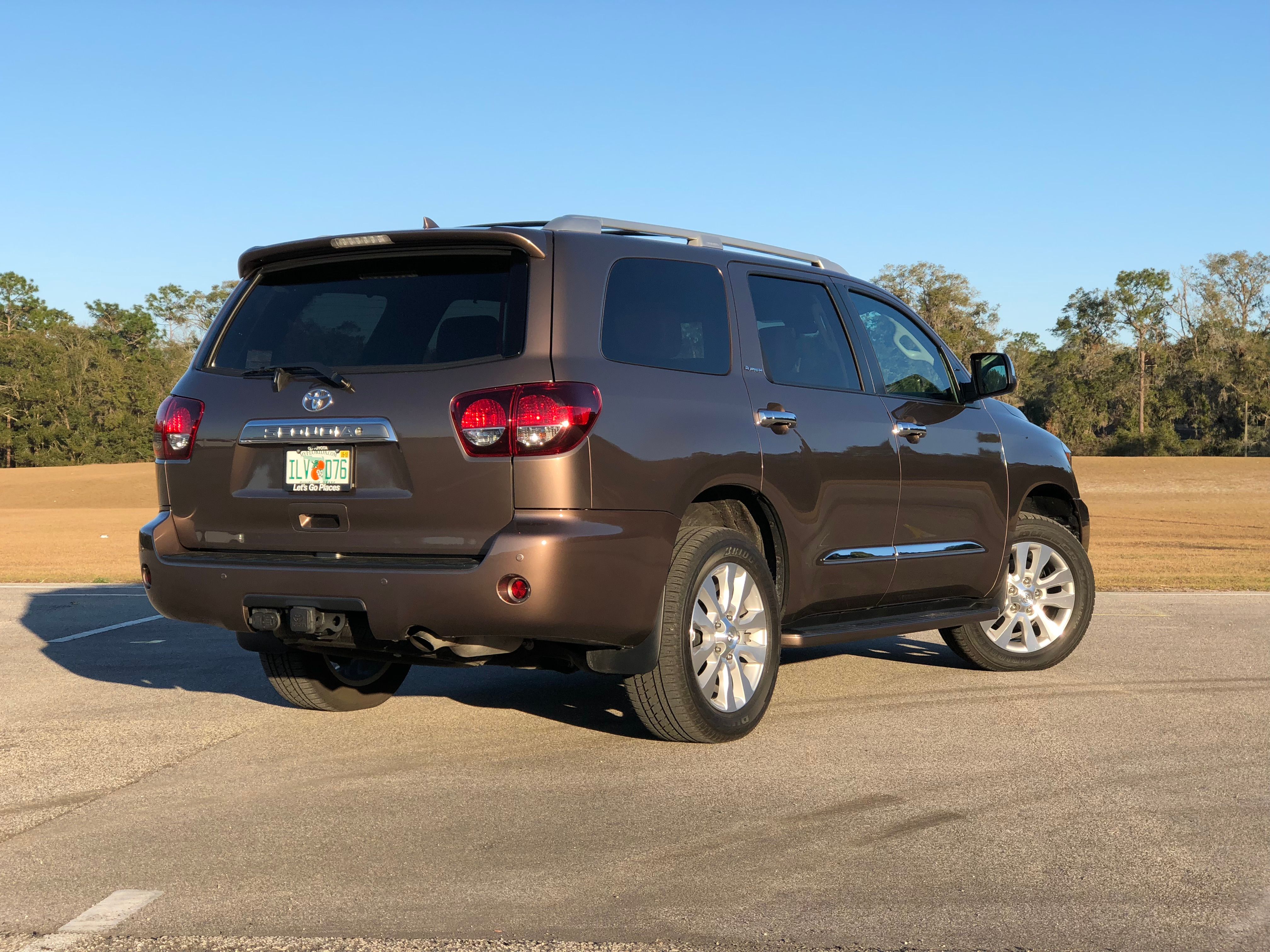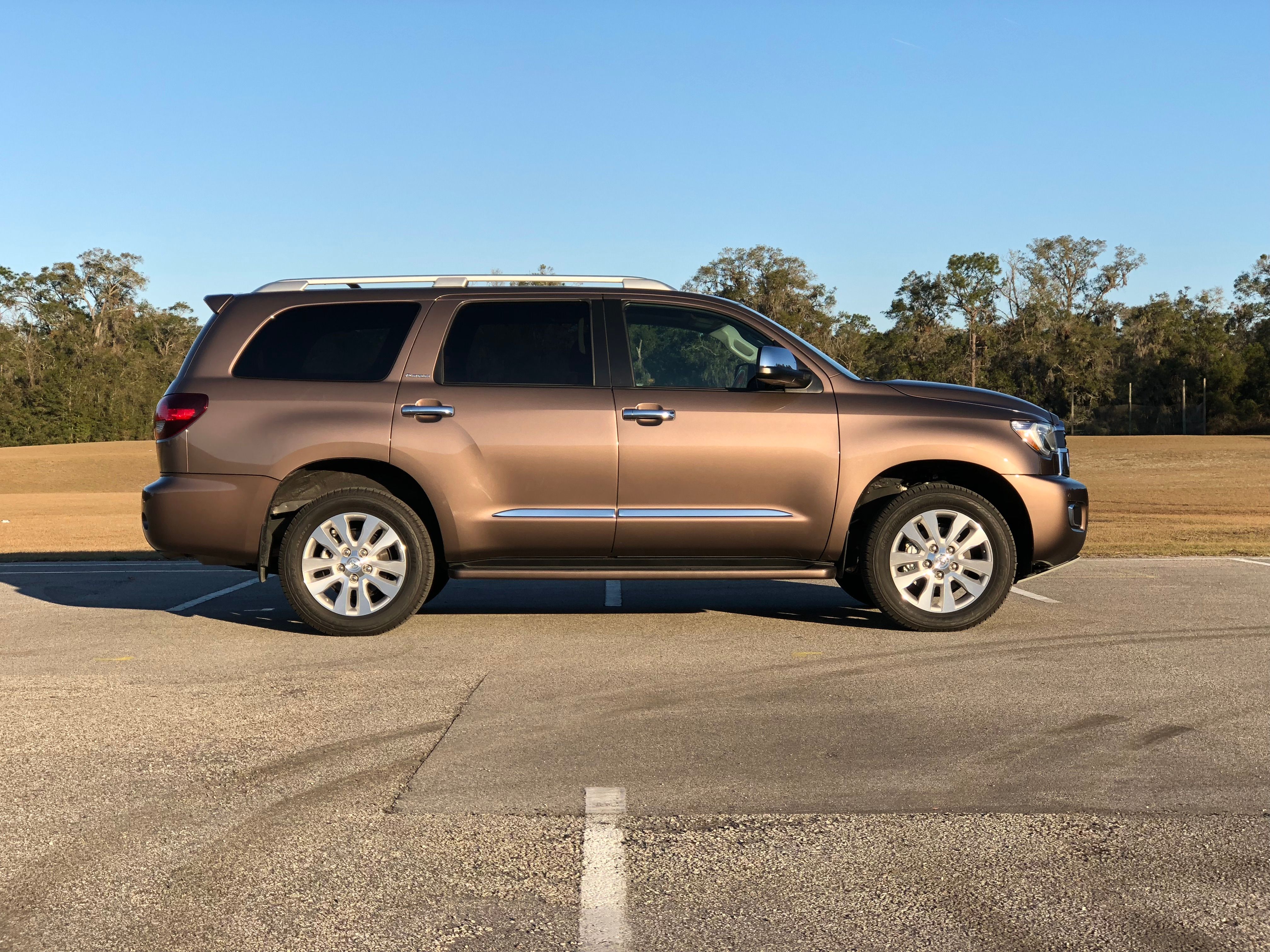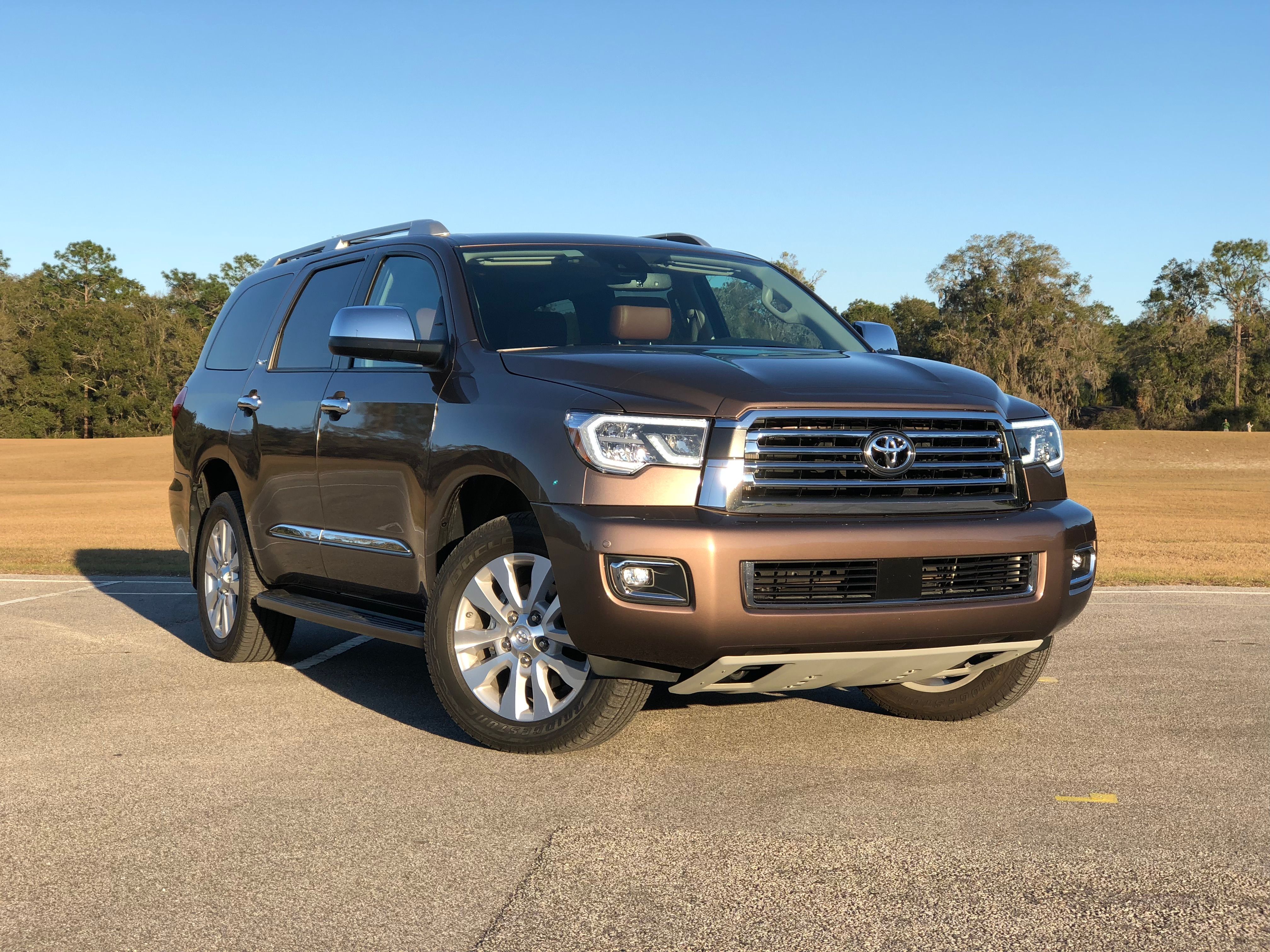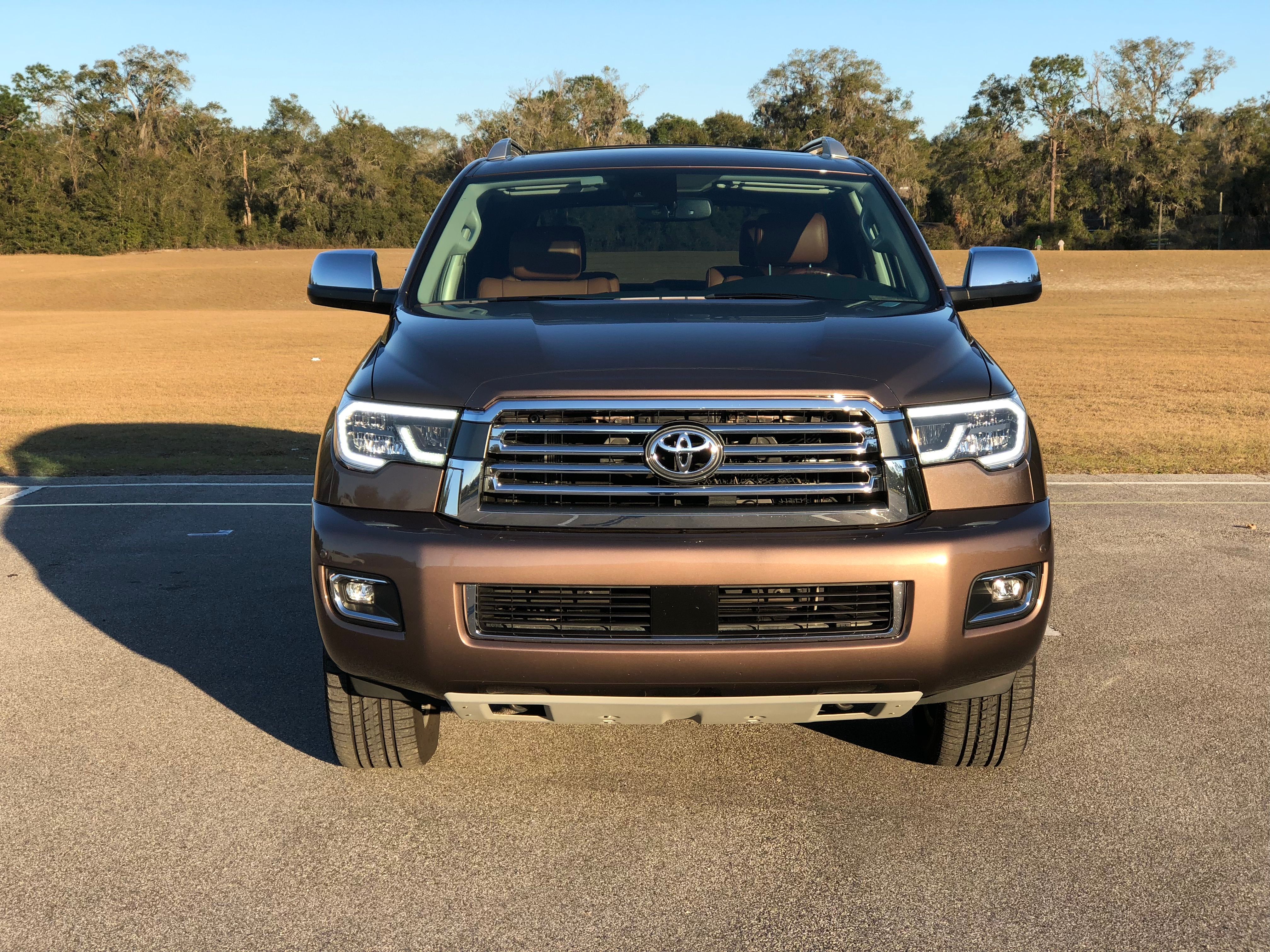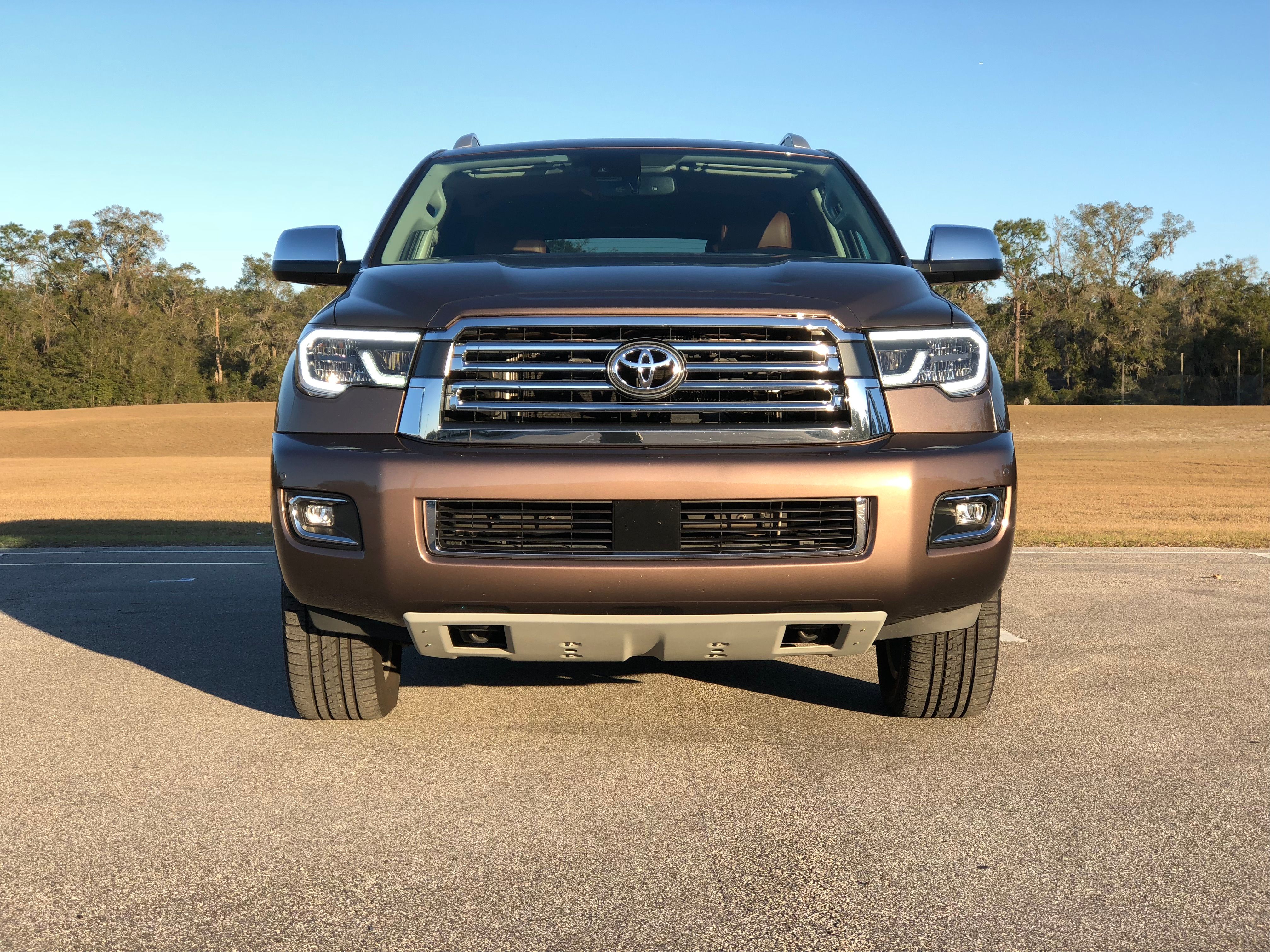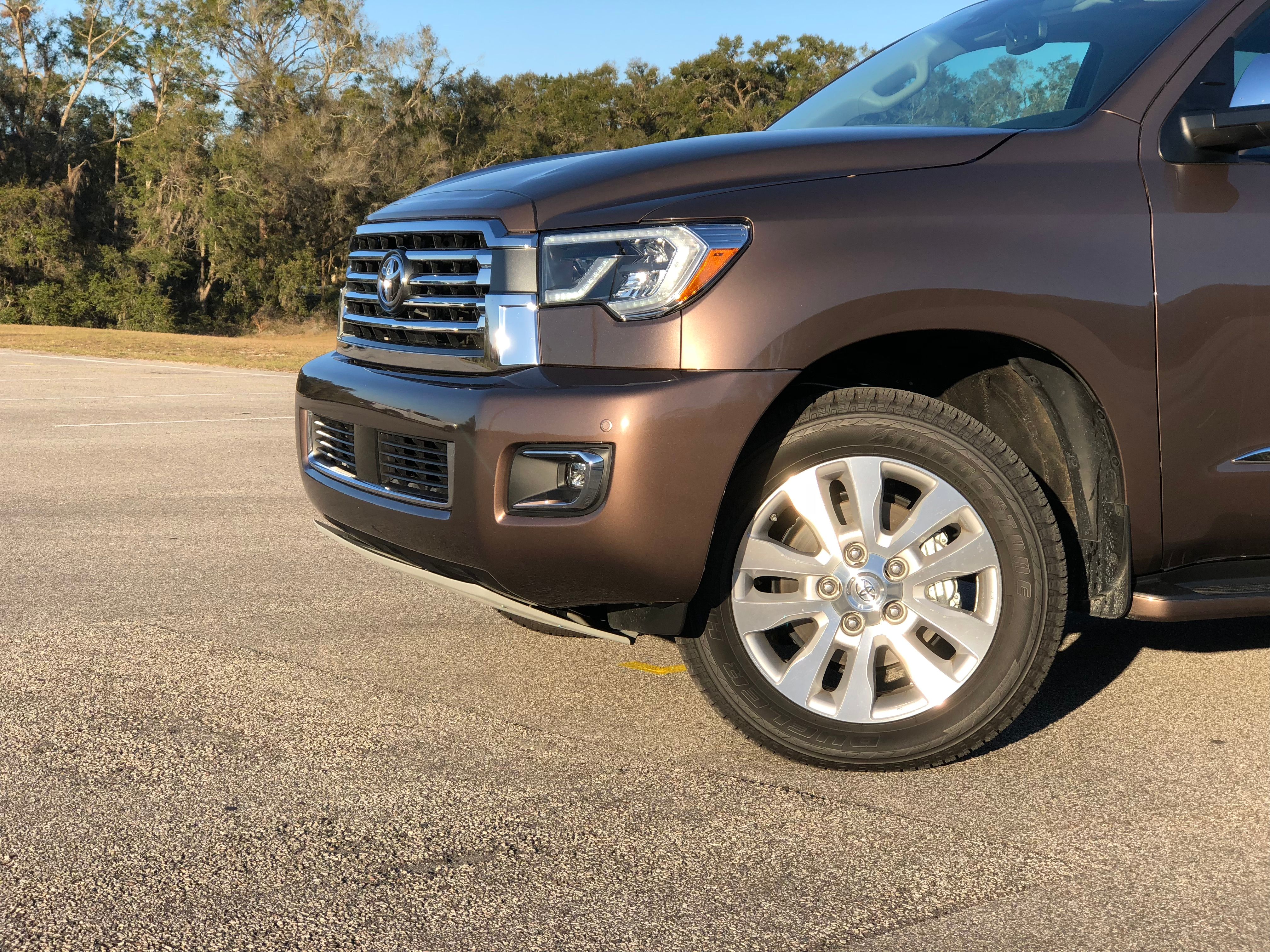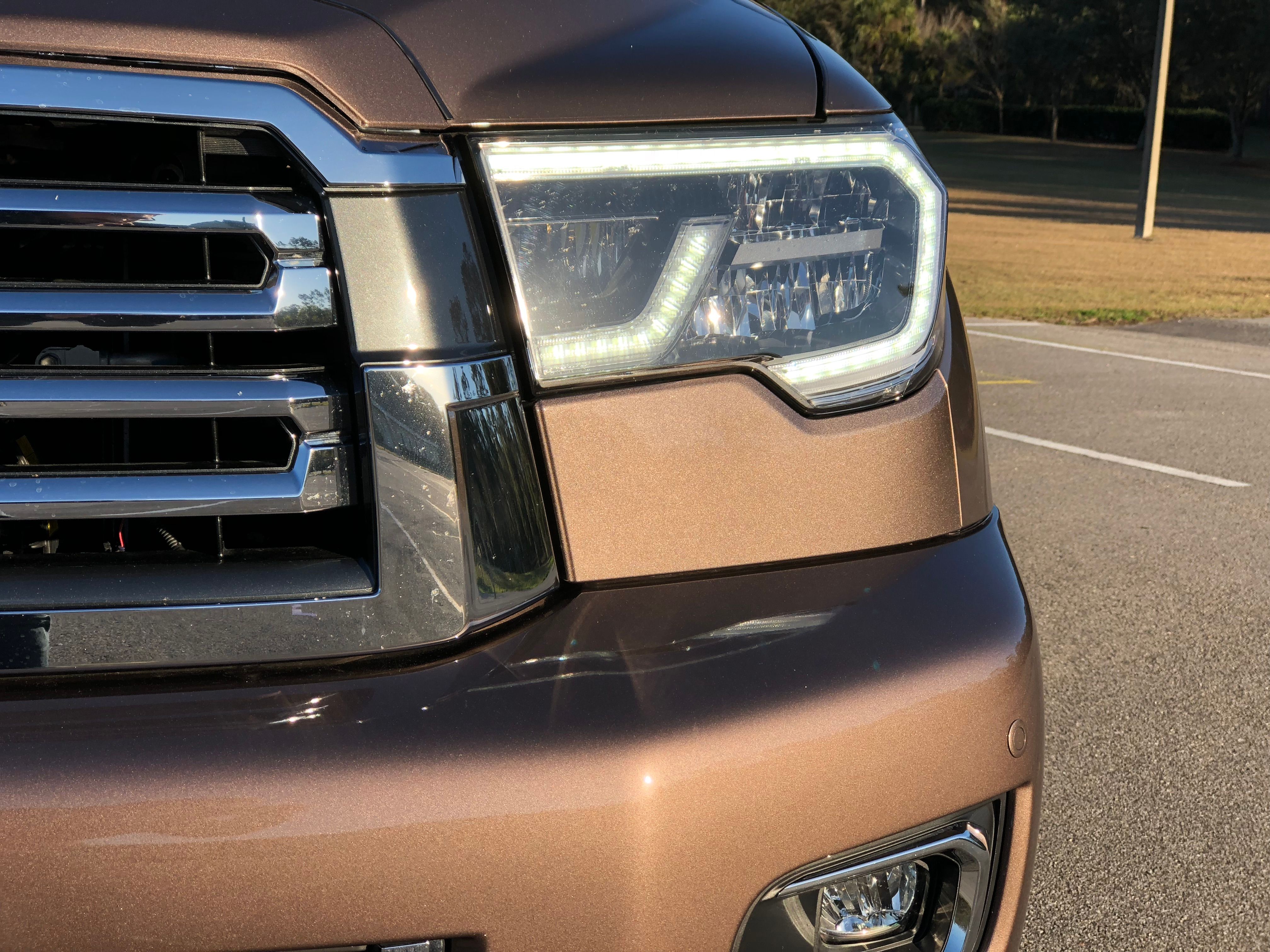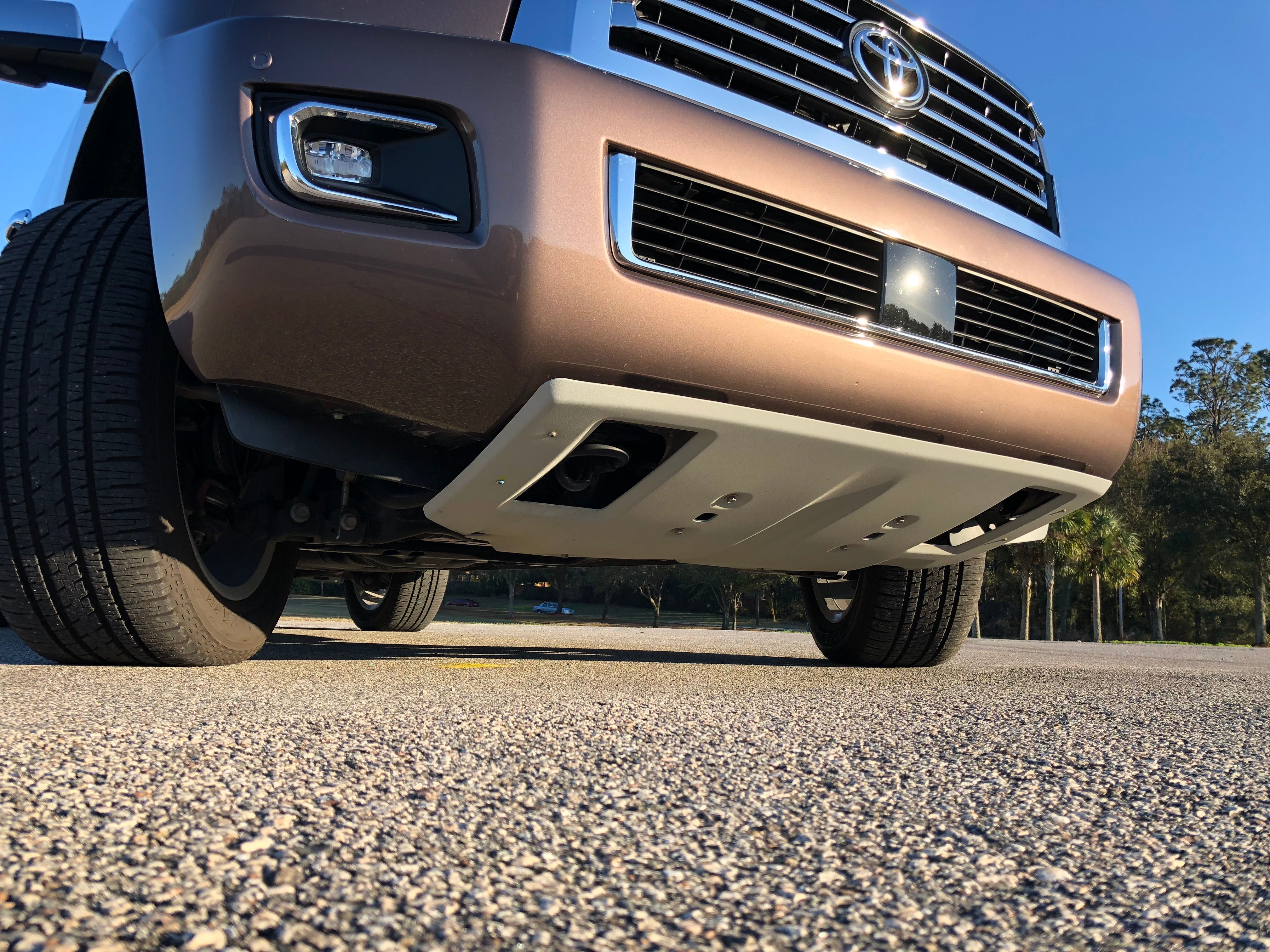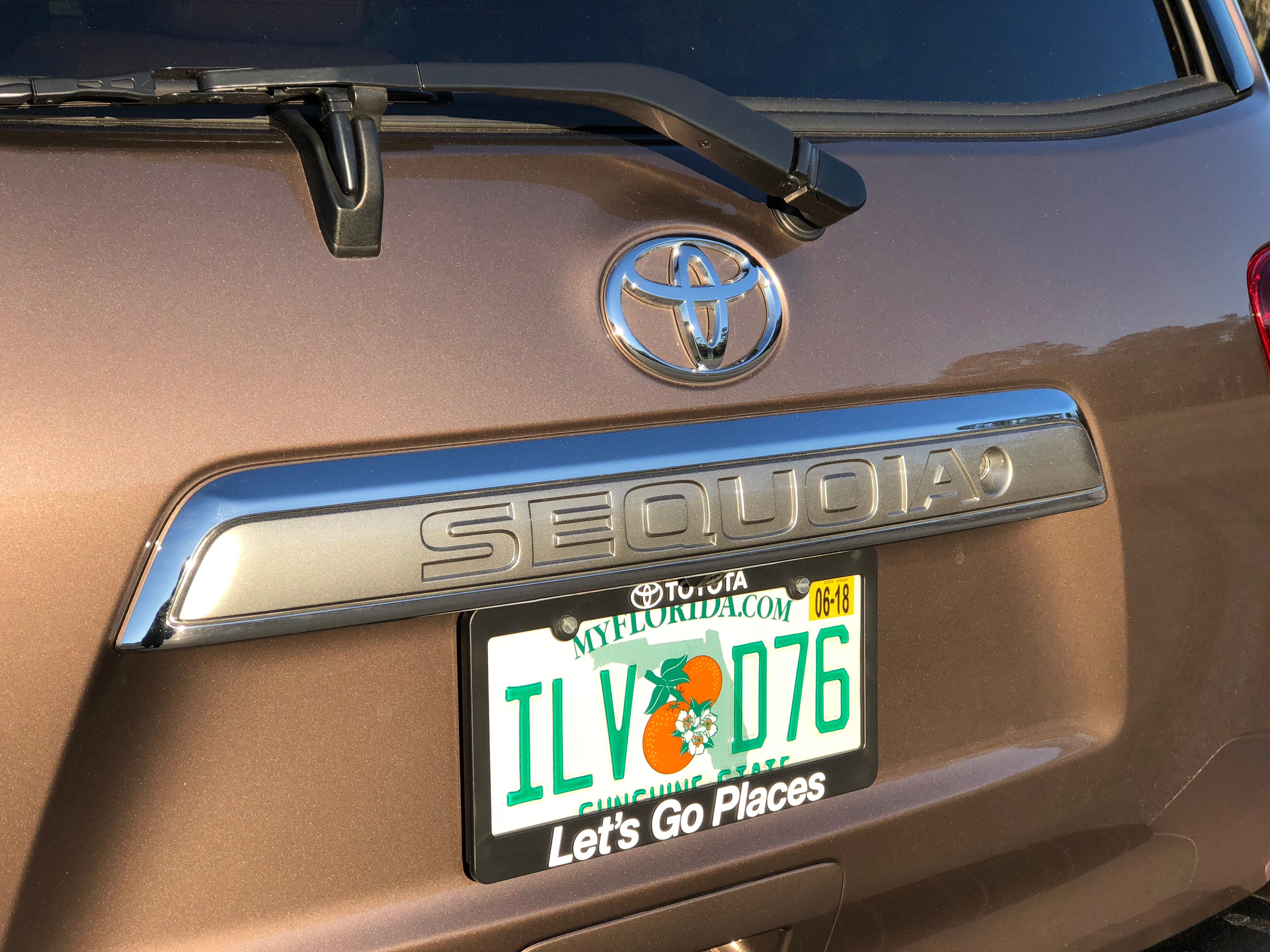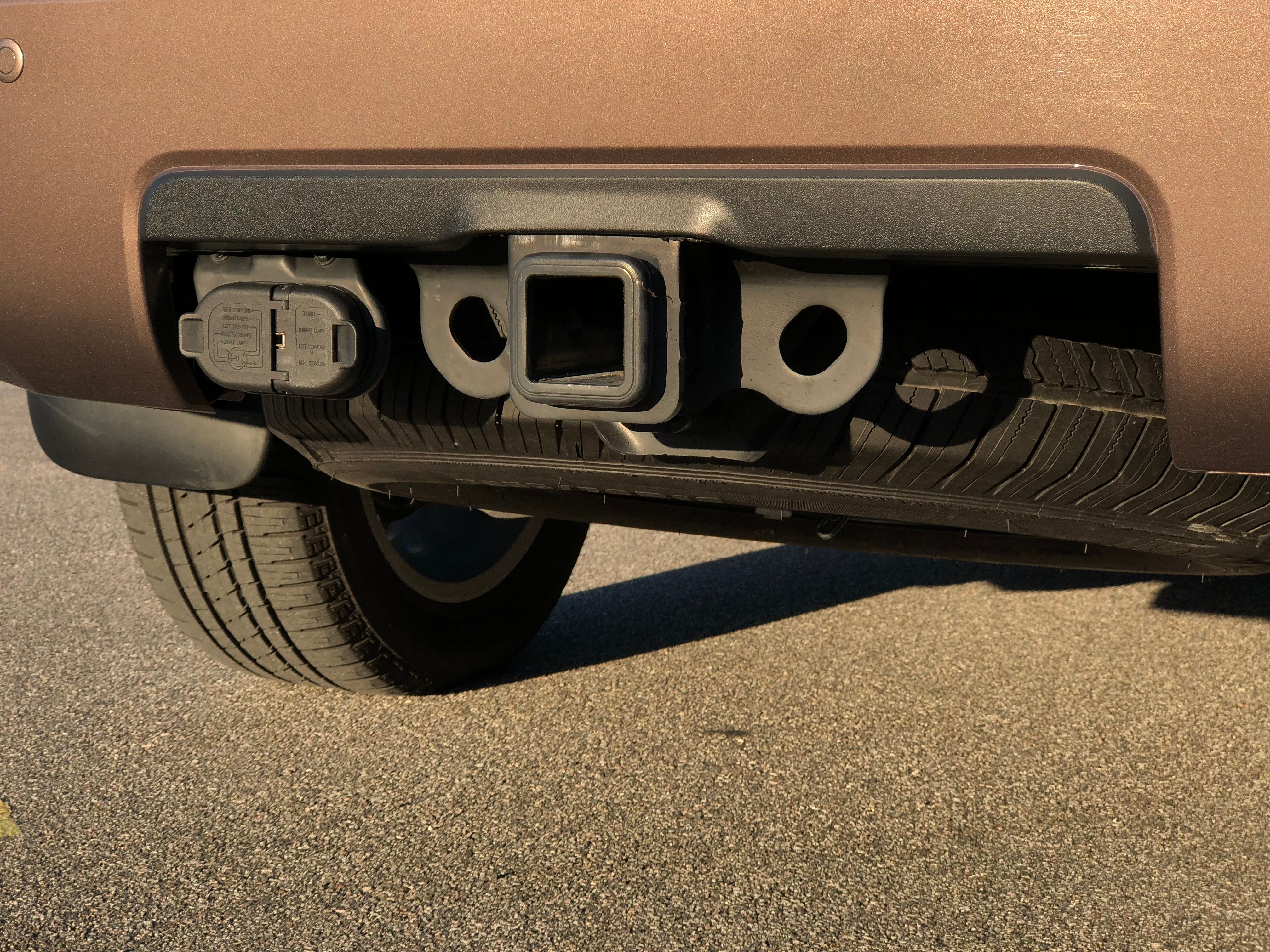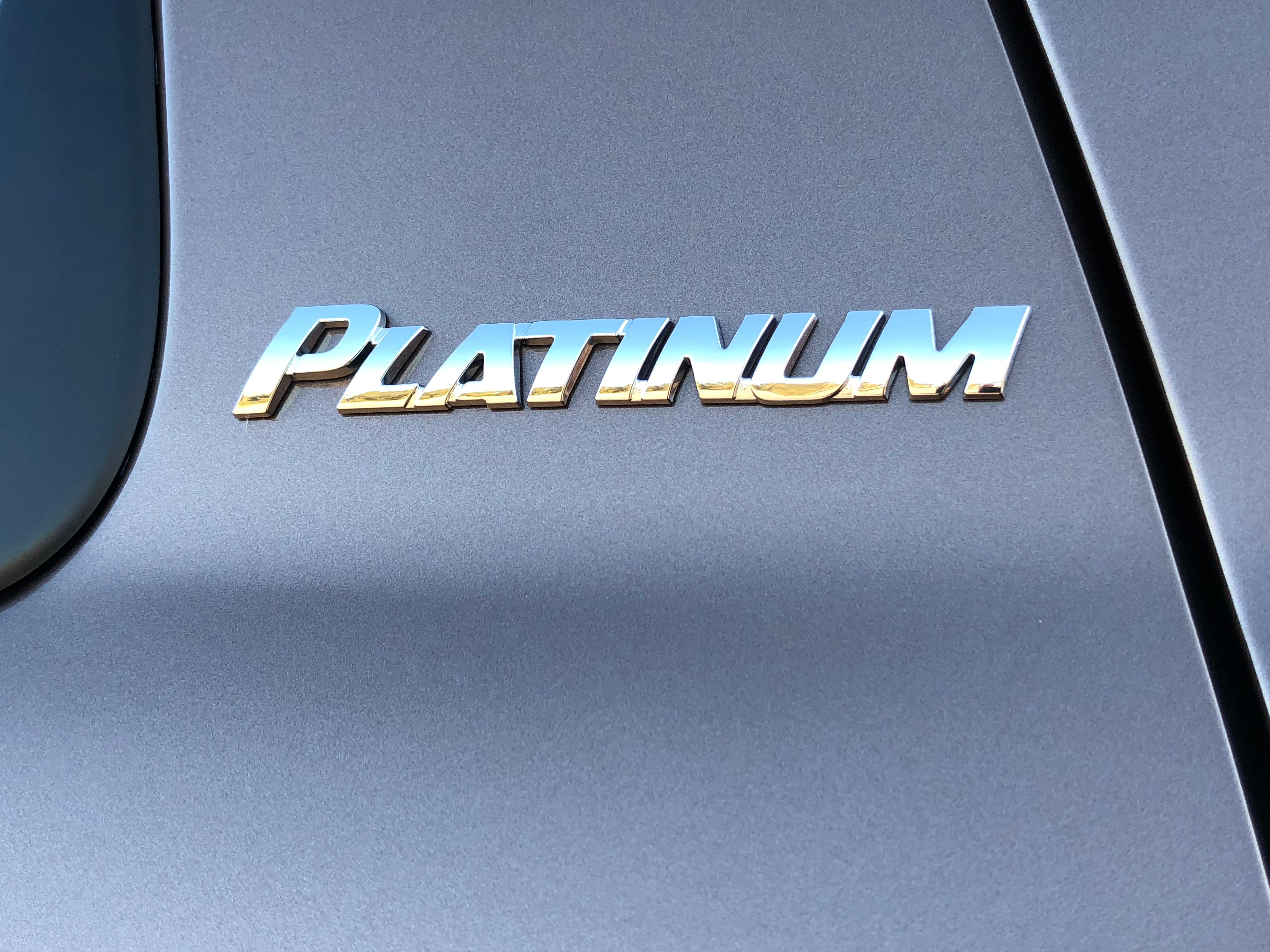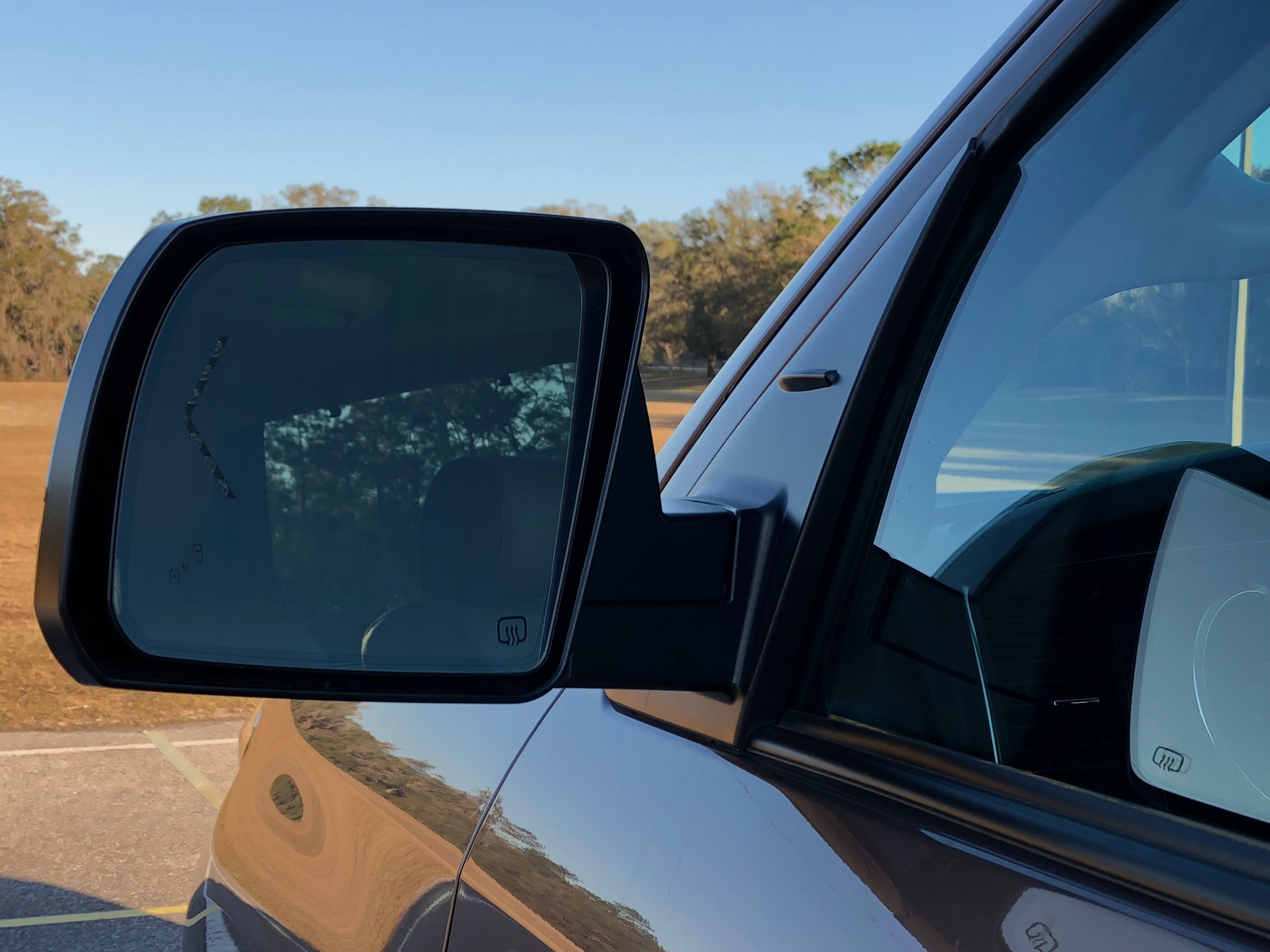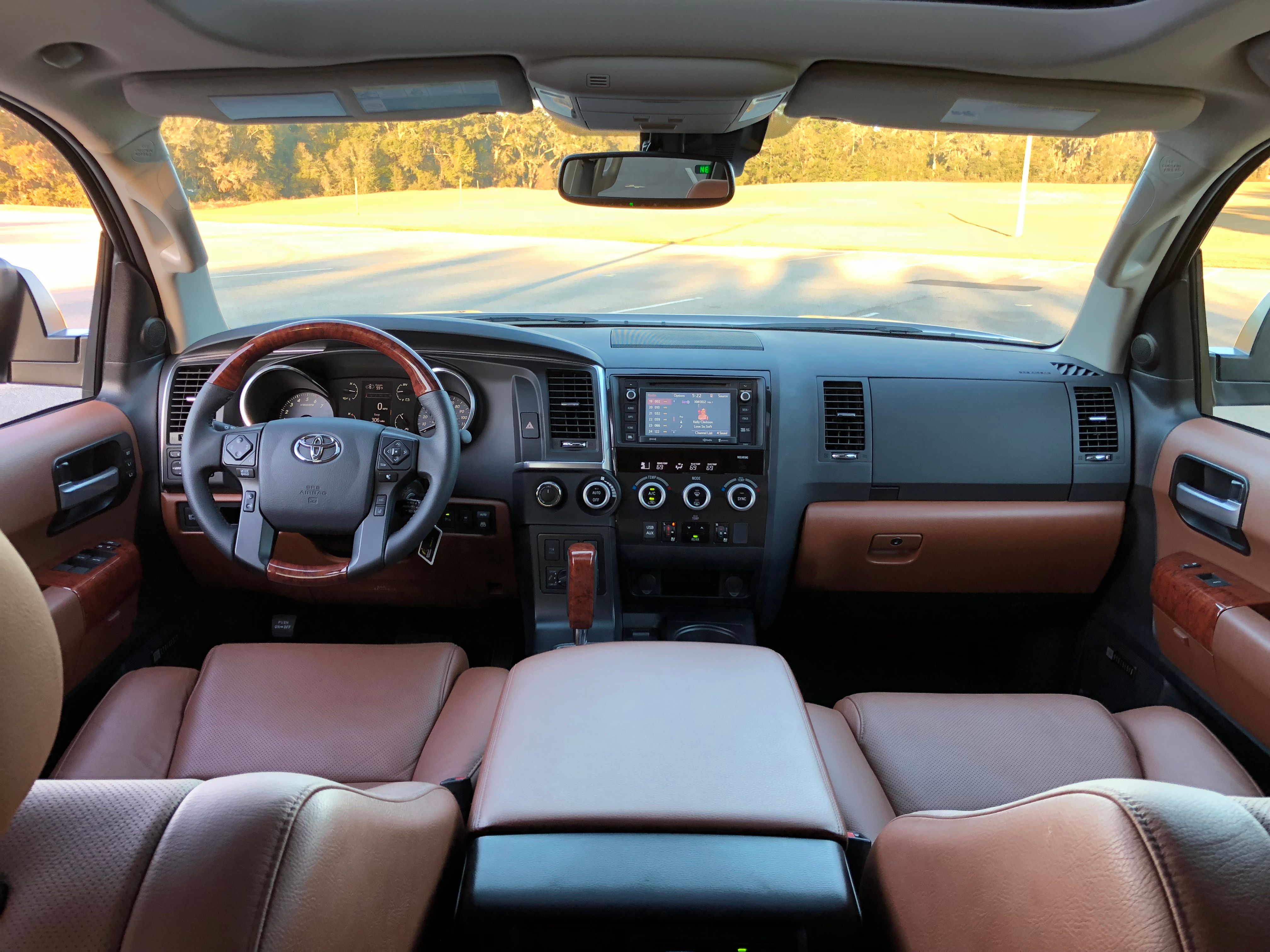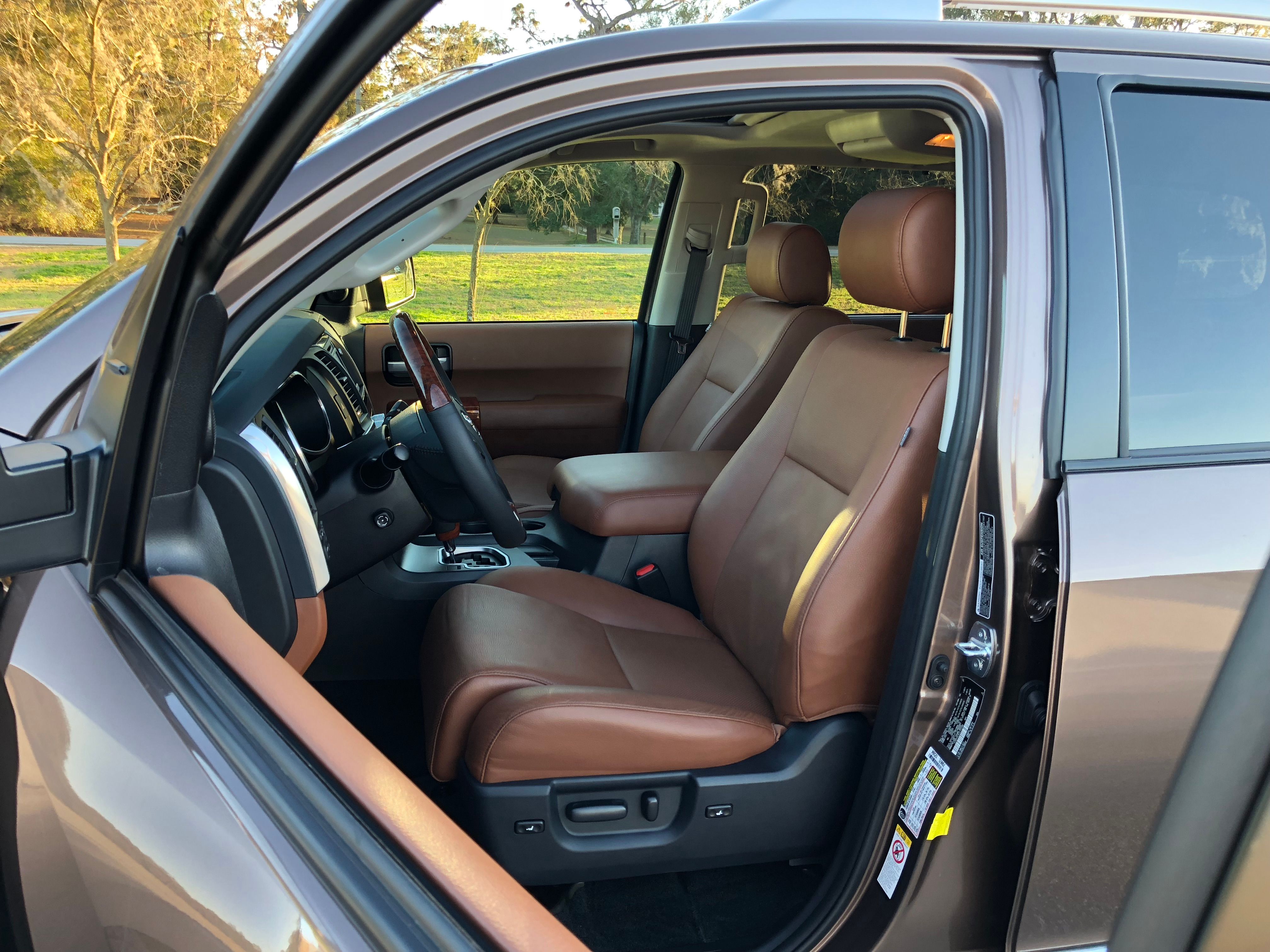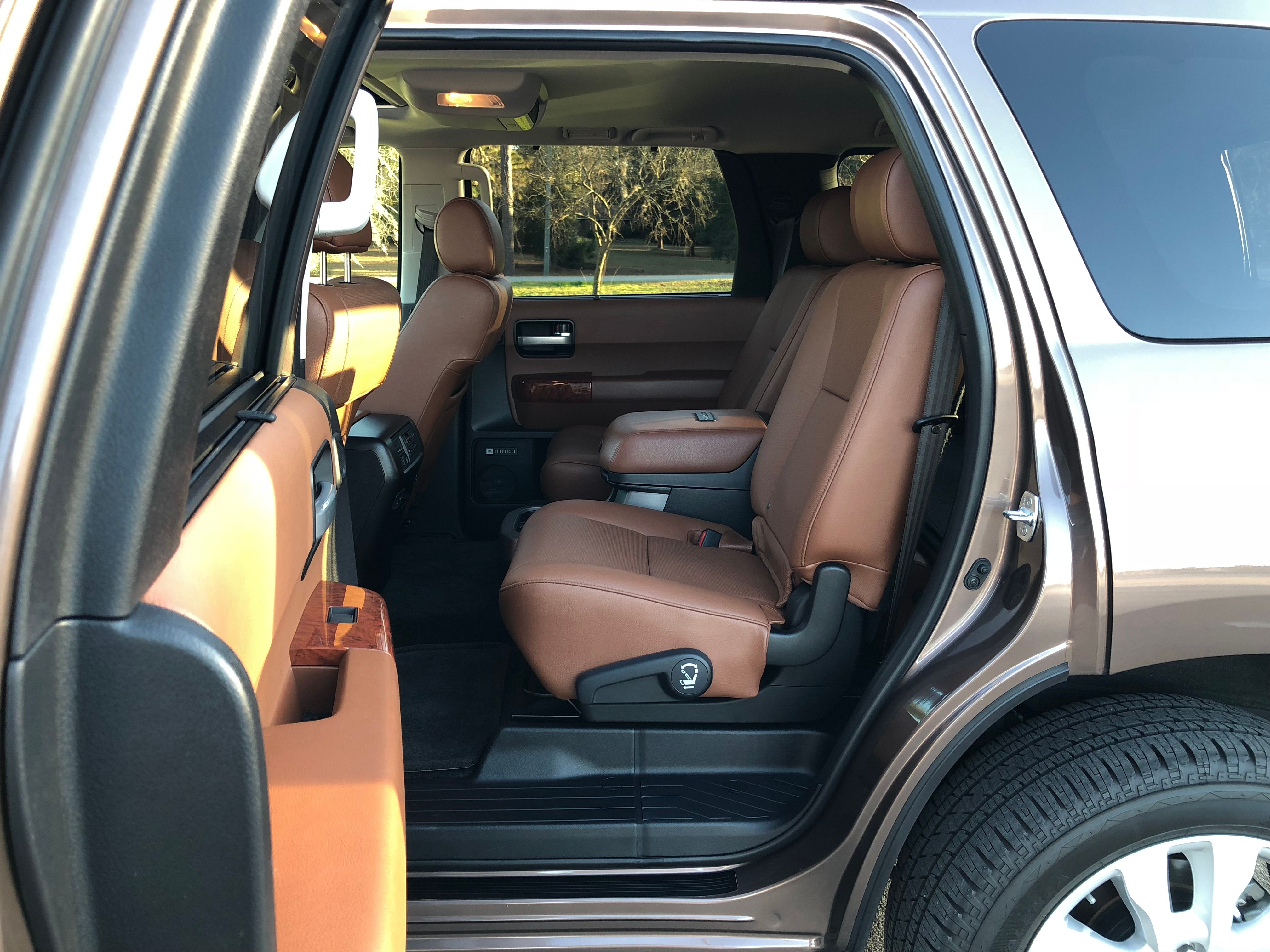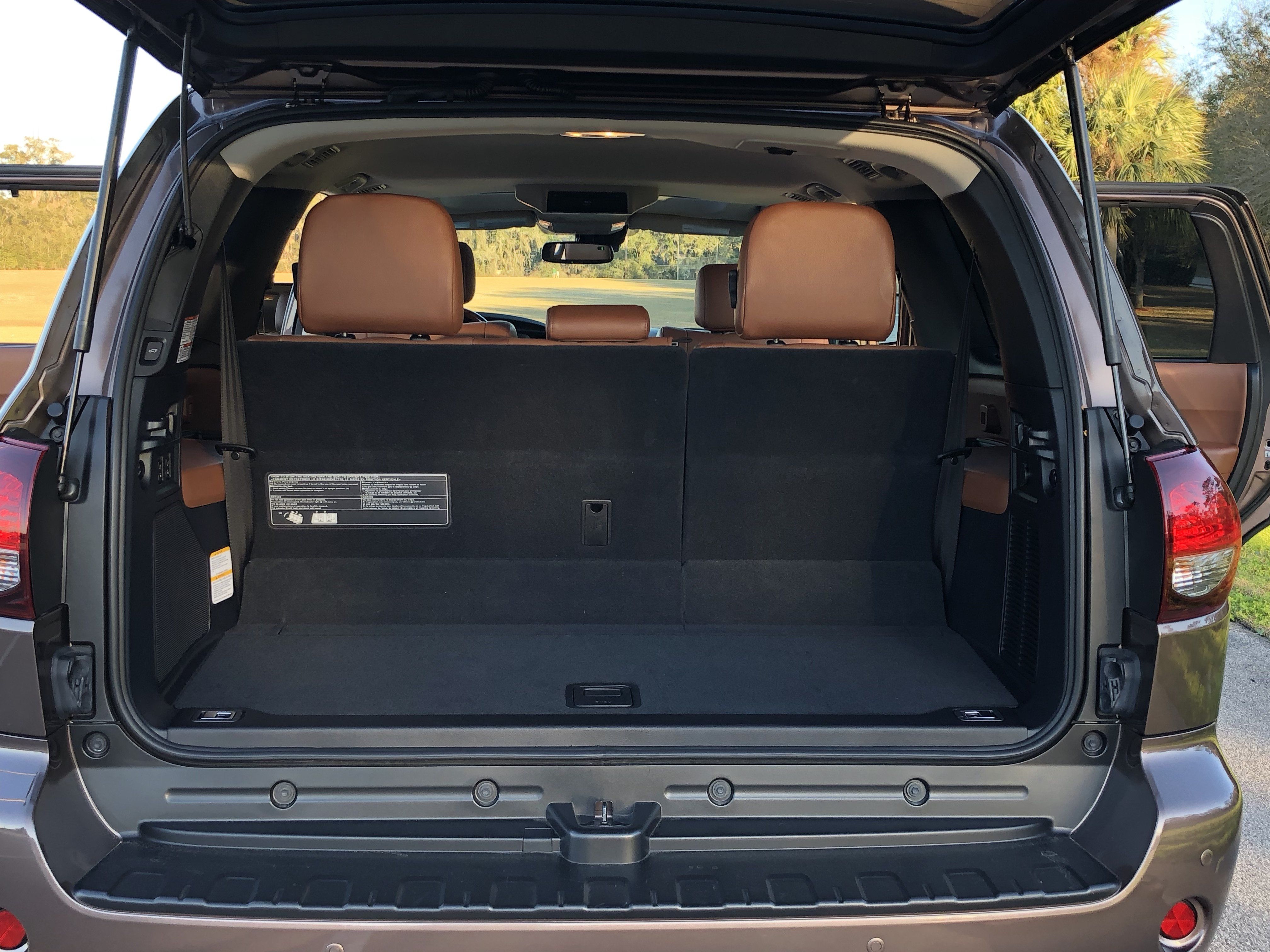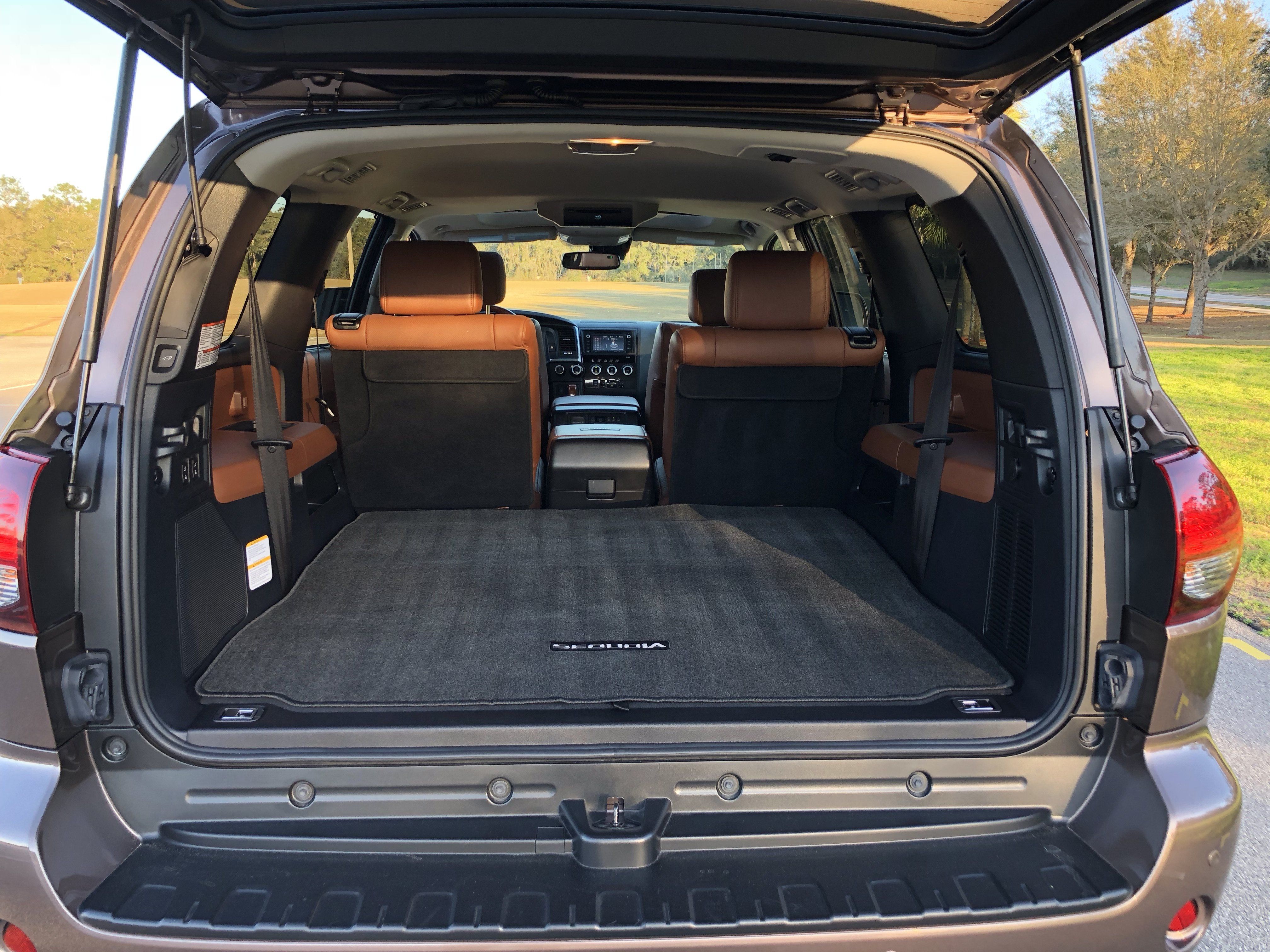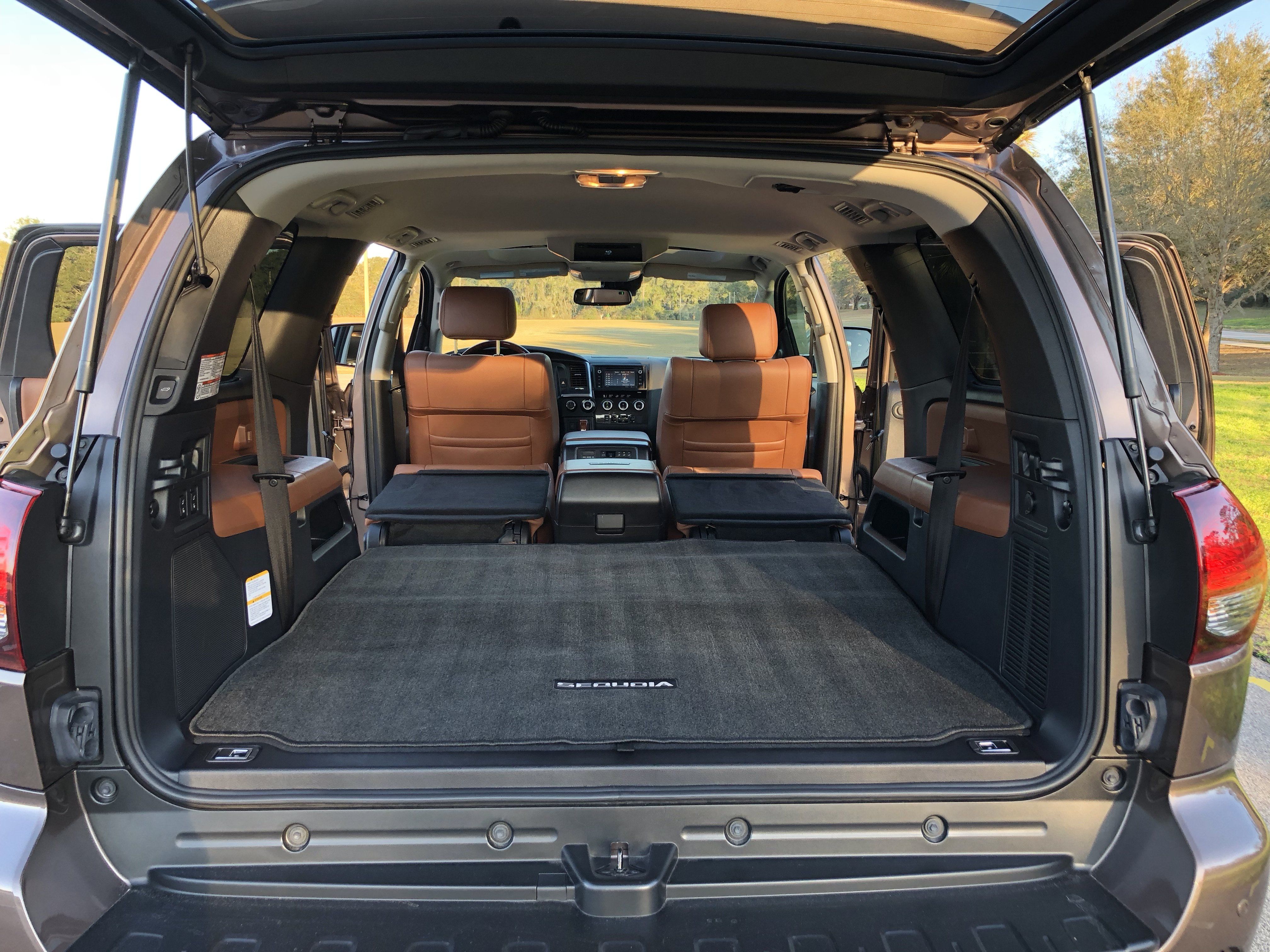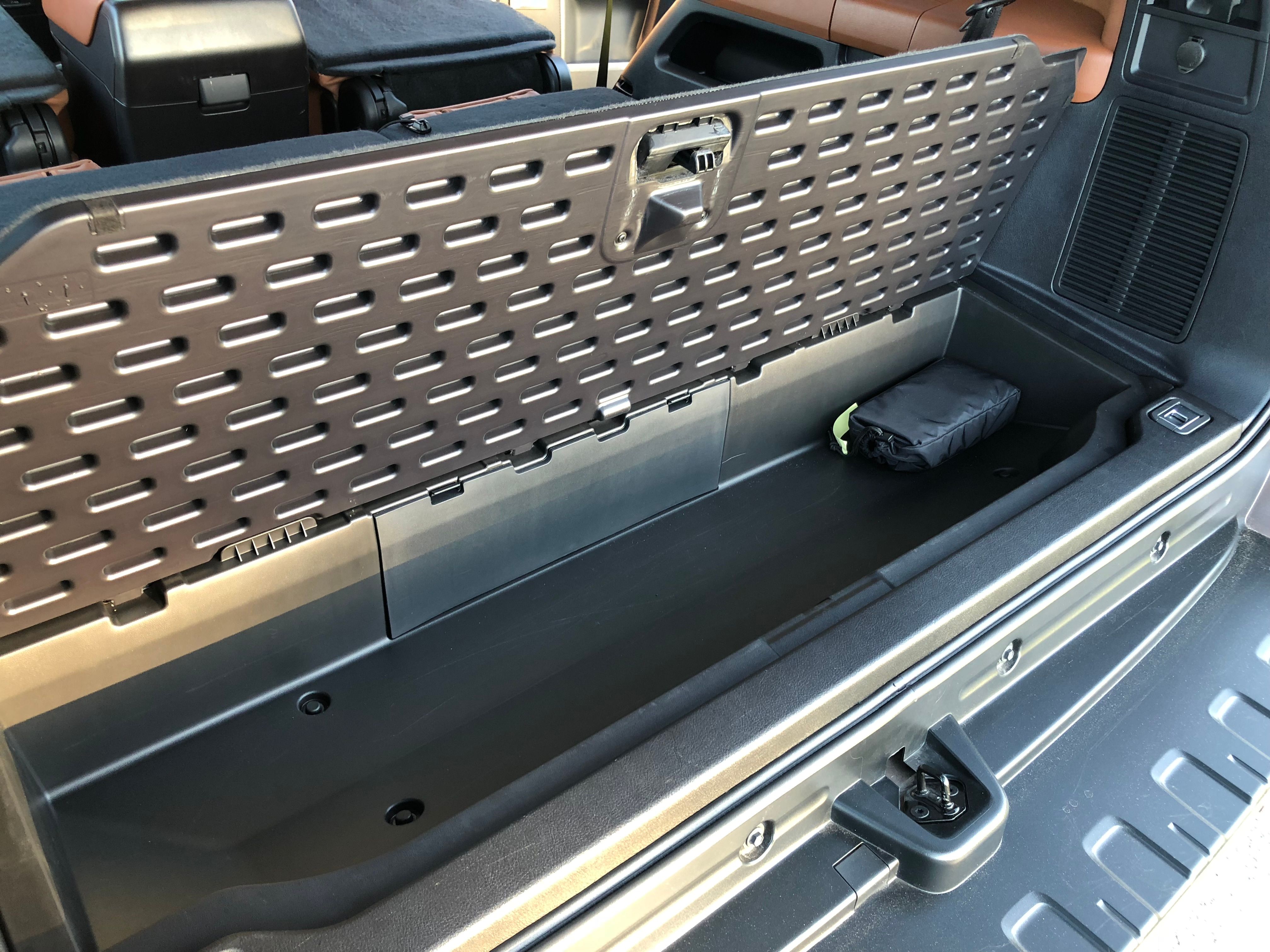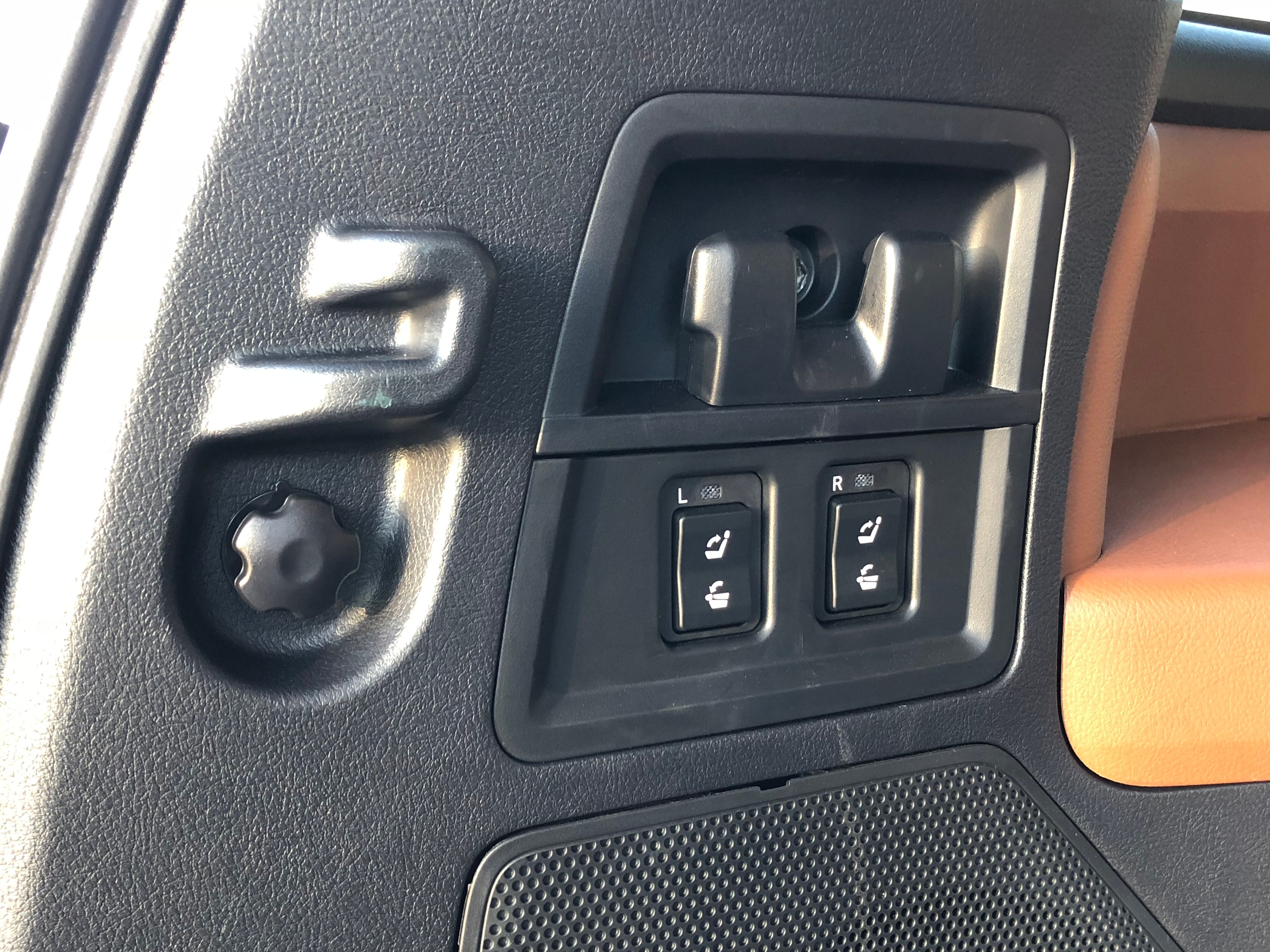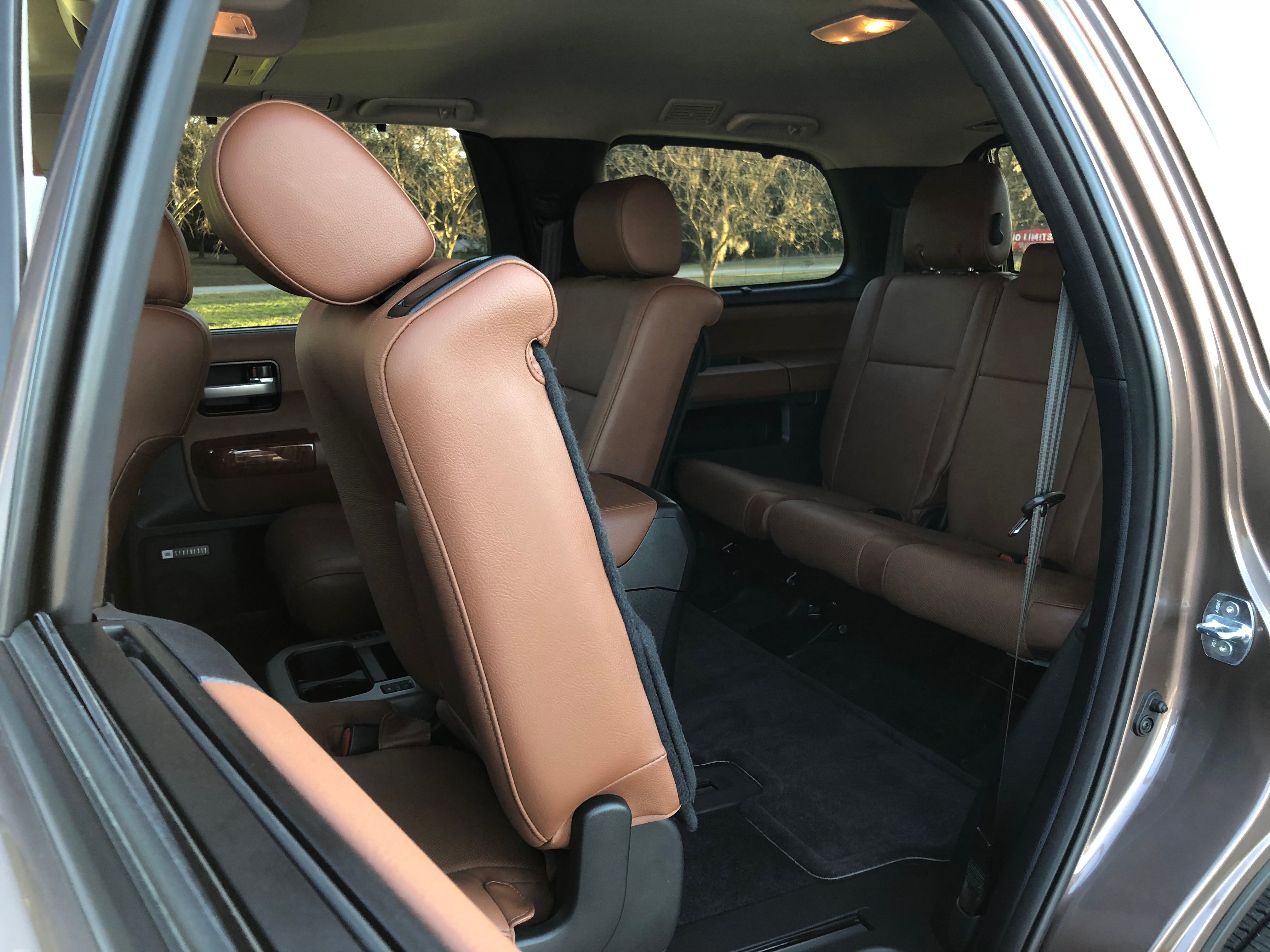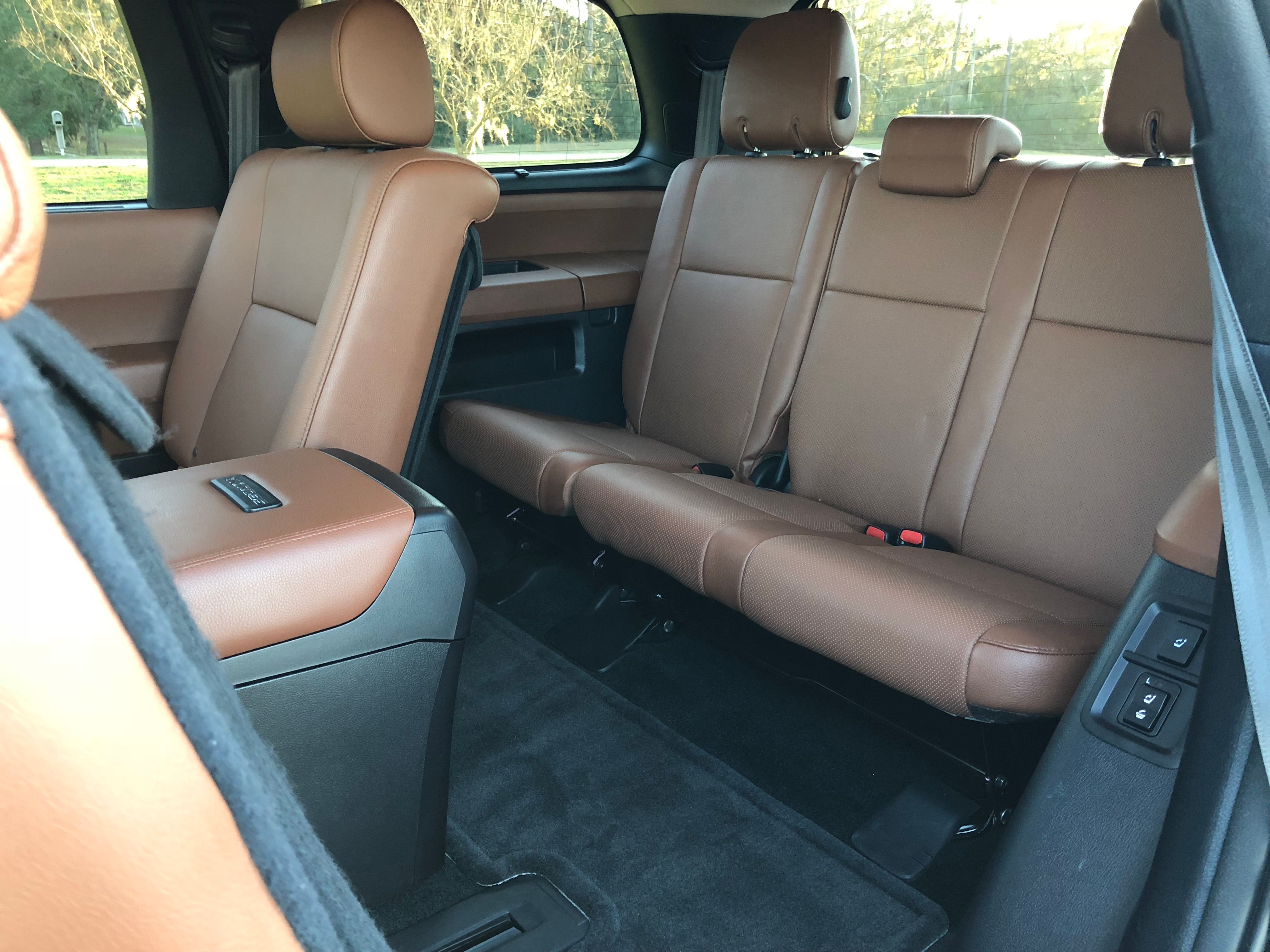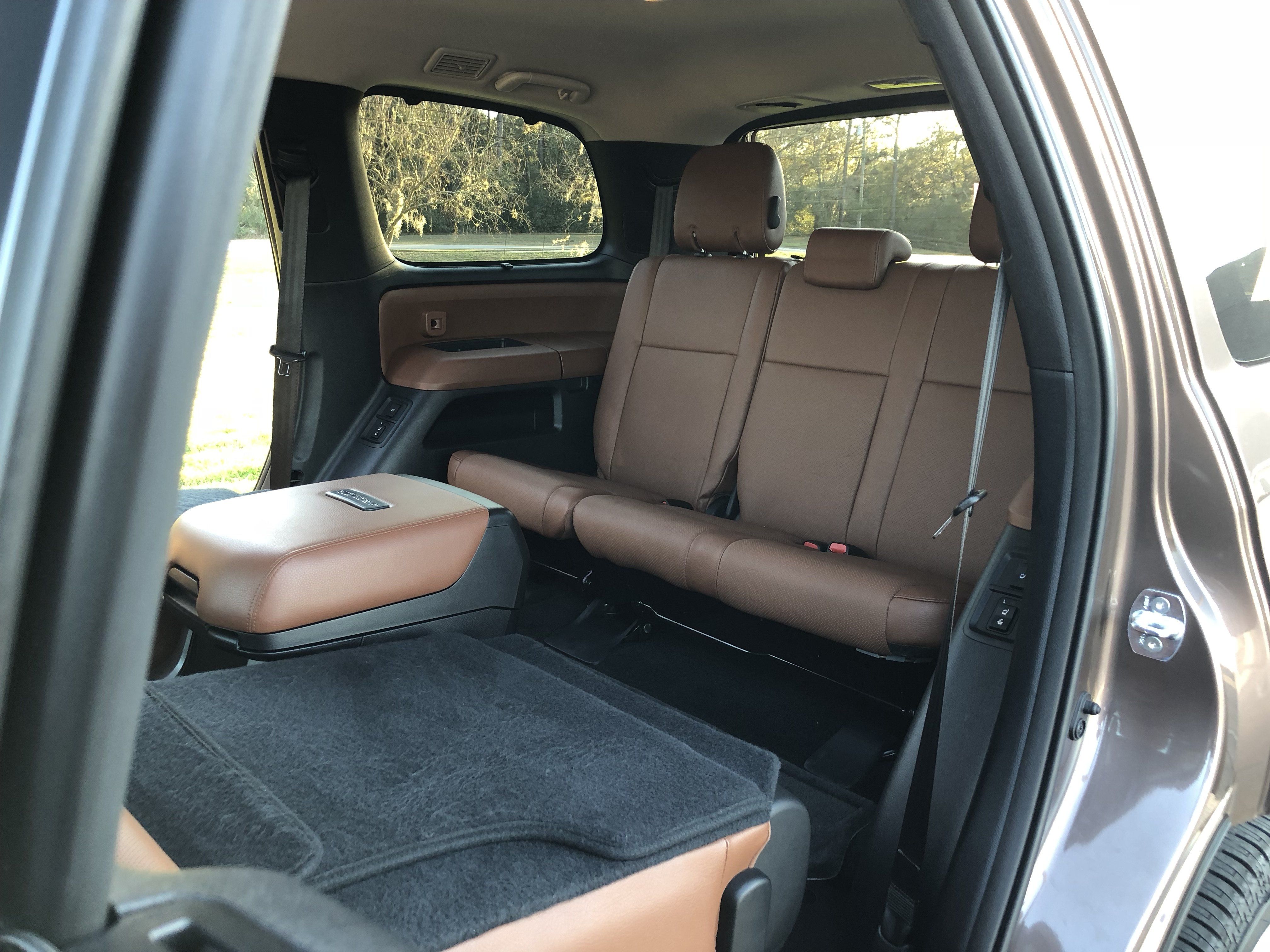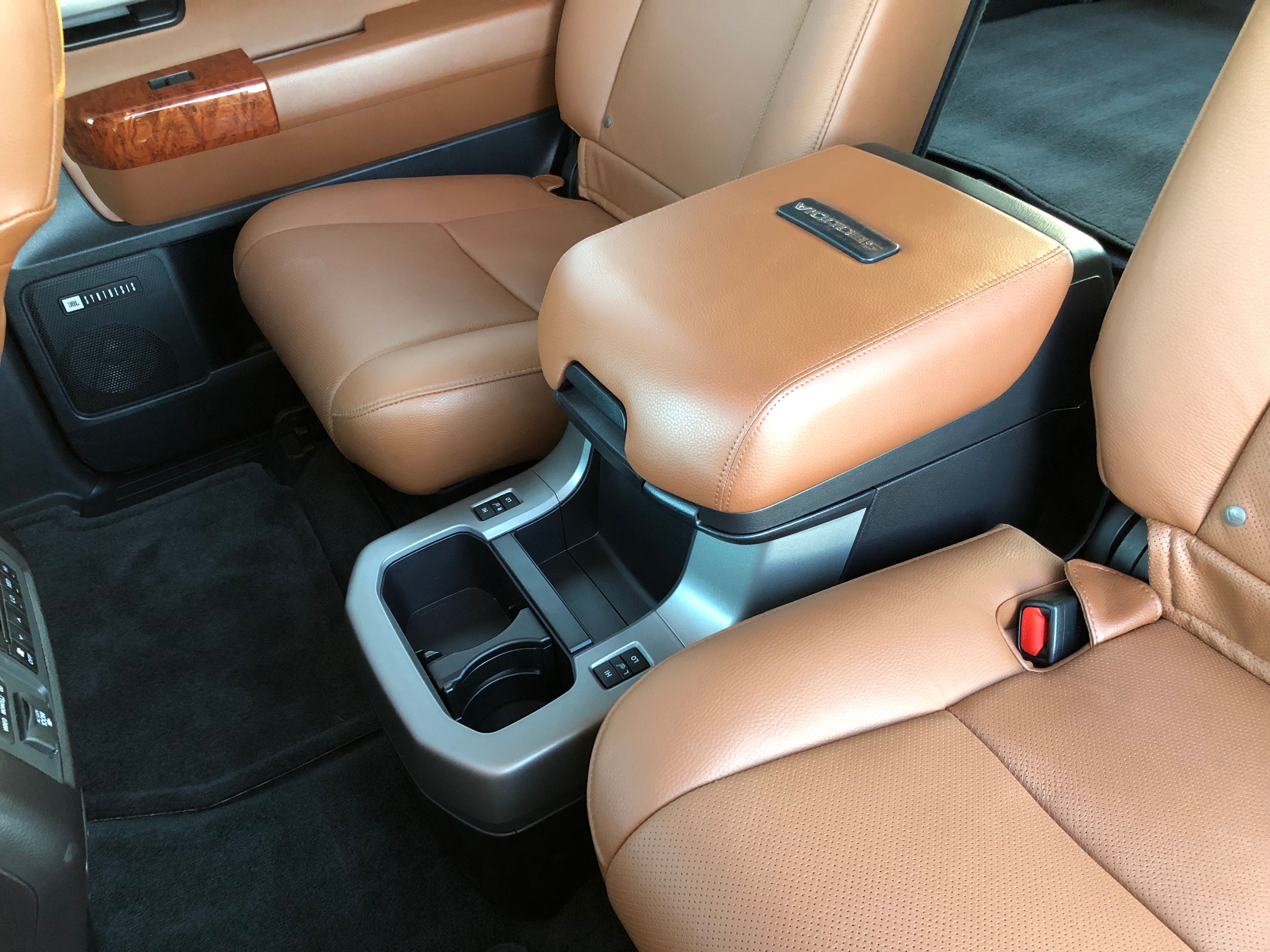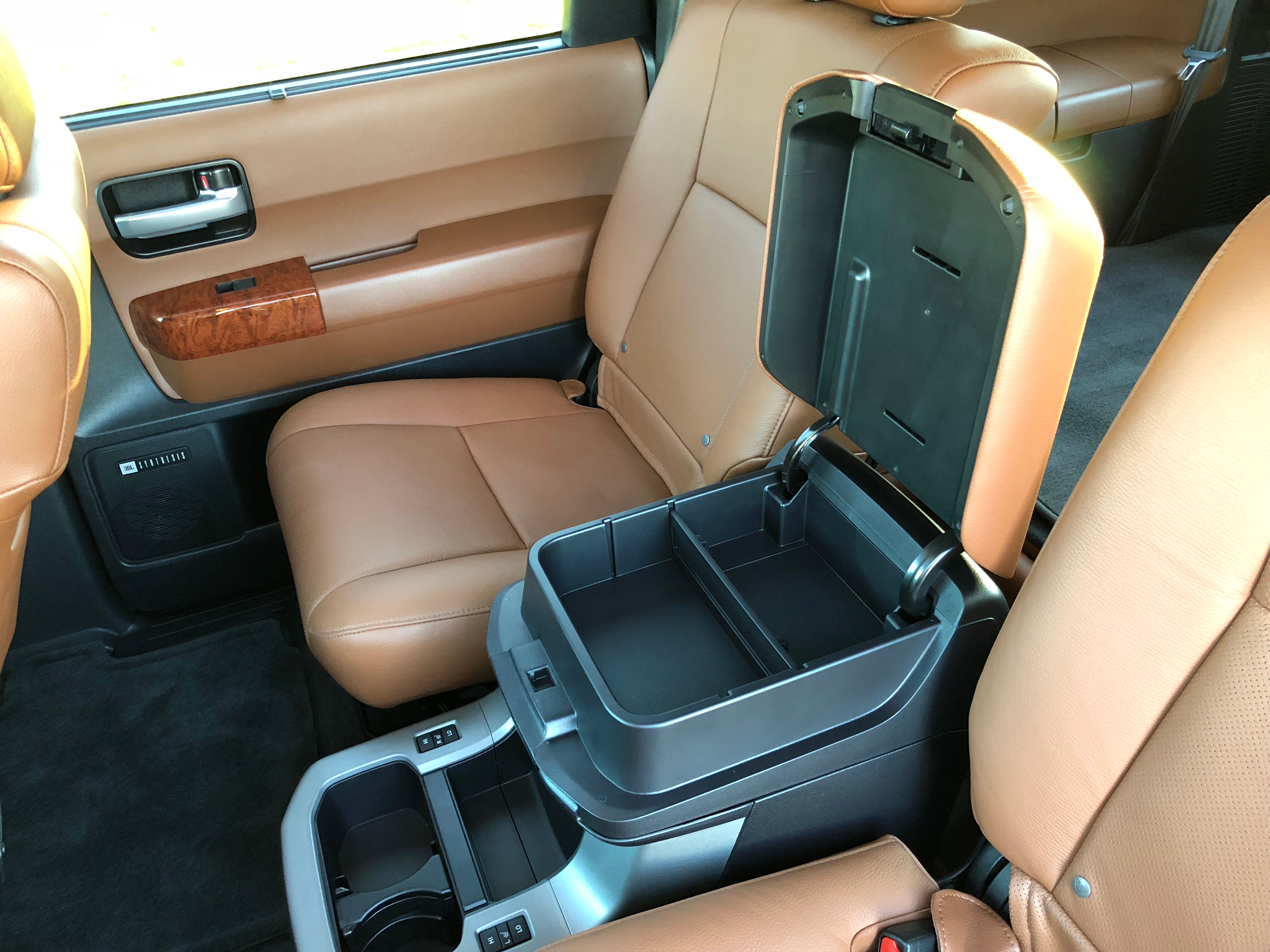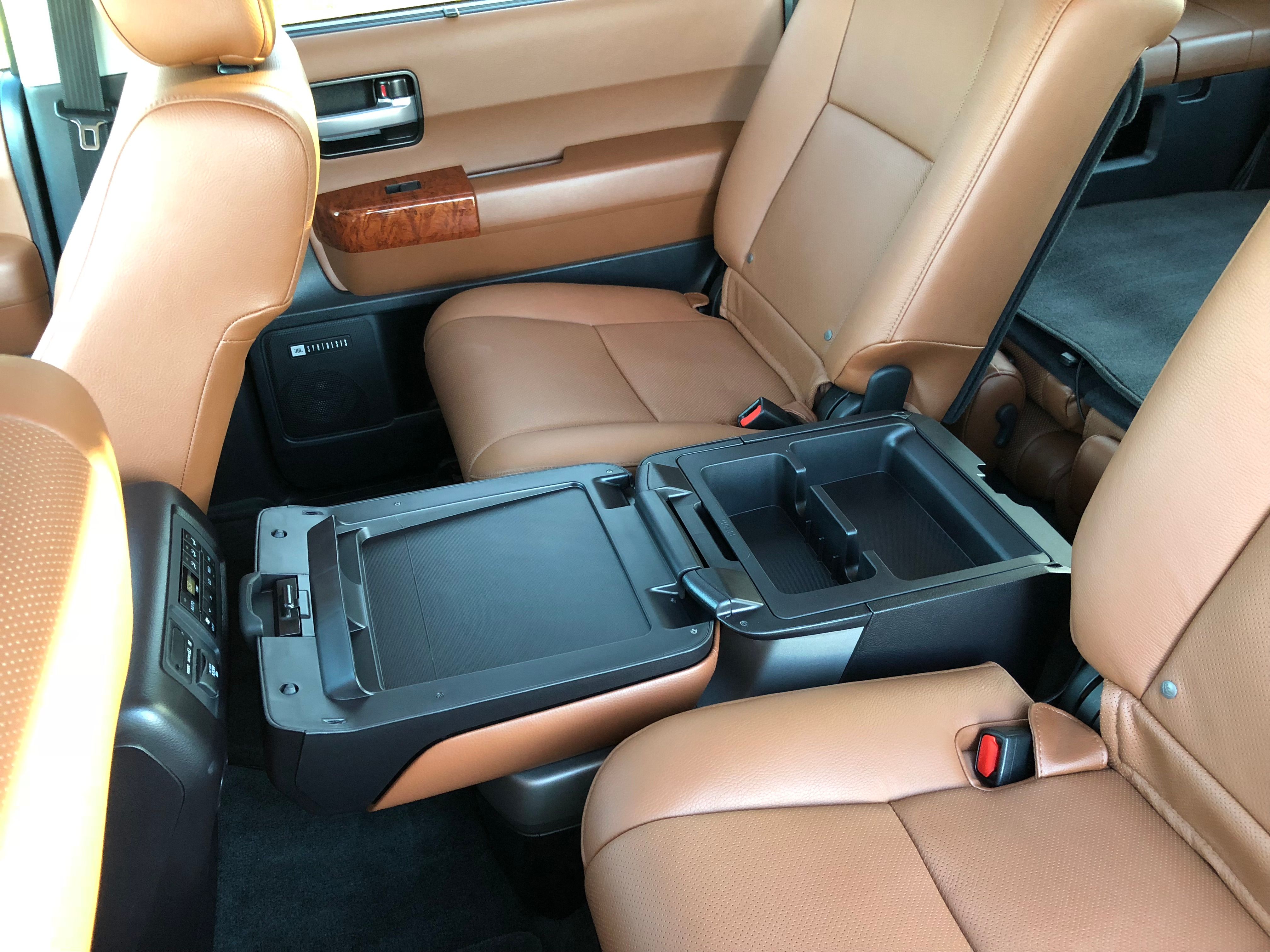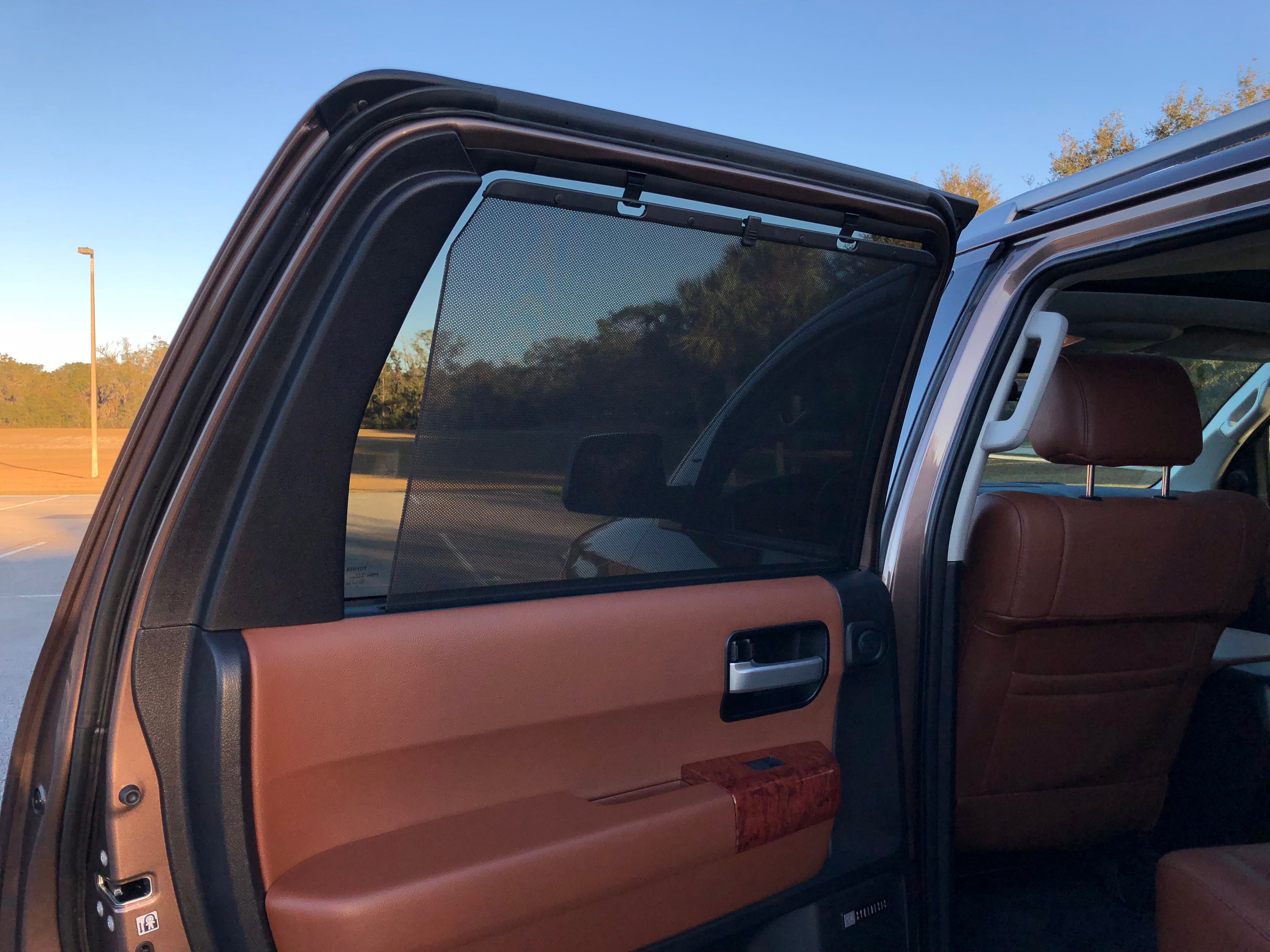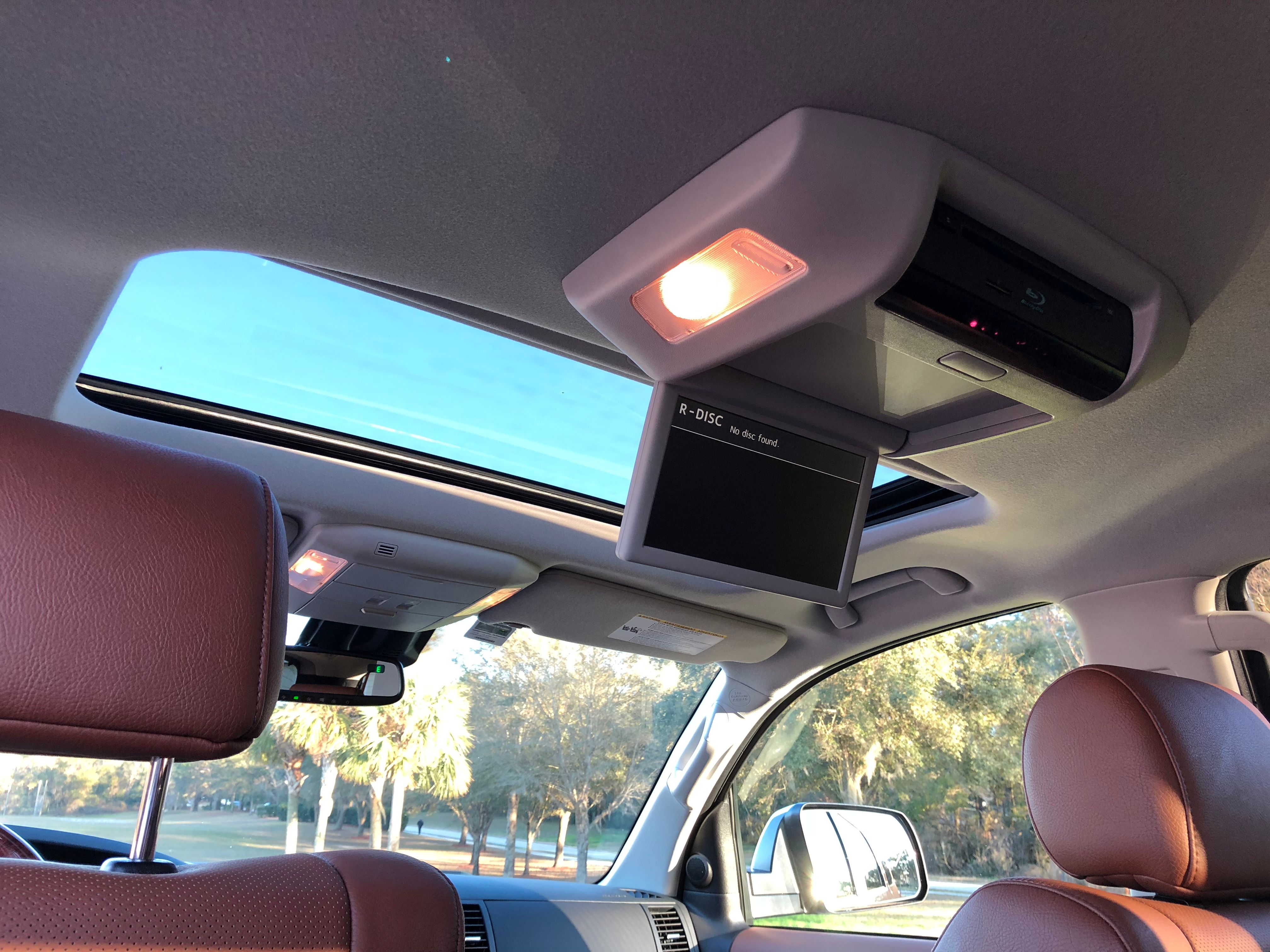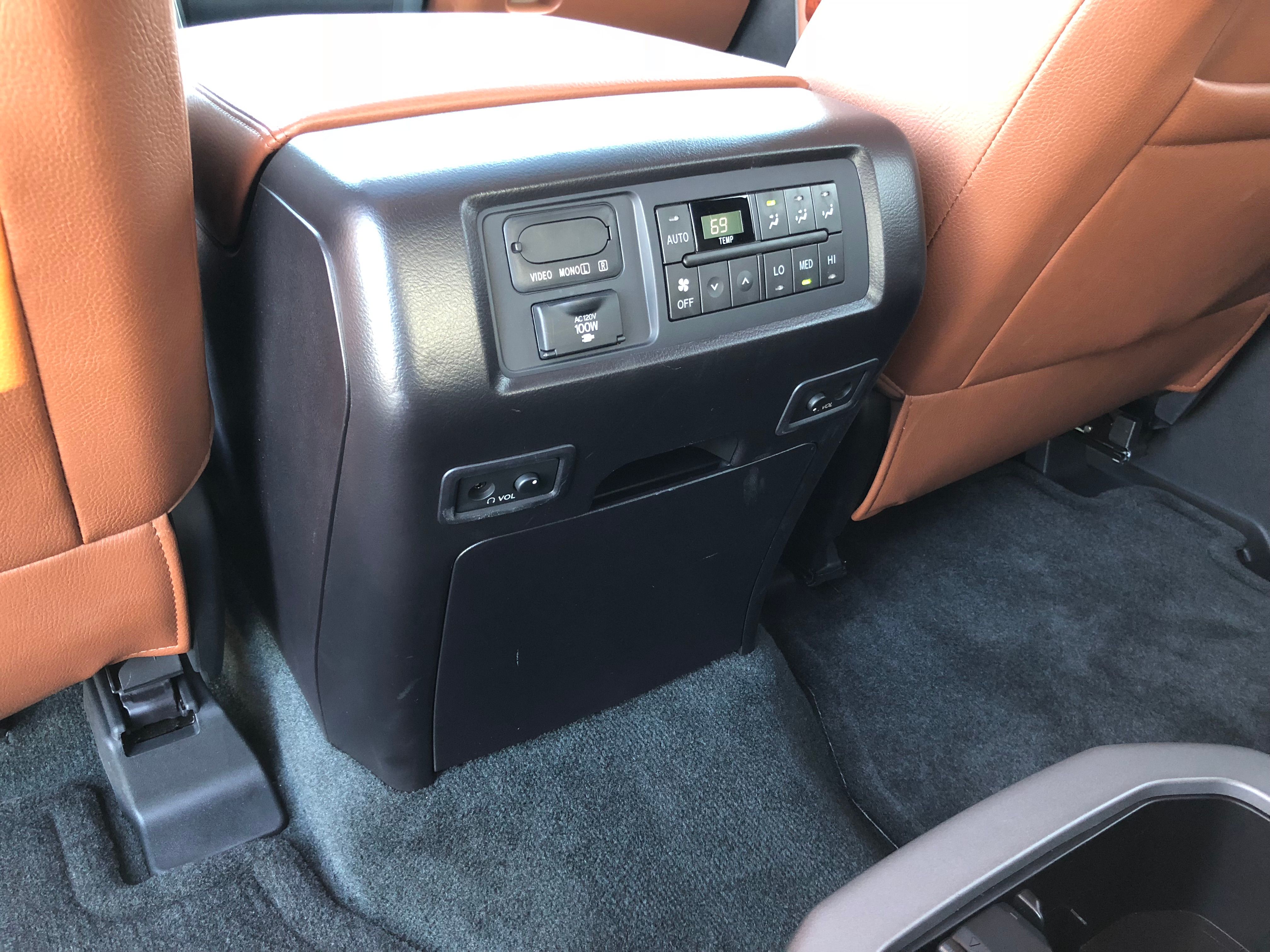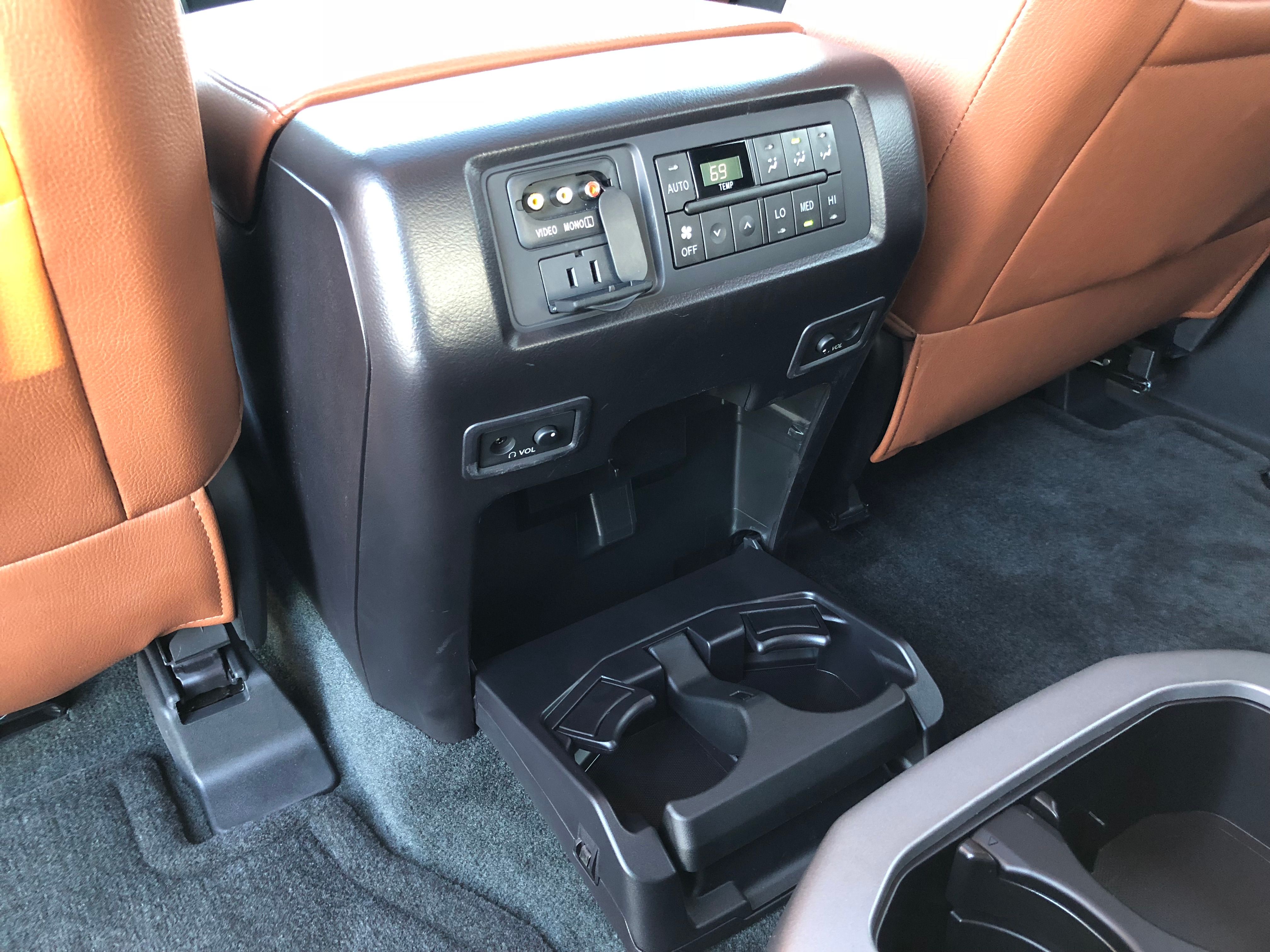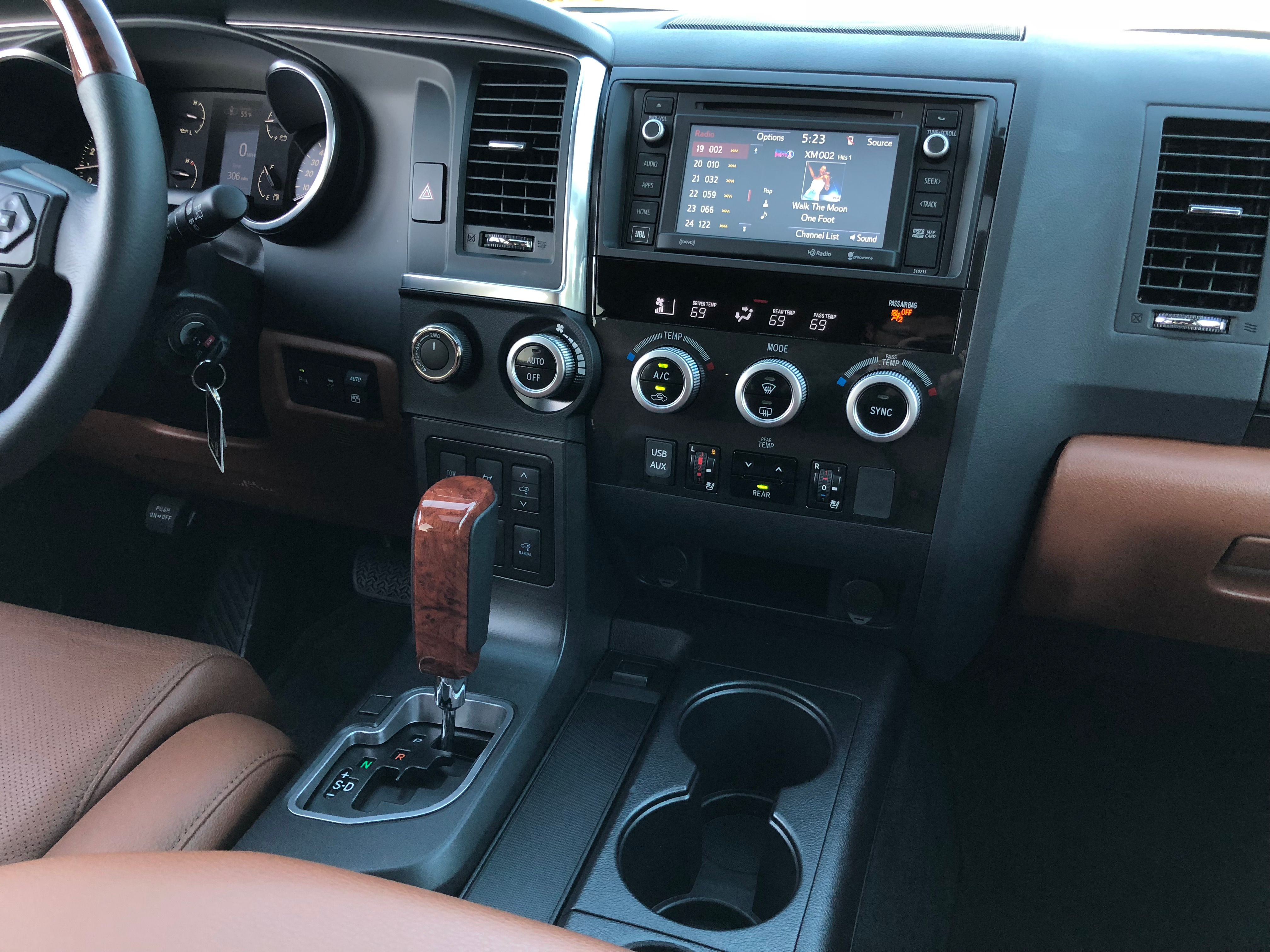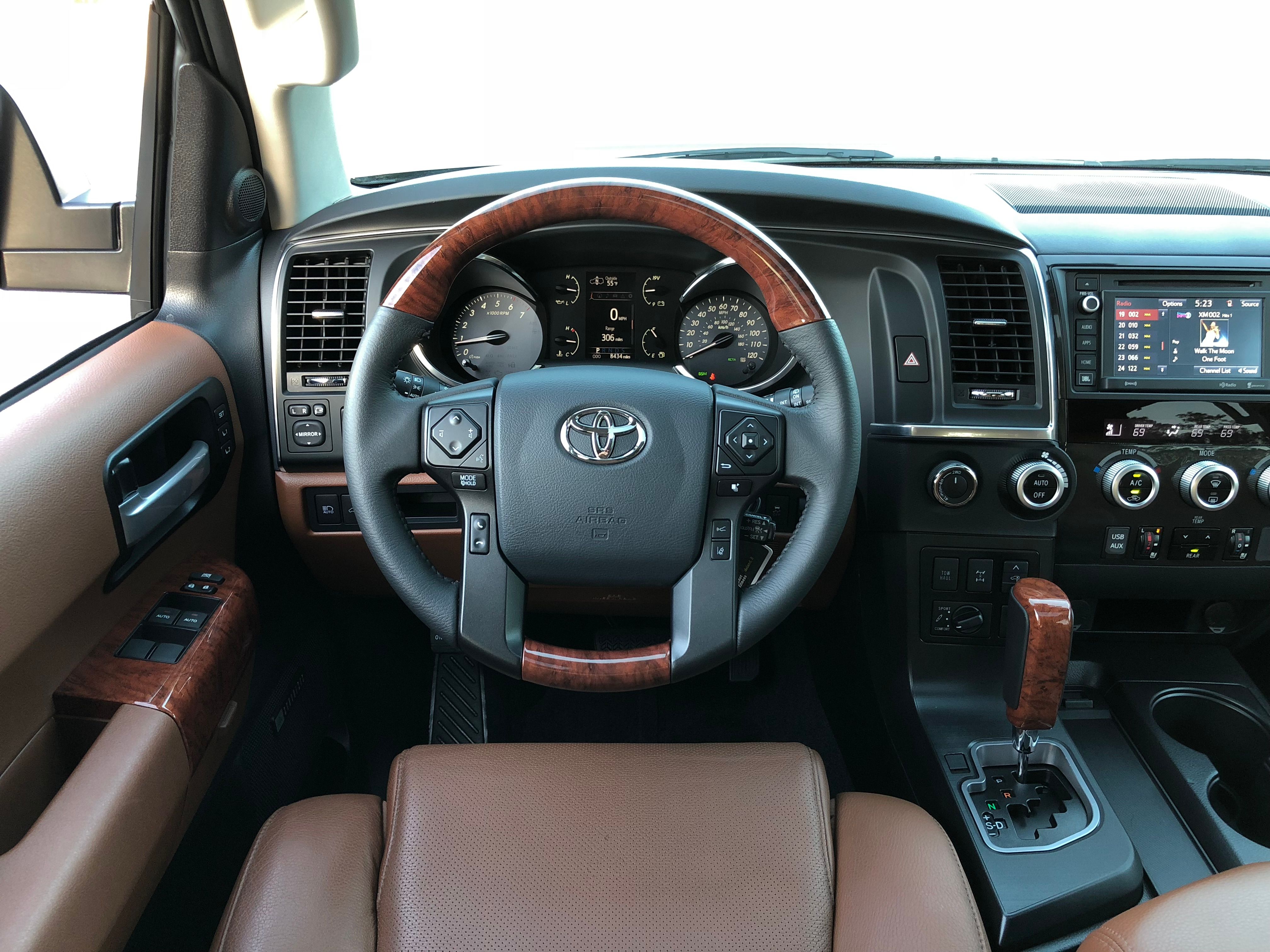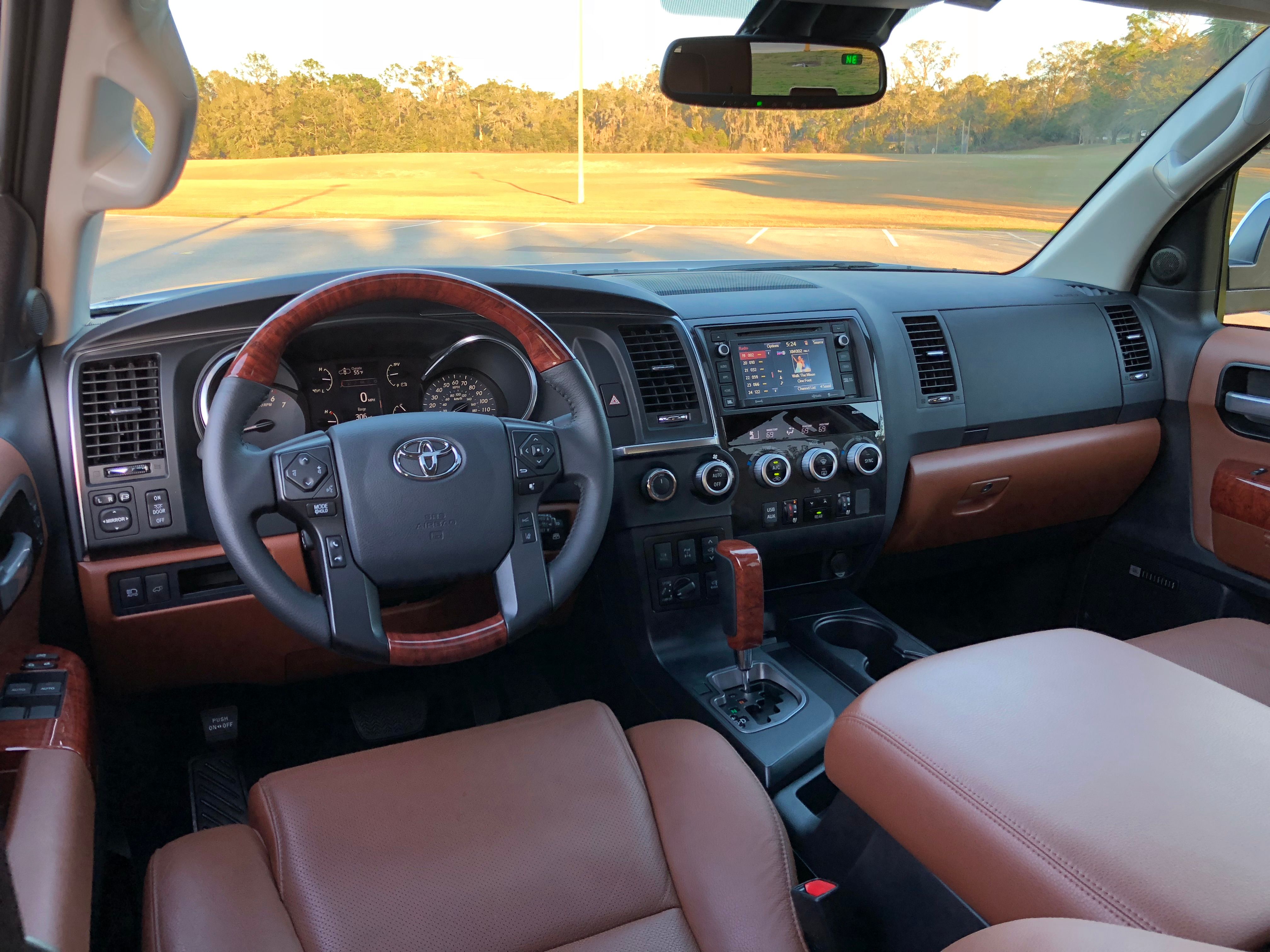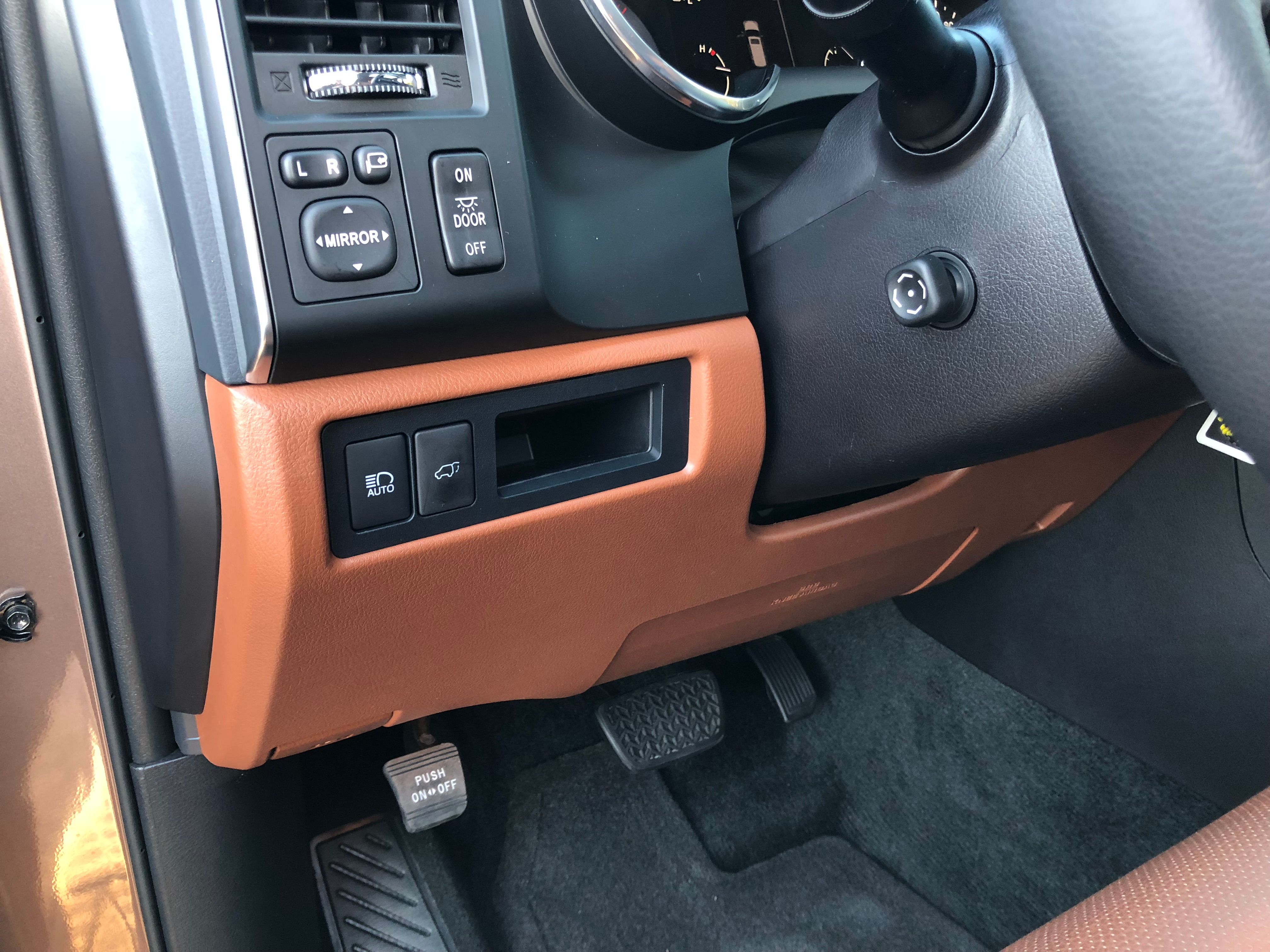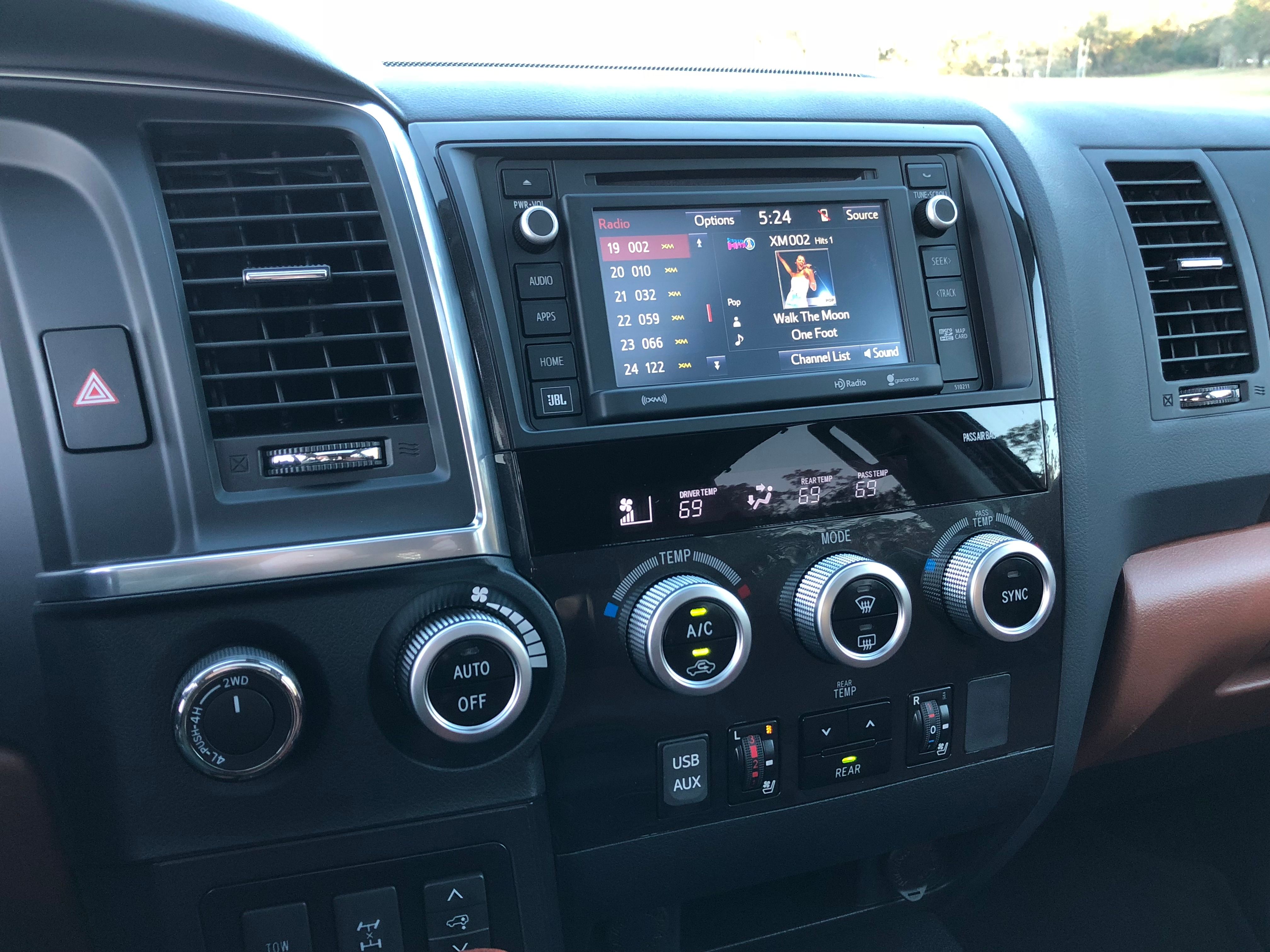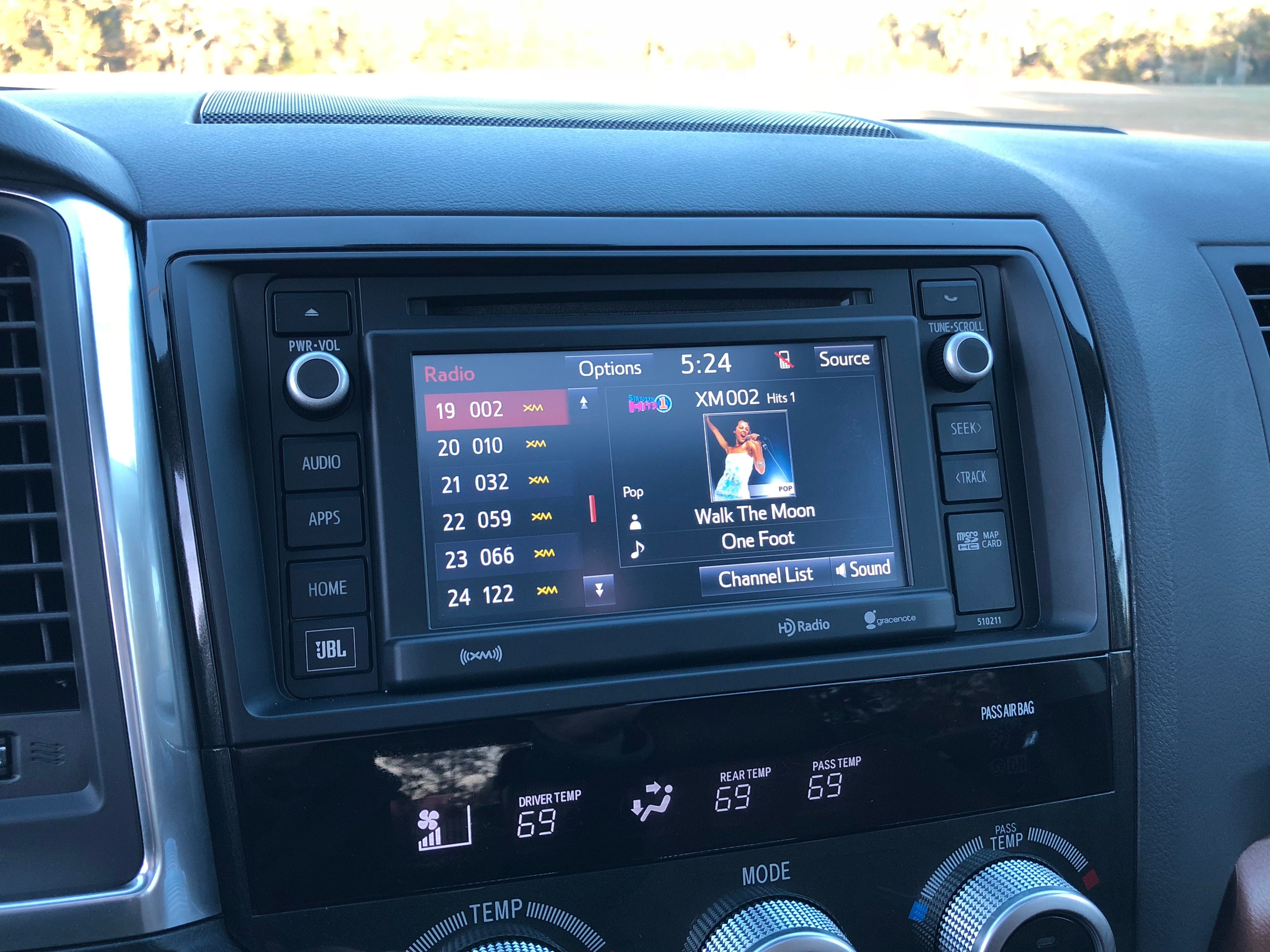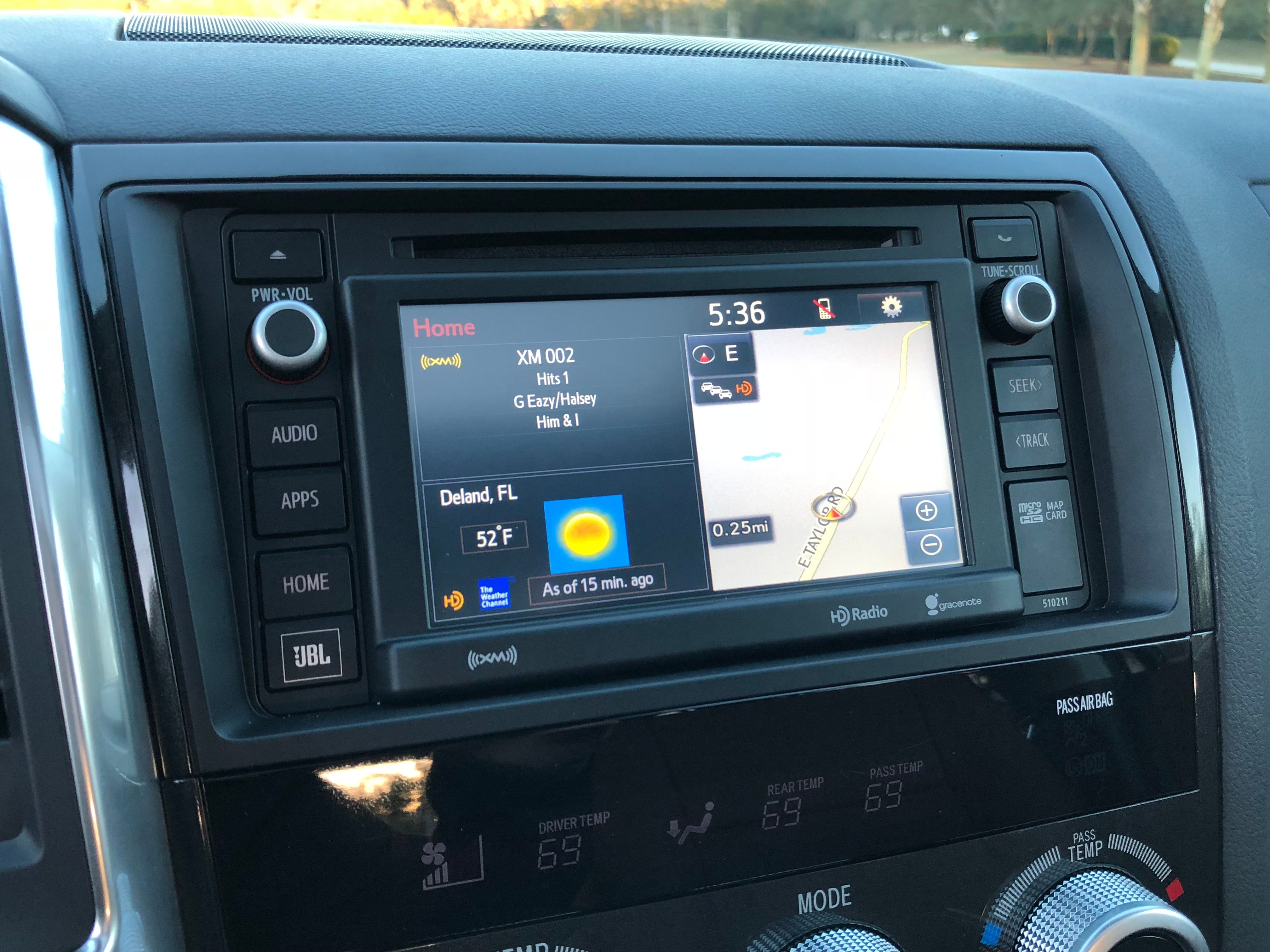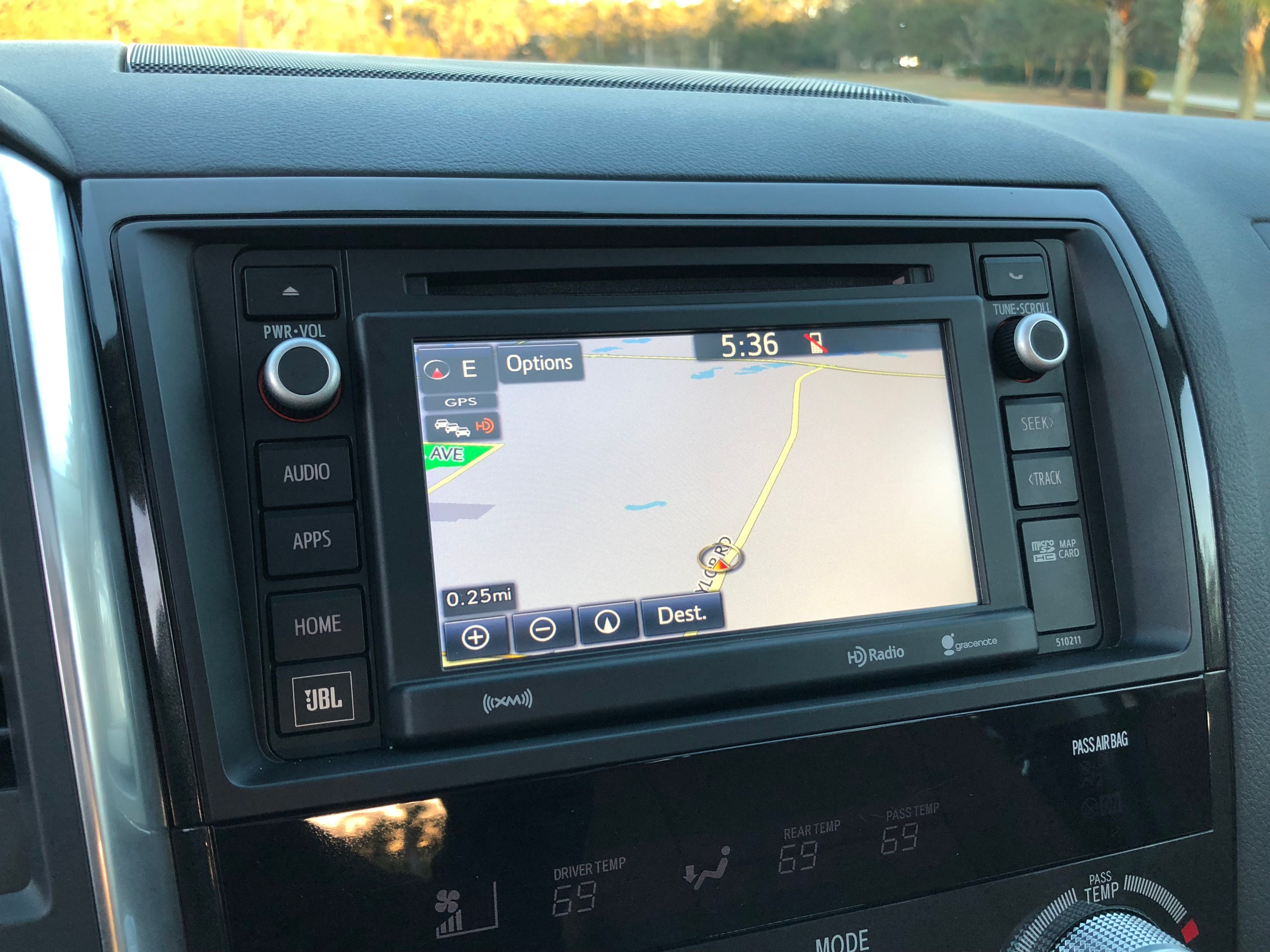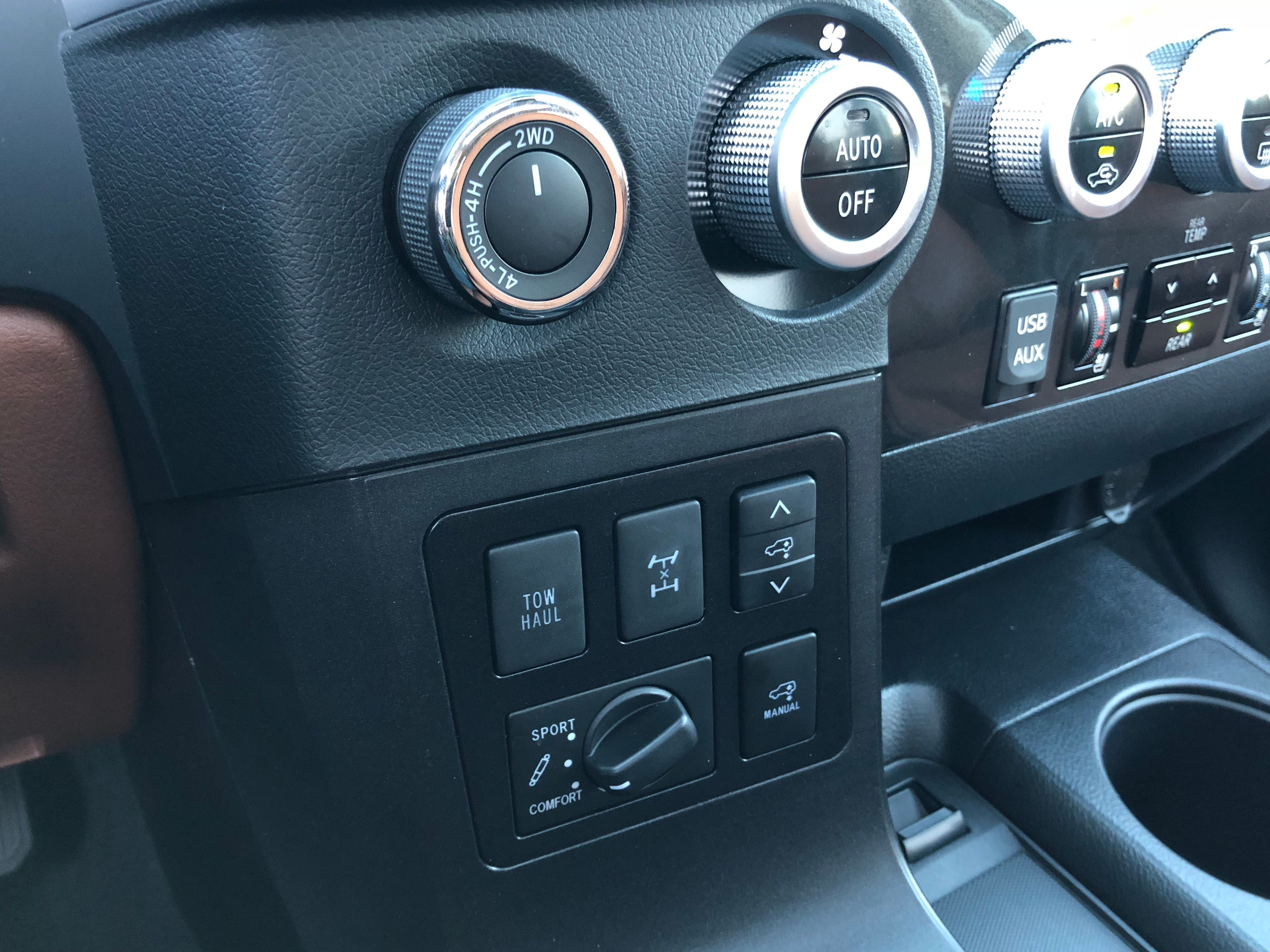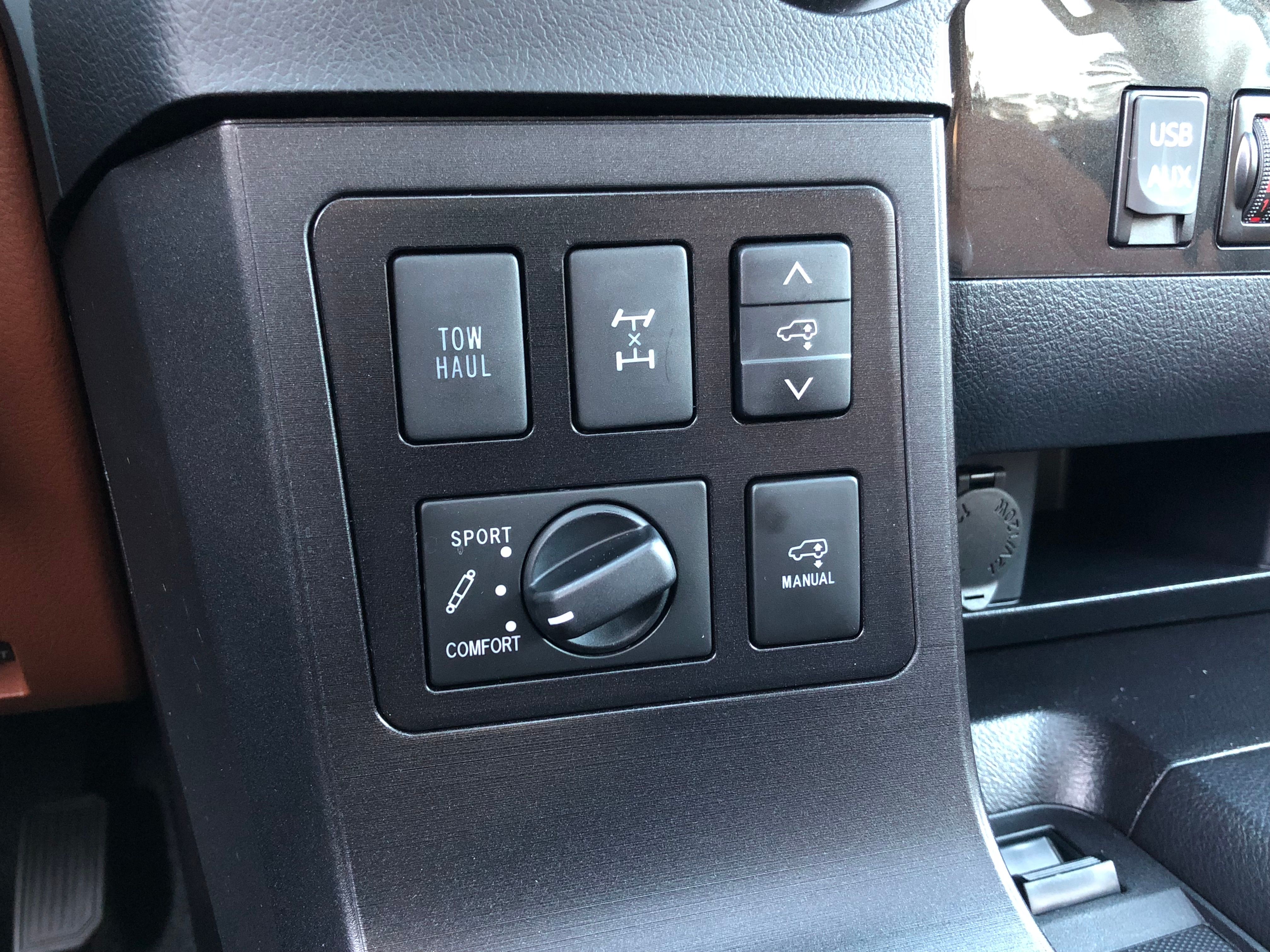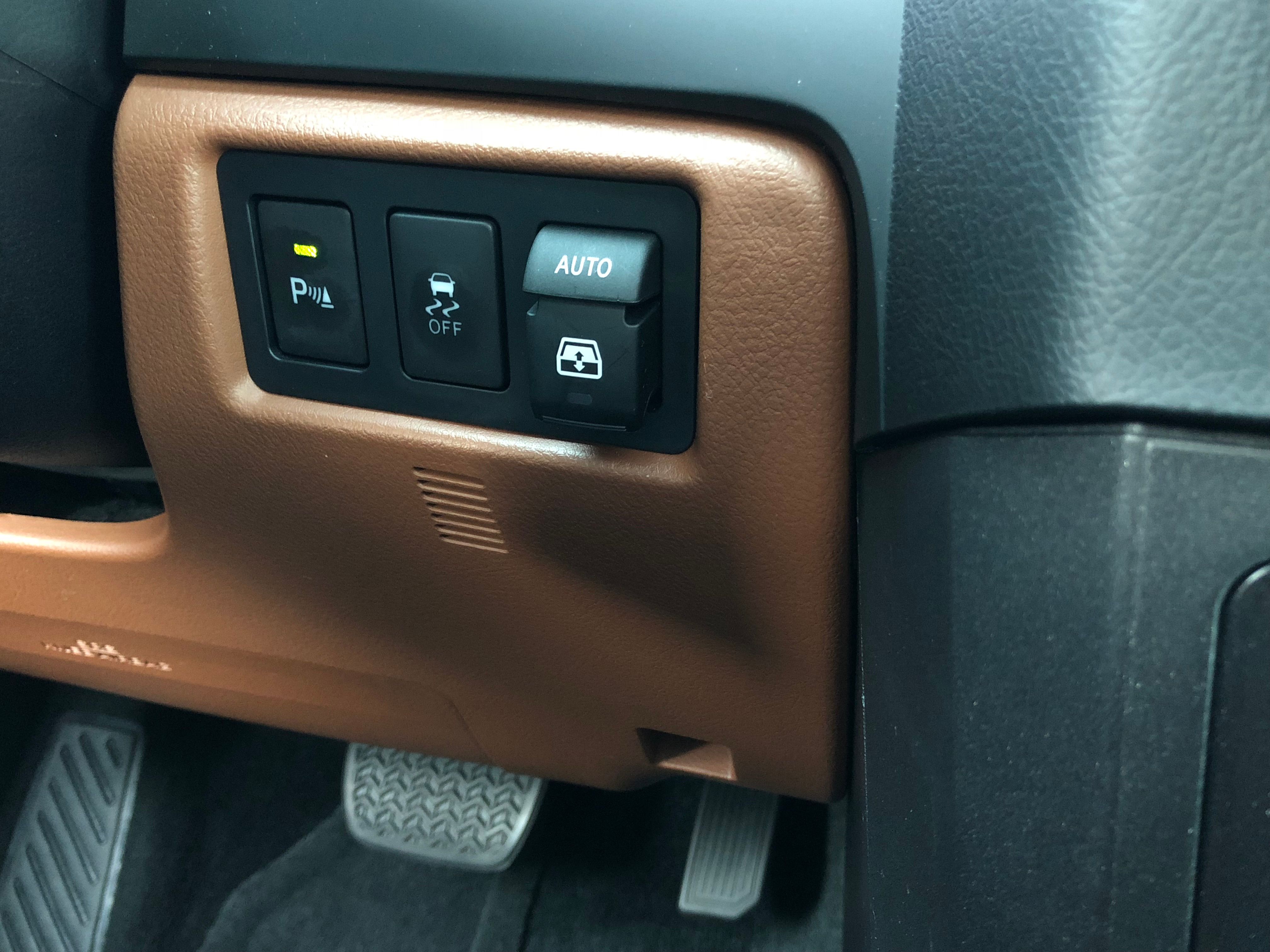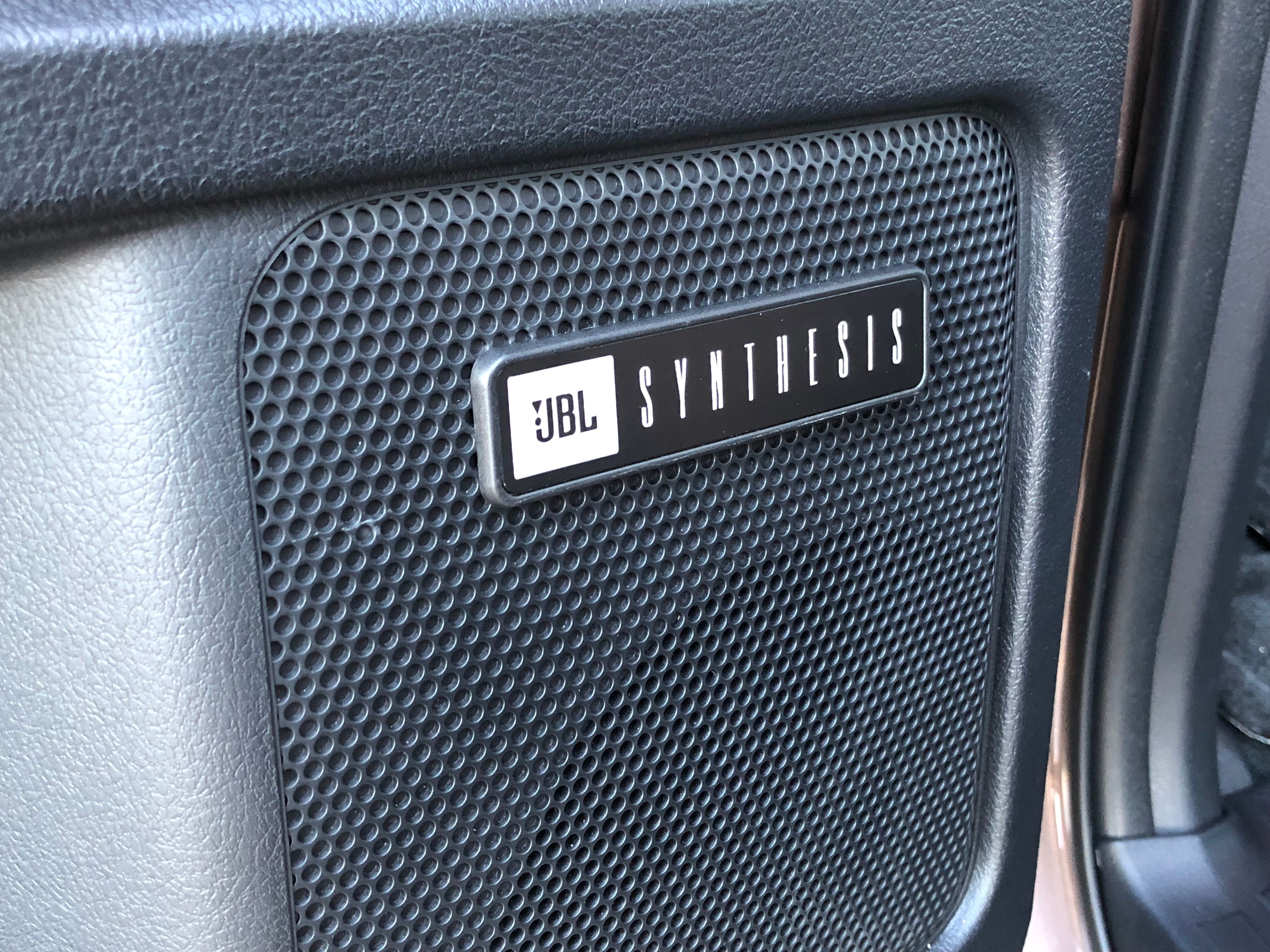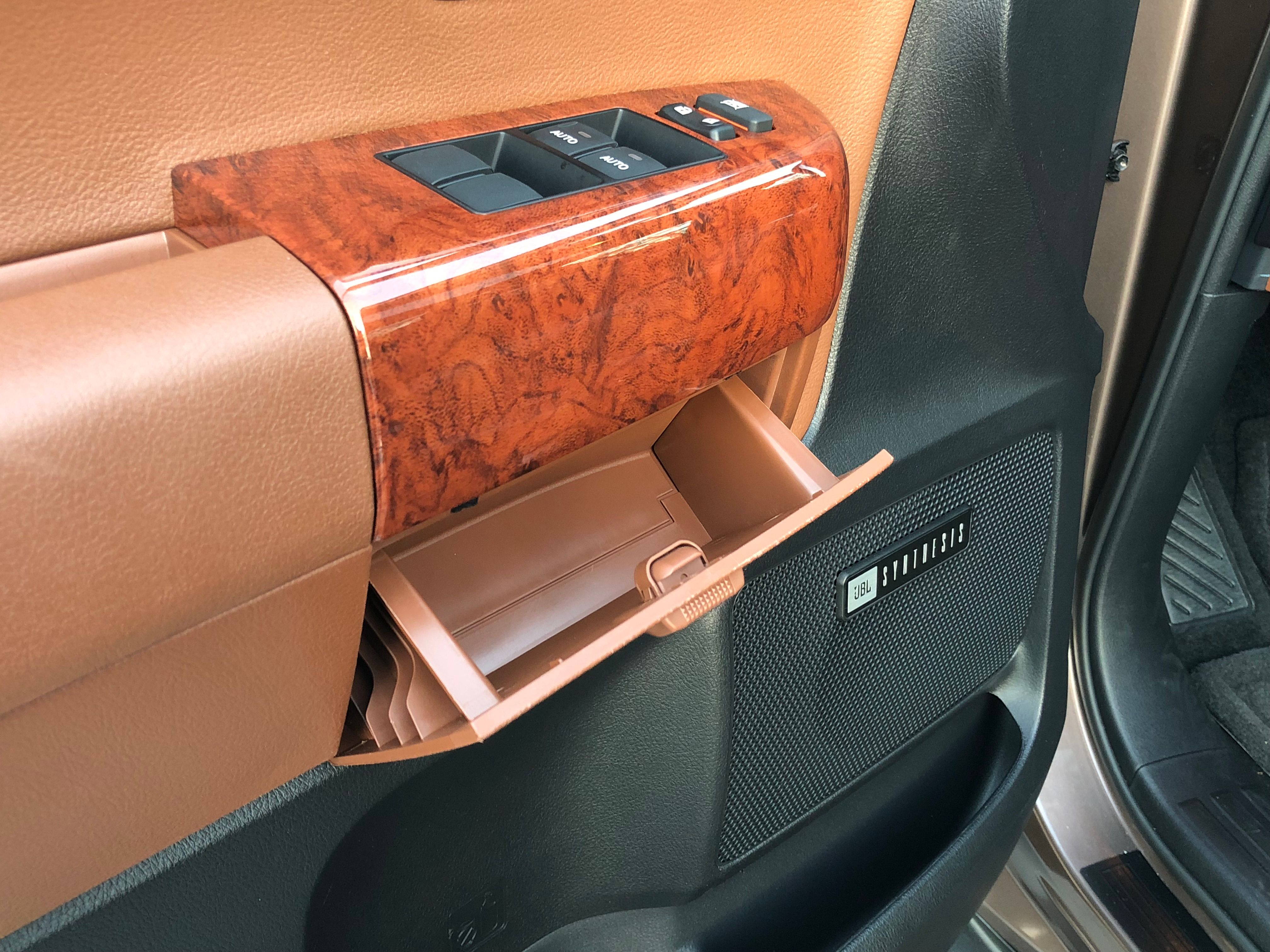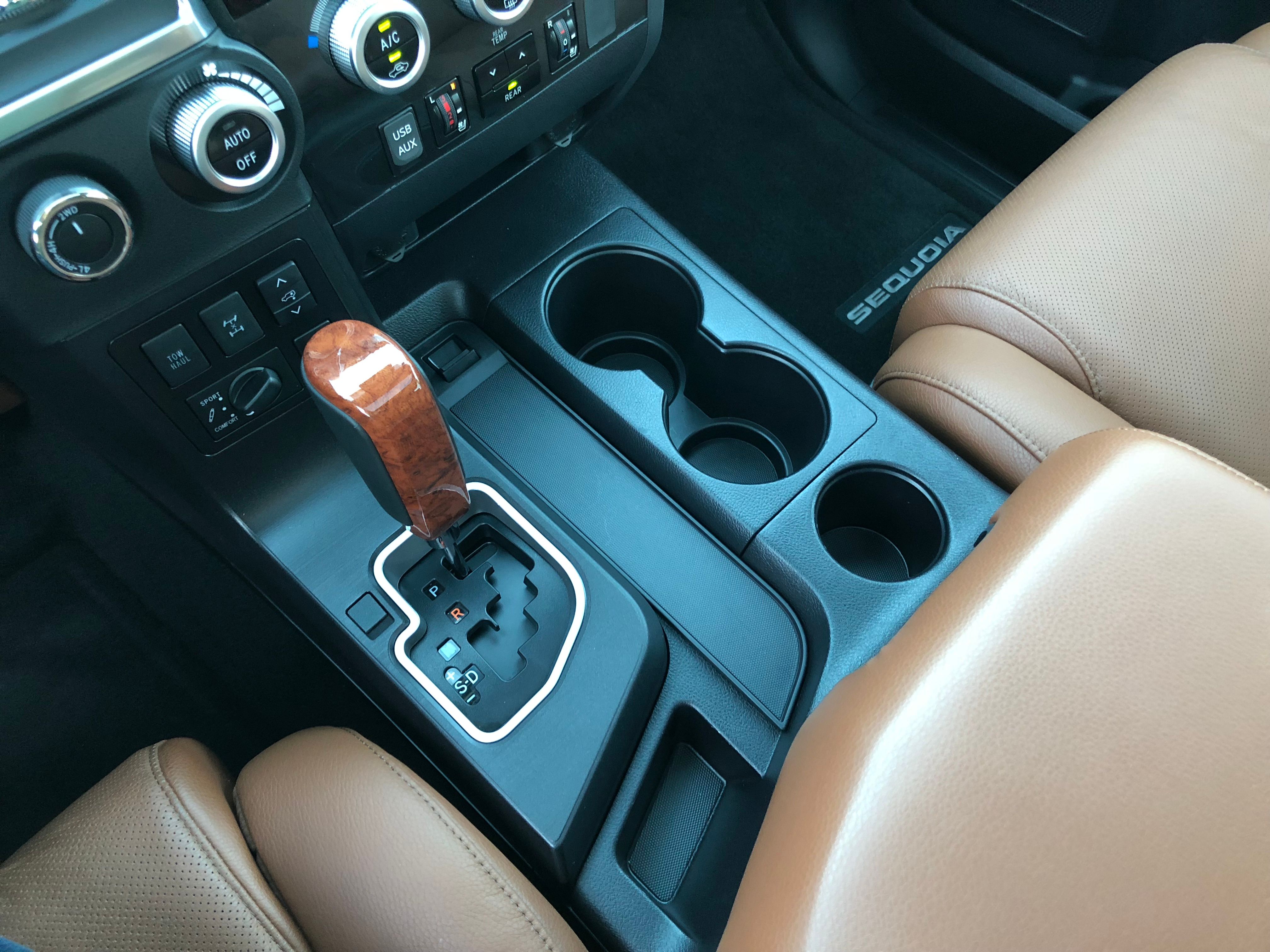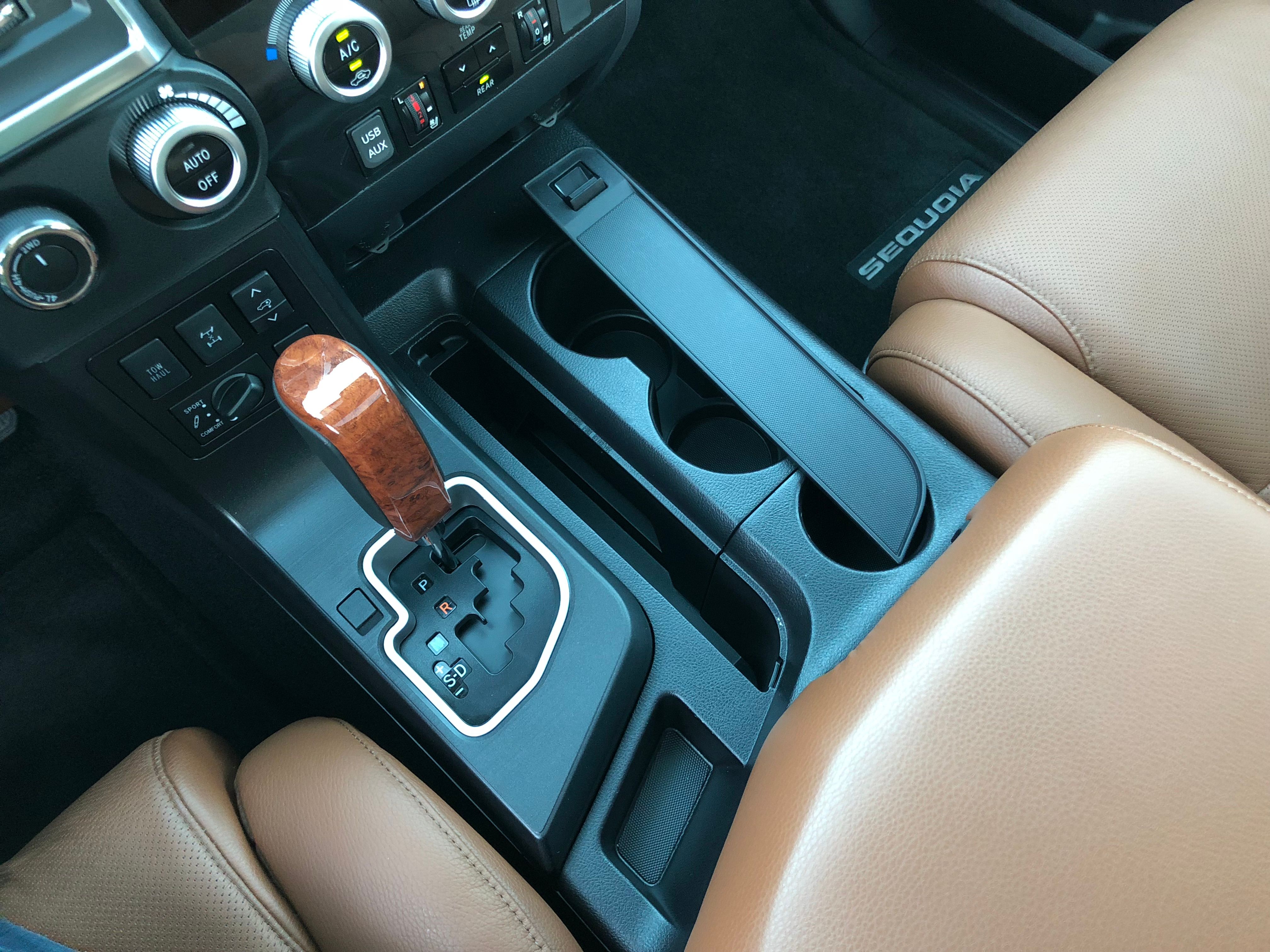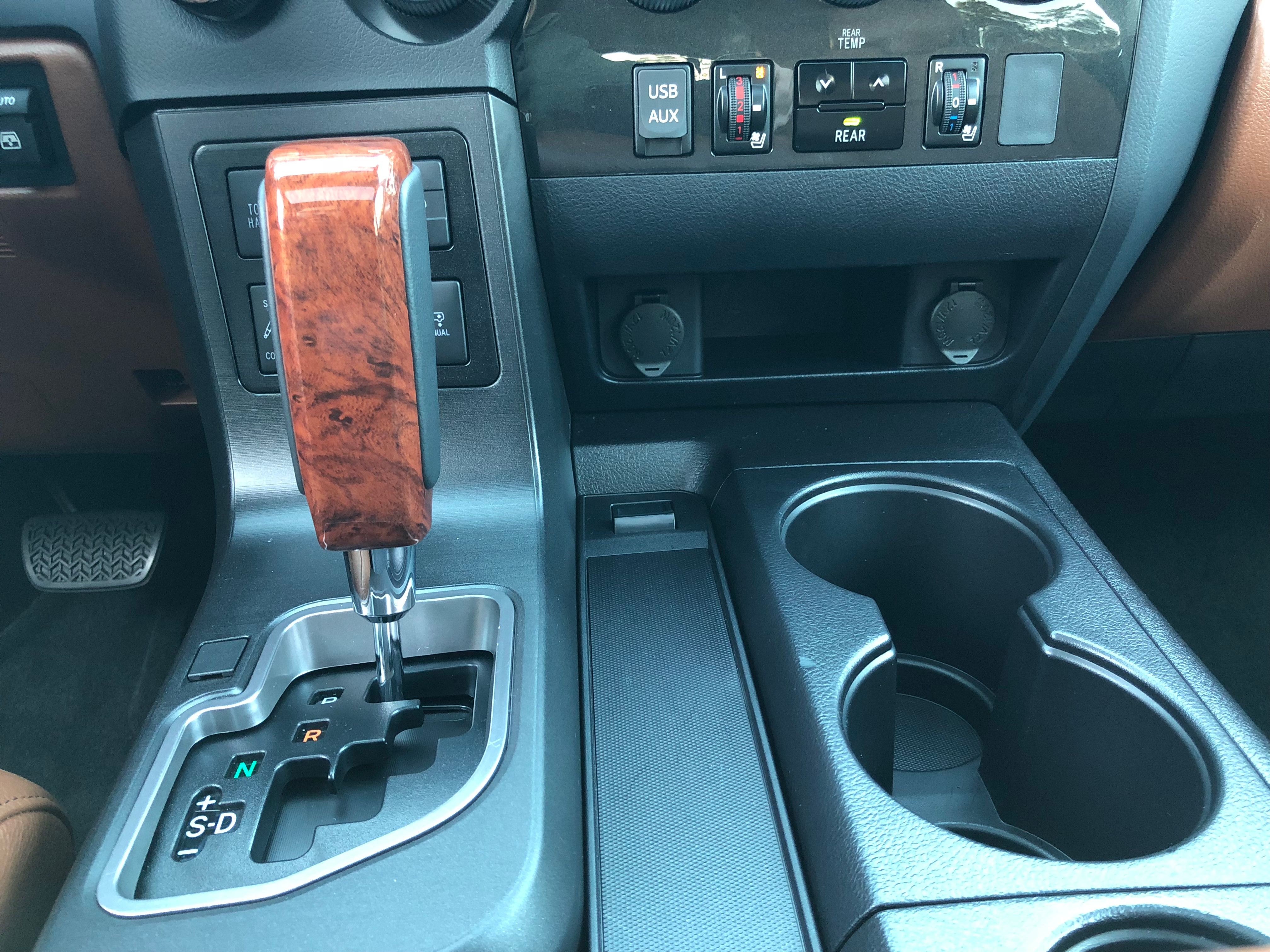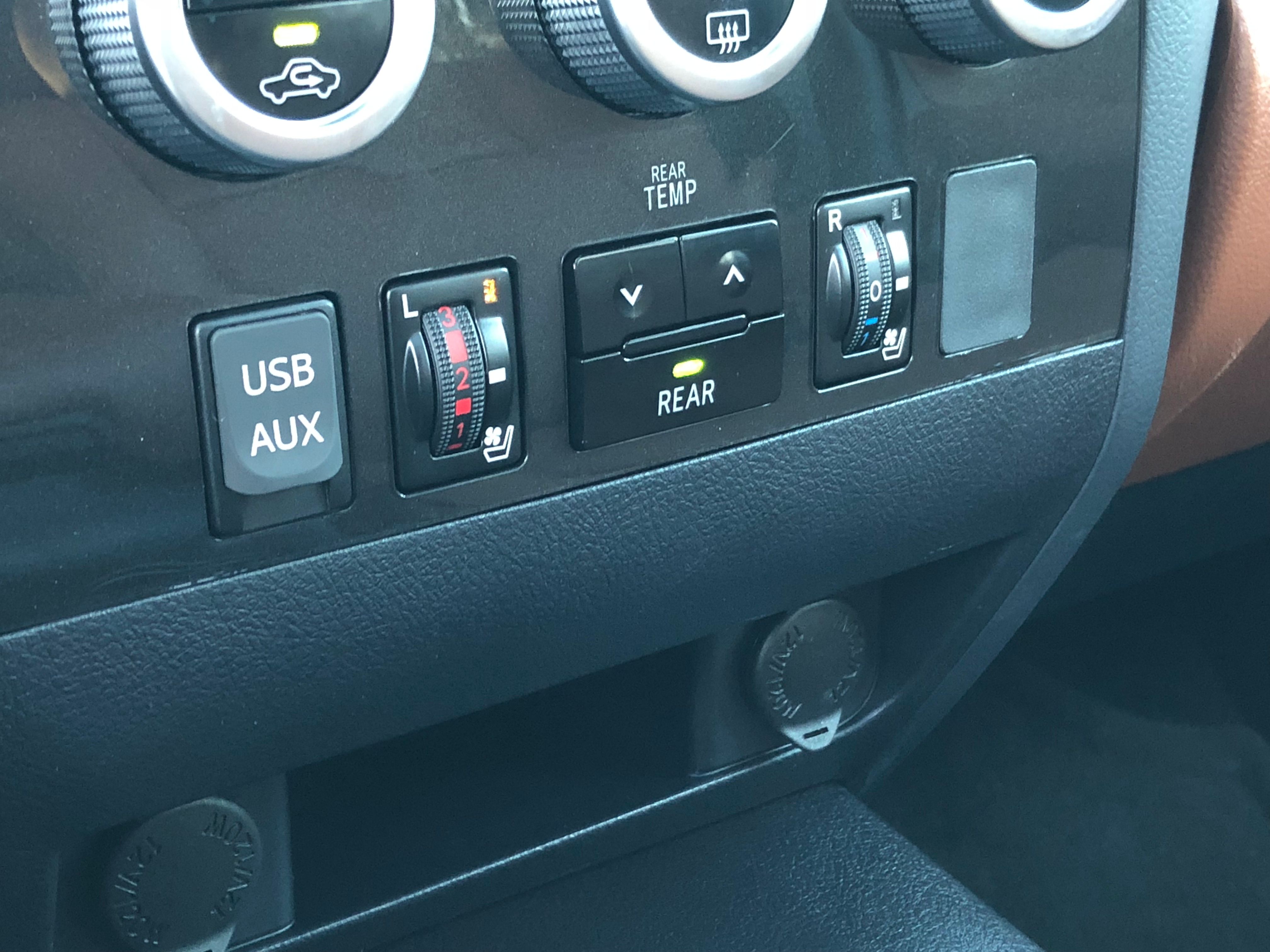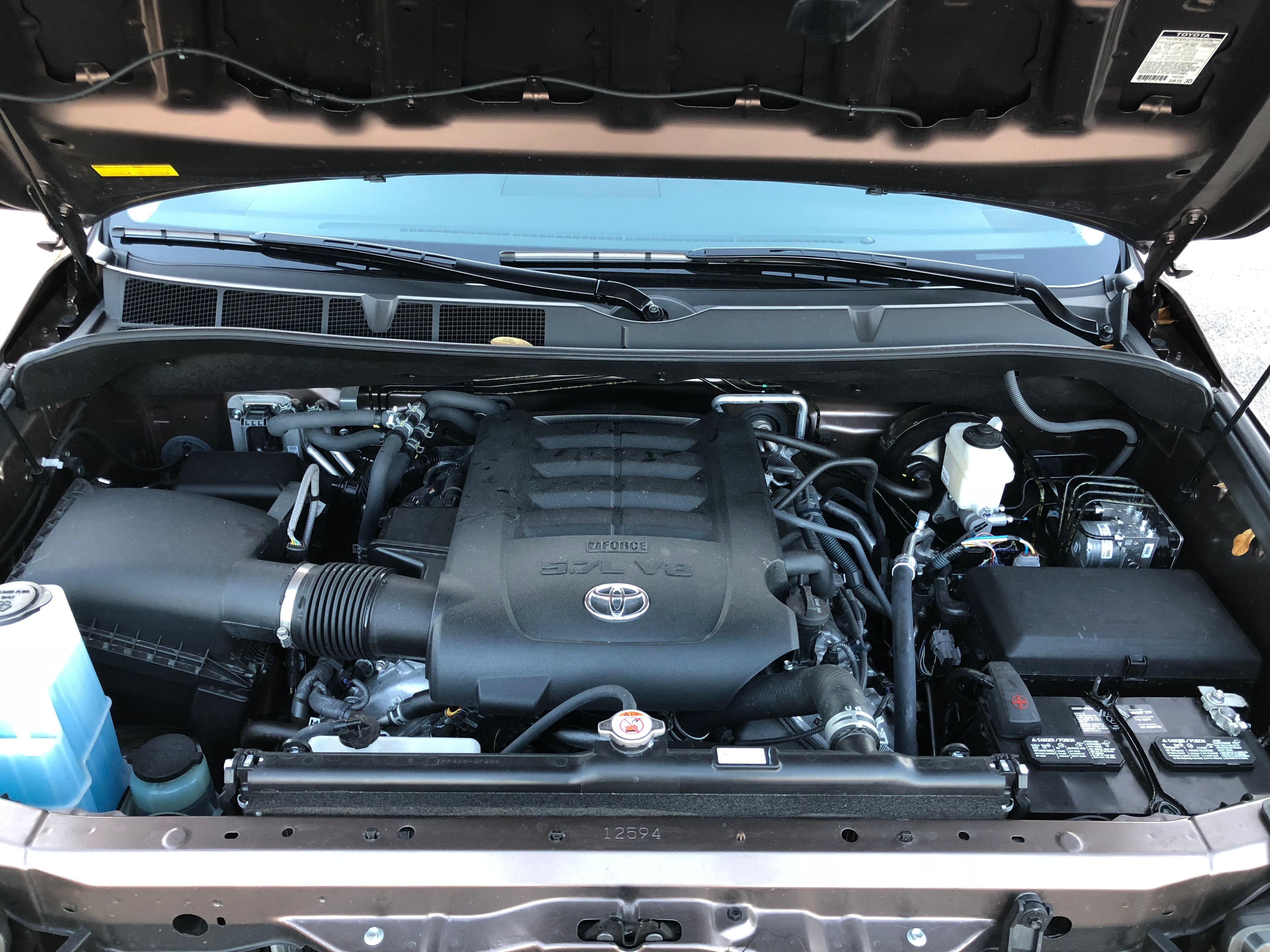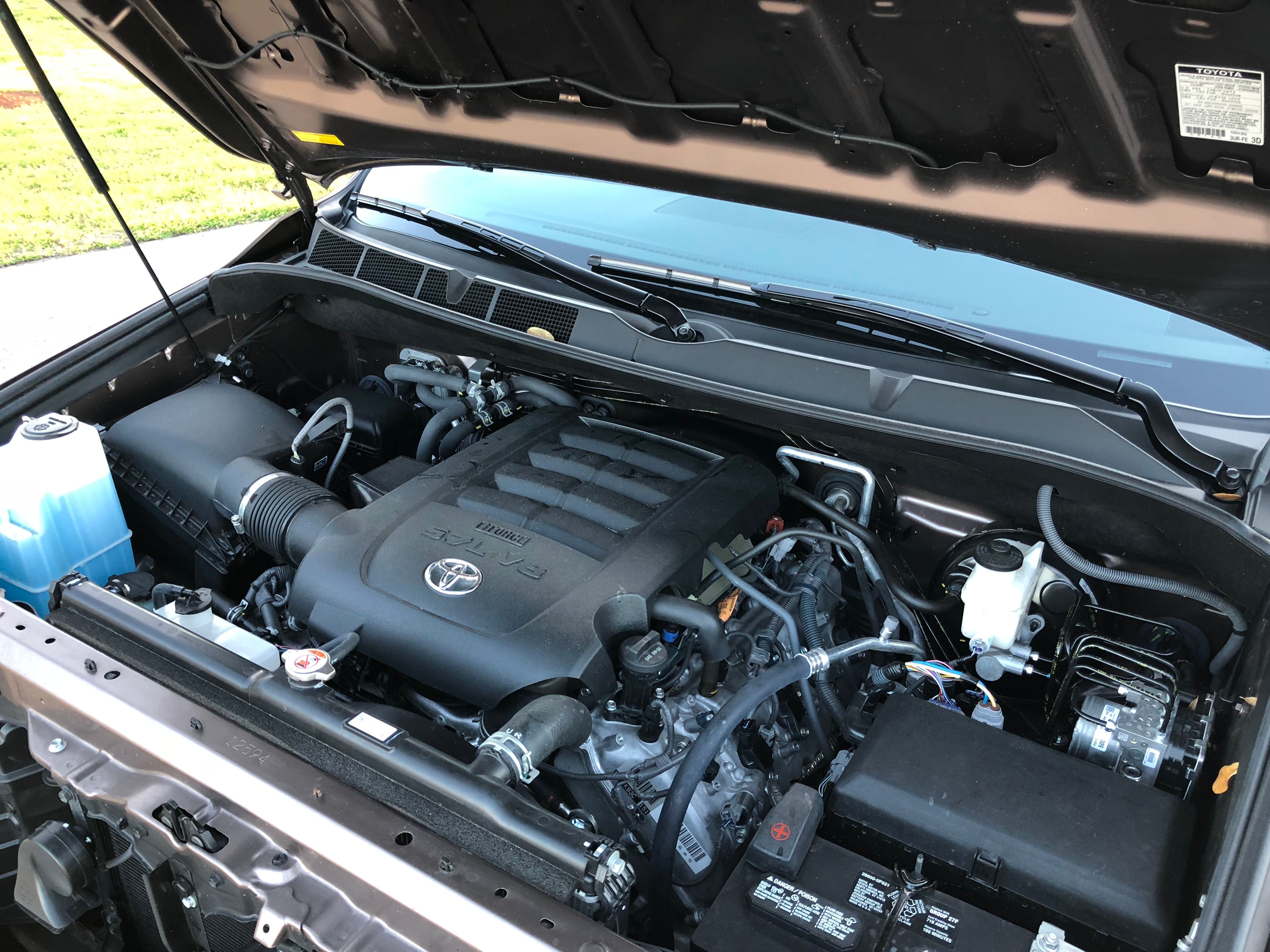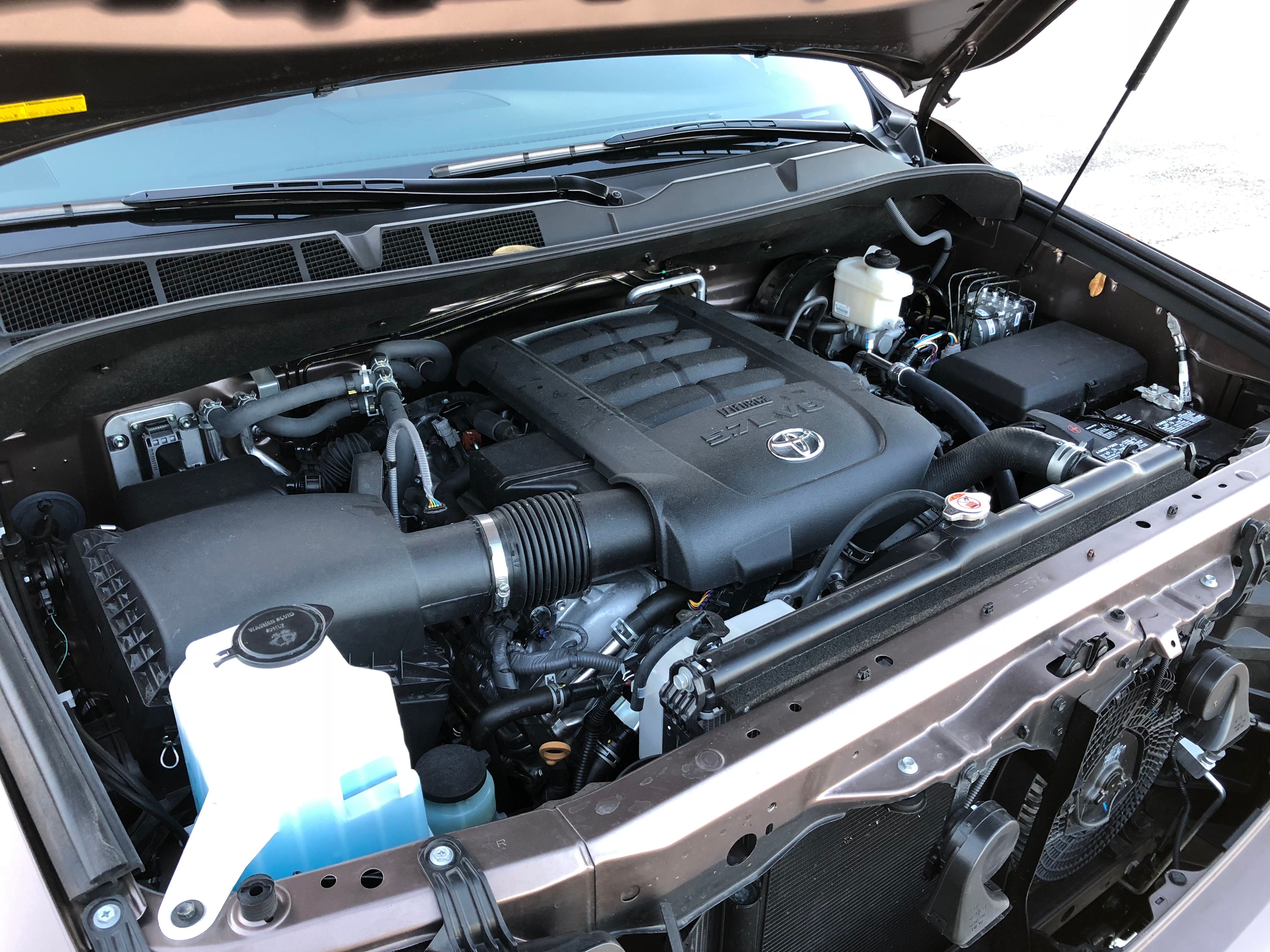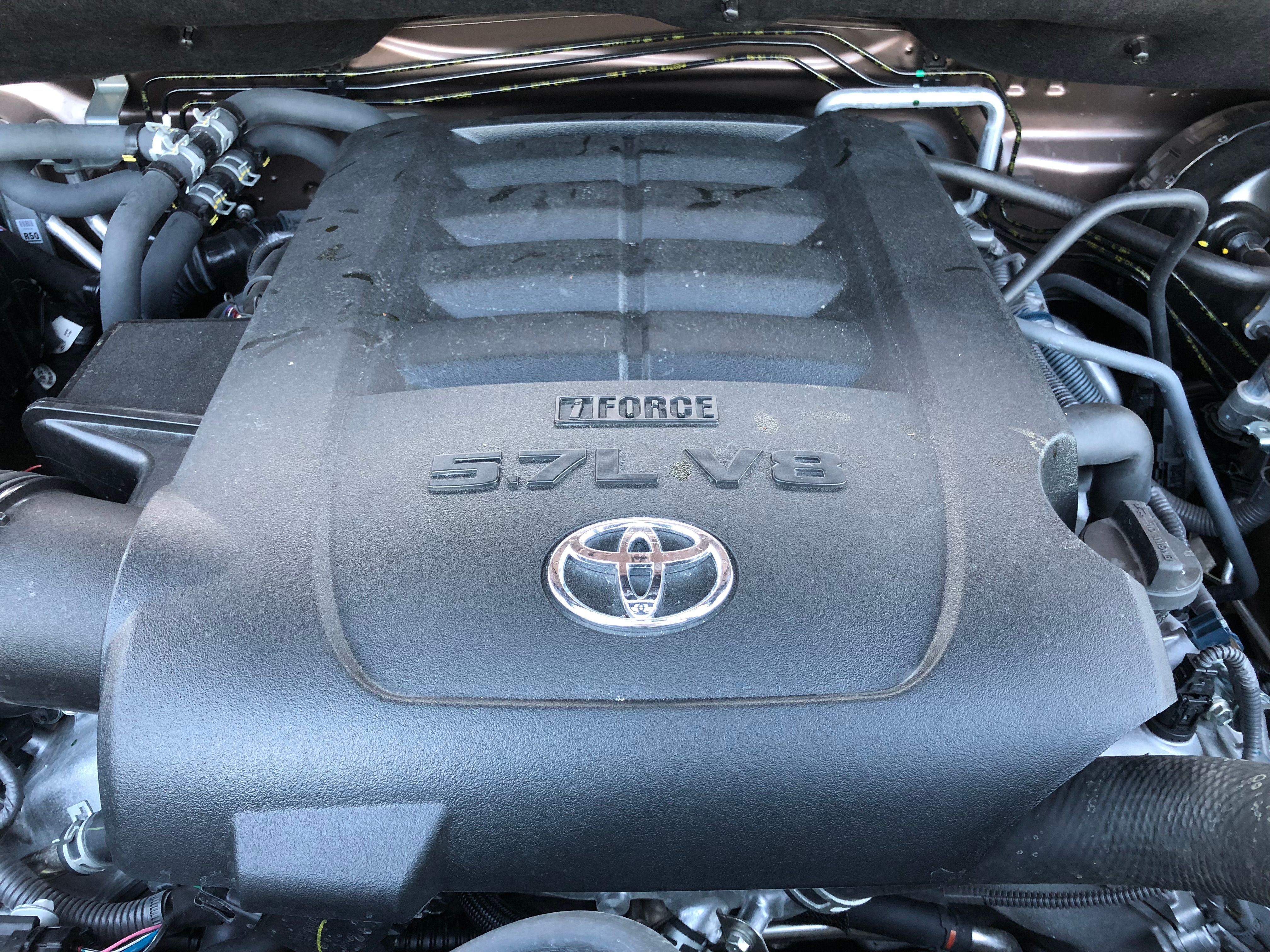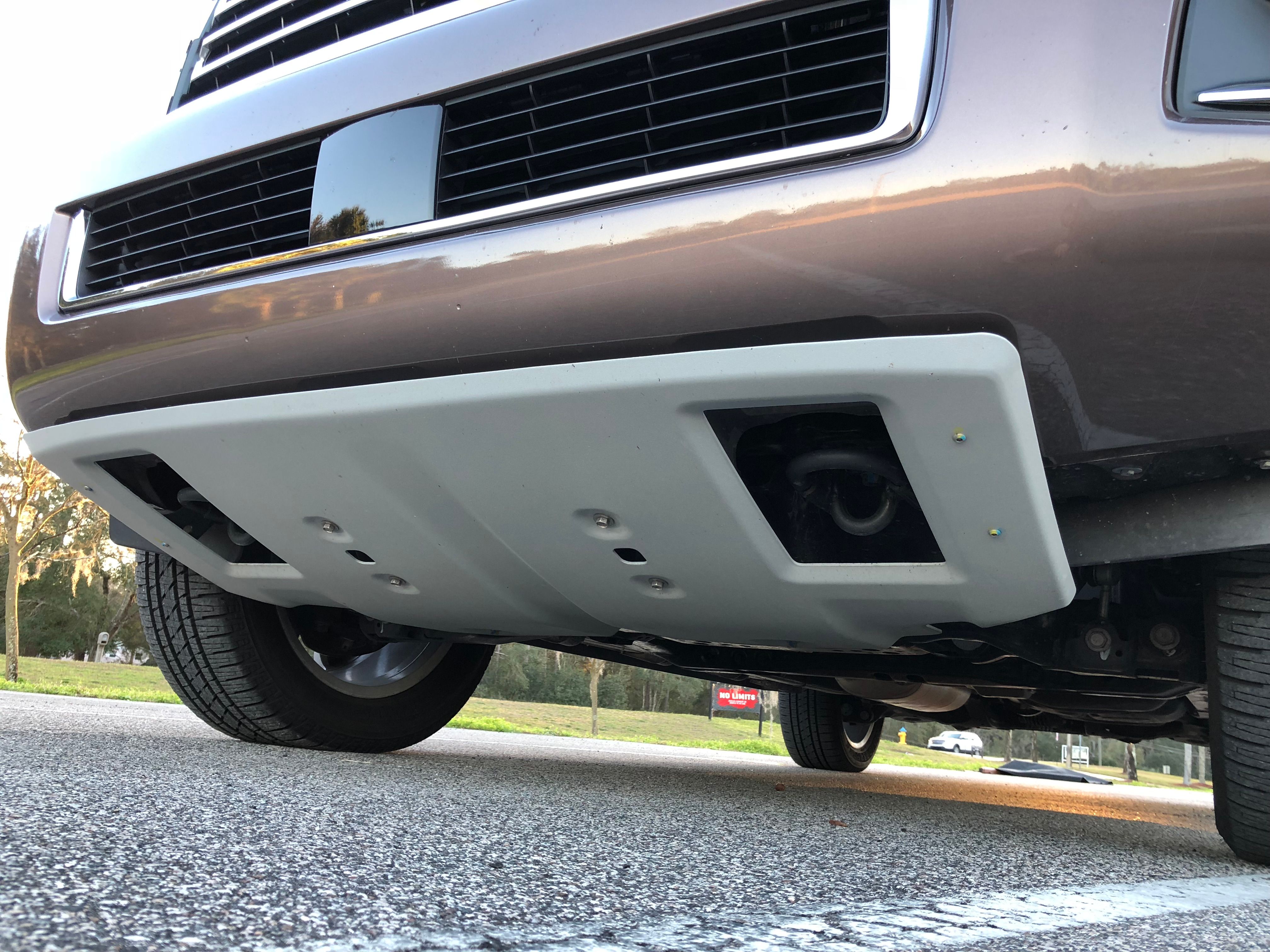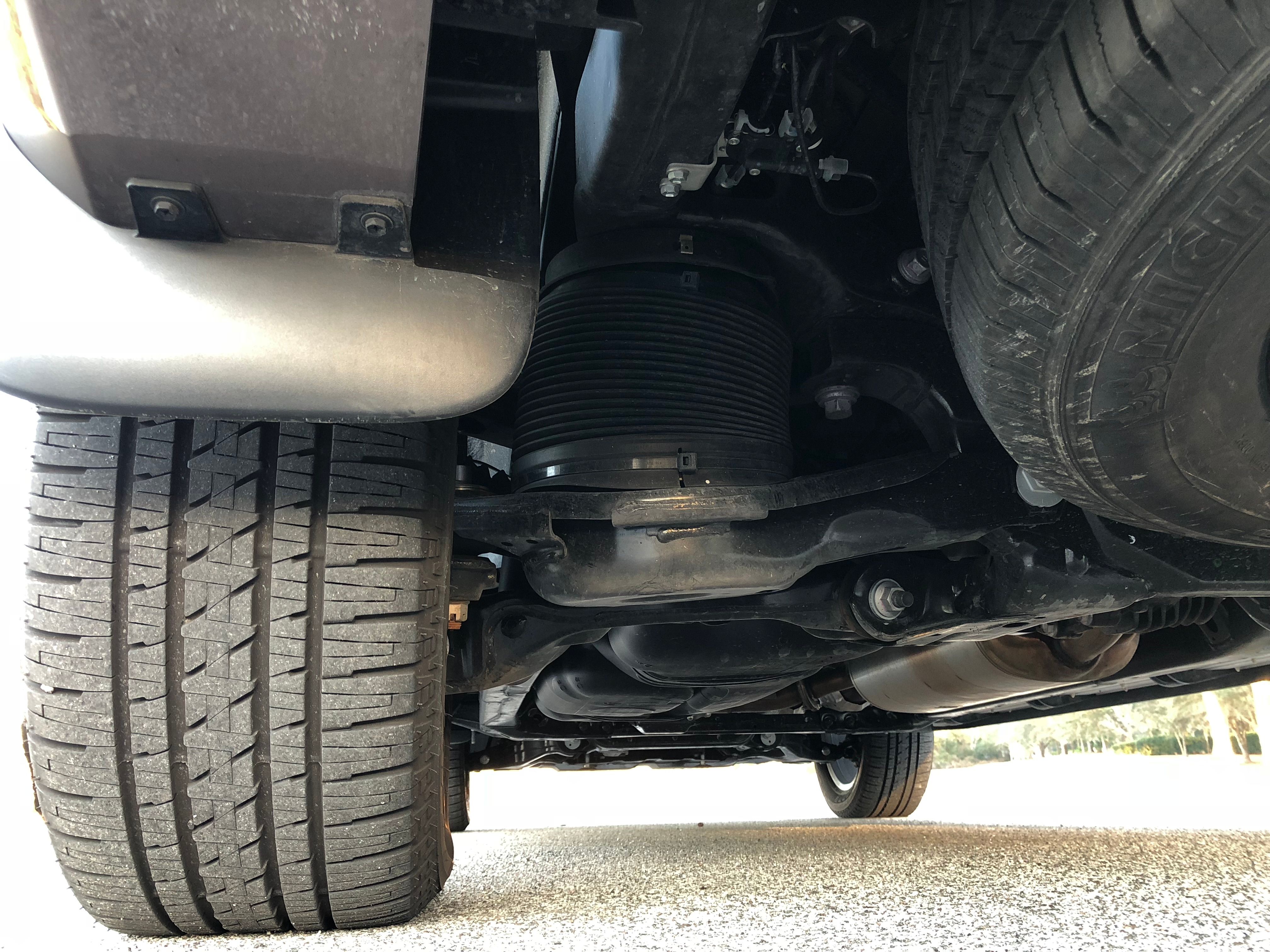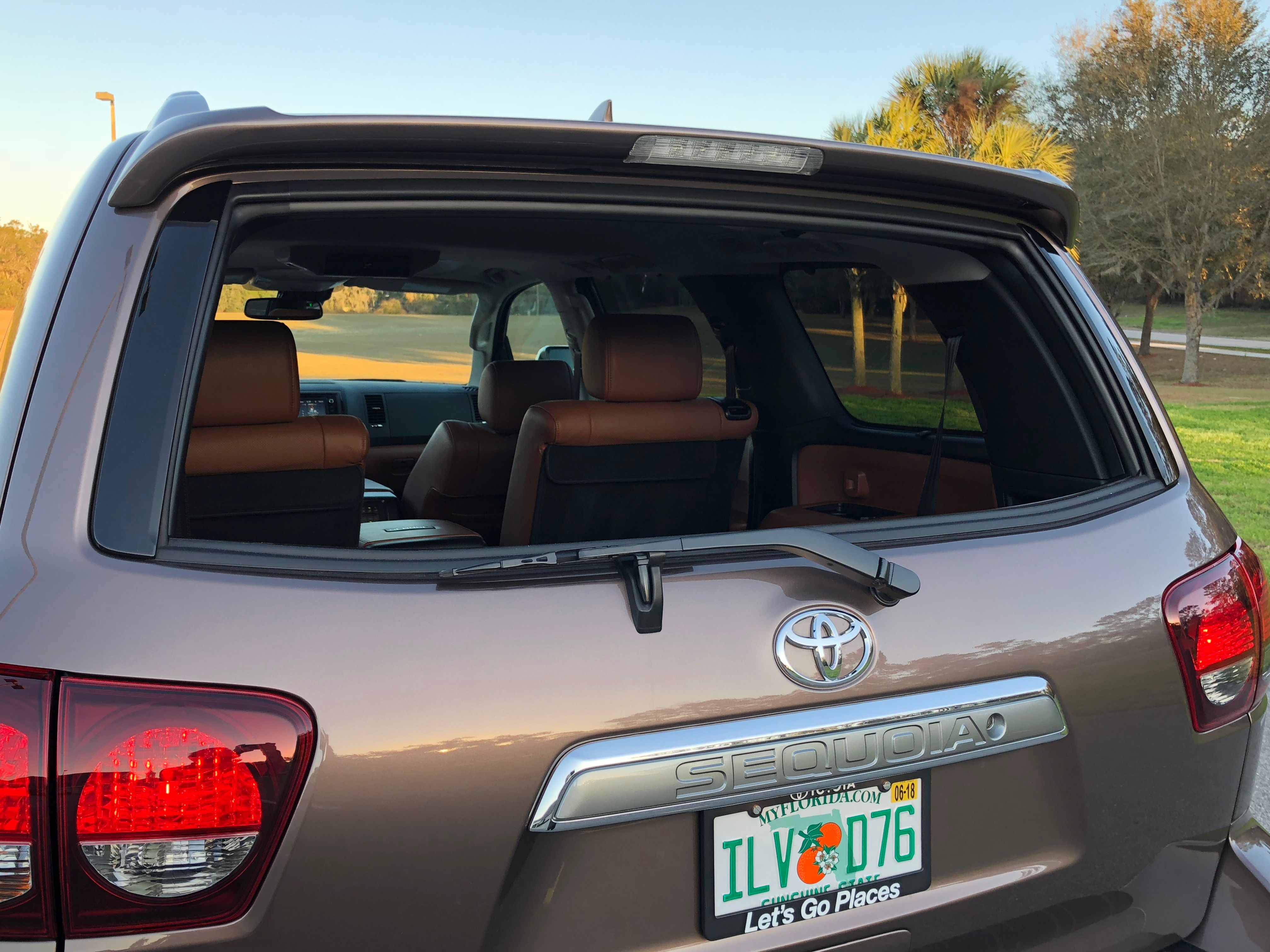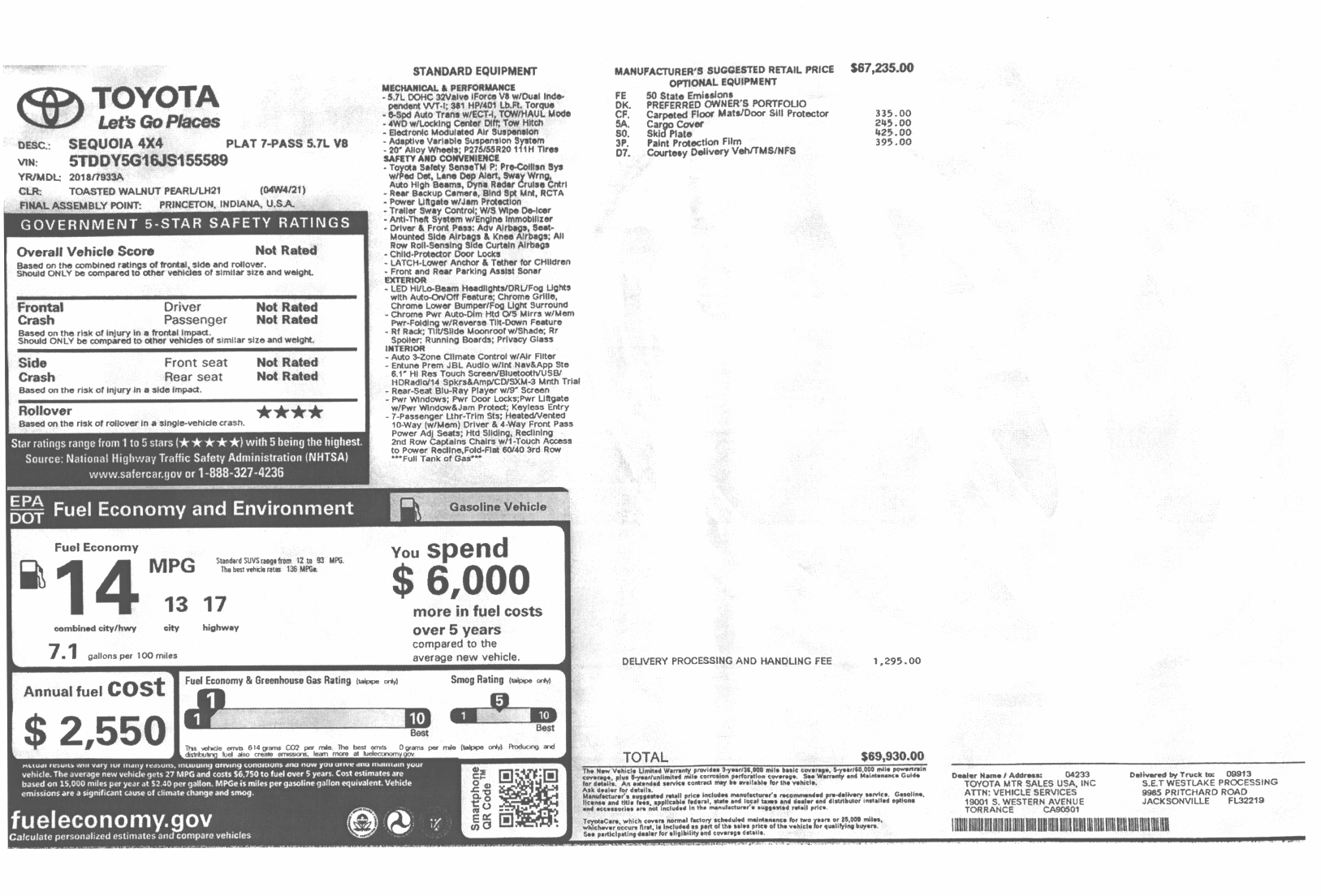The Toyota Sequoia is alive and kicking. You’re forgiven if you’ve forgotten, even despite Toyota giving the full-size SUV a slight update for 2018. The Sequoia’s sales pale in comparison to its rivals, and as such, there are simply fewer on the road. But that doesn’t mean the Sequoia is a bad SUV, right? We decided to have a look.
Our tester came decked out with all the extra goodies thanks to the range-topping Platinum trim. Of course, it also carried all the update Toyota gave it for the 2018 model year, including a new nose, a revised gauge cluster, and the now-standard Toyota Safety Sense-P active safety system. Beyond that, however, the 2018 Sequoia looks and feels nearly identically to the 2008 version.
It’s hard to believe the Sequoia’s second-generation is now a decade old. It harks back to Toyota’s major revamp of the Tundra pickup. It changed to a full-size truck for the 2007 model year and the Sequoia followed suit the next year. The Sequoia shares plenty with the Tundra, including its drivetrain and interior. Toyota did cater the Sequoia towards family usage with an independent rear suspension with available air ride rather than the Tundra’s solid axle and leaf springs. Yet despite the differences, the Sequoia still felt like a truck. In practice though, many full-size SUV customers were into that sort of thing. It fosters a sense of invincibility and a go-anywhere attitude. Well, so long as there’s a gas station close by.
Continue reading for our full review.
2018 Toyota Sequoia - Driven
- Make: Array
- Model: 2018 Toyota Sequoia - Driven
- [do not use] Vehicle Model: Array
Exterior
The Toyota Sequoia’s 2018 refresh is about as mild as a refresh can get. The grille has a slightly sharper appearance with new horizontal slats and accents that help incorporate the new headlights. Those headlights are new, too, with both low and high beams getting LED bulbs and new LED daytime running lights. More LEDs are found in the reshaped fog lights, too. The fog light surrounds are new, as is the black panel in the center of the bumper for the adaptive cruise control and pre-collision with pedestrian detection and automatic braking systems.
Around to the sides, the Sequoia carries the same appearance as before. Sadly, Toyota didn’t give the Sequoia the same updates it gave the 2014 Tundra. The pickup went from a bulbous, plump design to a more cut and muscular appearance. The Sequoia still looks bloated and overweight. The story continues out back, too. The same roundish taillights, the tacky reflectors in the bumper, and overall design carries over from a decade ago.
Of course, looks aren’t everything. Objectively, the Sequoia offers plenty to be proud of. Up front are easily accessible tow hooks protected by an optional $425 aluminum skid plate. Side steps make it easy for smaller kids to climb inside. A two-inch receiver hitch makes towing easy, aided by both four- and seven-pin wiring connectors. And perhaps the coolest feature is the roll-down rear window. A button on the dash sends the rear glass into the tailgate for a completely open-air driving experience. Both the Tundra and 4Runner have this feature, too. Why other SUVs lack this trick is beyond us. It really adds to the experience when driving with the windows down. The Sequoia also enjoys a healthy ground clearance, making it actually capable of doing more than “mall crawling.”
Interior
As little as the exterior changed, so too did the Sequoia’s interior. Toyota did very little to bring the Sequoia into modern times. There is no big infotainment screen or in-dash technologies like Apple CarPlay, Android Auto, or Wi-Fi hotspot. There is no wireless phone charger or bank of USB ports. Rather, the Sequoia is stuck with a low-resolution 6.1-inch touchscreen, a 4.2-inch TFT display in the gauge cluster, one USB port on the dash, and a design that literally dates back a decade. Yep, this is the same split-style dash found in the 2007 – 2013 Toyota Tundra and in every Sequoia since 2008.
Laughably, the 4.2-inch screen is part of the “upgraded” tech for 2018. The screen offers the bare bones of what other premium full-size SUVs come with. The Chevrolet Tahoe and Suburban, GMC Yukon, Cadillac Escalade, and Ford Expedition all have 8.0-inch configurable displays in their gauge clusters. Only the Nissan Armada has a less impressive screen.
Aside from the dated appearance, the dashboard’s layout leads to some odd ergonomics. The HVAC controls are spread out, making adjustments rather difficult for short-armed people. The infotainment screen is also far away, making it hard to use without leaning forward and stretching out. Adjusting the radio tuning feels like holding a crunch at the gym. Perhaps a core workout isn’t a terrible idea for most Americans, but doing so behind the wheel isn’t ideal.
Harping aside, the Sequoia’s interior does provide plenty of room for seven people. Drop the number to six with only two people in the third row, and the comfort level improves even more. Legroom in all seating positions is extremely impressive, as is hip, shoulder, and headroom. Make no mistake, the Sequoia is big and its occupants reap the benefits.
The Platinum trim makes the second-row bench seat turn into captain’s chairs with a large center console. The console offers cup holders down low, buttons for the seat heaters, and a storage compartment up top. What’s more, the console’s lid will flip forward to allow for a flat load floor with all the seats folded. In this position, a plastic tray can be lifted up, revealing even more storage in the bottom of the console. Adding to the comfort levels of the second row are reclinable seatbacks.
Another bonus to the Sequoia’s cavernous interior is its cargo volume. There are 18.9 cubic feet of cargo space behind the third row. At the push of a button, the third row folds flat, pushing the cargo area up to 66.6 cubic feet. With the second-row bucket seats folded flat and the center console’s lid flipped forward, the Sequoia will swallow an impressive 120.1 cubic feet of cargo. That’s extremely impressive considering the Sequoia is shorter than the Chevy Suburban, but only has 1.6 cubic feet less than the ‘burb.
Drivetrain
If you’re paying attention, you’ll probably spot a trend with the 2018 Toyota Sequoia: noting major changes, including the drivetrain. The SUV still uses the same engine, transmission, and suspension setup as it did in 2008. It’s also the same engine and transmission found in the 2007 – 2018 Tundra, too.
Despite its age, the 5.7-liter iForce V-8 makes 381 horsepower 5,600 rpm and 401 pound-feet of torque at 3,600 rpm. Toyota says the engine reaches 90 percent of peak torque before 2,200 rpm, meaning it doesn’t need to be revved out to make power. Impressively, the V-8 doesn’t mind revving, though. It has dual overhead cams that use variable valve timing on both the intake and exhaust sides. When pushed, the V-8 wakes up and moves.
Power is managed by a six-speed automatic transmission that gives surprisingly smooth shifts and seamlessly fades into the background when driving. A part-time transfer case on 4WD models handles the power distribution between the front and rear wheels. The Sequoia is rear-wheel drive during normal driving but can be shifted into 4WD while underway. Shifting into 4WD Low range does require a full stop and shifting the transmission into neutral, but the process still happens pretty quickly.
Of course, low range is best used for climbing over steep terrain, blasting through sand or mud, and pulling heavy loads at walking-pace speeds. Towing a boat up a slippery ramp is a perfect example. If the going gets really slippery, the Torsen center differential can be locked into providing a 50/50 power split between the front and rear axles.
Toyota does give the Sequoia some electronic traction aids, too. The A-TRAC system is activated by pressing the traction control button shorter than three seconds. The system then uses individual brake controls to stop a wheel from spinning and therefore sending power to the opposite wheel. It’s basically an electronic form of locking differentials. Even the Jeep Wrangler uses a similar system. The result is a surprisingly capable SUV, despite its size and weight.
The downside to this old-school form of powertrain is fuel economy. The EPA estimates the 2018 Toyota Sequoia Platinum in 4WD to get 13 mpg in the city, 17 mpg on the highway, and 14 mpg combined. During our week of testing, we managed between 13 and 15.5 mpg, depending on how much highway driving we did.
And while the 5.7-liter does have dual overhead cams, four valves per cylinder, and variable valve timing, it lacks several of the fuel-saving features found on the competition. It does not have cylinder deactivation, direct fuel injection, or an automatic start/stop system. We are glad it foregoes that last system, though. The Sequoia also uses an insanely stout 4.30:1 rear axle ratio. That’s more gearing than most heavy-duty pickups use.
Suspension System
The Toyota Sequoia rides on a four-wheel independent suspension system and boasts driver-adjustable dampers and an auto-leveling rear air suspension with a manual override. The shocks have three settings to choose from: Sport, Normal, and Comfort. Surprisingly, the different modes actually make a big difference in the Sequoia’s feel. Comfort mode has a smooth, floaty ride that is best enjoyed over rough roads and in off-road situations. Around corners, Comfort mode is too soft and allows noticeable levels of body roll. Turn the dash-mounted knob to Sport mode, and the suspension firms up nicely. Interstate on-ramps can be taken at a brisk pace without feeling top heavy as the big Sequoia remains impressively flat. The suspension becomes firmer over rough pavement, but not so much as to loosen grandma’s fillings. Normal mode does a good job of splitting the difference.
As for the rear air suspension, the system can be raised or lowered, with the normal position being between the two extremes. The system does take a minute or so to adjust to a new ride height, so don’t expect Range Rover levels of suspension adjustment speed. Hitching up a heavy trailer or carrying heavy cargo results in adjustment from the airbags, too. This allows the Sequoia to remain balanced under load rather than having a noise-up appearance, which also decreases safety.
Behind the Wheel
The Toyota Sequoia is the oldest body-on-frame, three-row SUV on the market today, and it drives just as you’d imagine. Honestly, though, as an automotive enthusiast, feeling all the traditional SUV vibes, tall stance on the road, and big V-8 under the hood is rather lovable. The V-8 pulls hard at lower revs but isn’t afraid to swing its tachometer towards 6,000 rpm. As mentioned, the transmission does its job rather well without being noticed. Too bad it needs at least two more gears to be competitive in the premium SUV segment.
Adjust the suspension into Sport mode, and the Sequoia is actually pretty fun to drive. Its tall ride height gives a fantastic view over the road and its large windows make seeing out easy. Better still, the large side mirrors combine with the tall ride to make the wide Sequoia feel narrower than it is. We never felt uncomfortable driving on two-lane roads. About the only downsides to outward visibility is the second-row DVD system blocks the rearview mirror when in use and the absence of a 360-degree camera system – or even a forward camera. A rearview camera and parking sensors are all Toyota supplies.
The Sequoia’s sweet spot is highway cruising. Set the adaptive cruise control, turn the adaptive dampers to Normal, and sit back and enjoy the ride. The Sequoia can make speed deceptive, too, so it’s best to rely on the cruise control if you have a heavy right foot.
Pricing
Toyota has increased prices for the 2018 Sequoia due to the updates it has. The 2017 model started at $45,560 and the 2018 starts at $48,300 – a $2,740 difference. Four trim levels are available for 2018: the SR5, TRD Sport, Limited, and Platinum.
The new-for-2018 TRD Sport starts at $54,240 and includes a monochromatic exterior treatment, seven-passenger seating, 20-inch wheels, LED exterior lighting, and the option to get Toyota’s Entune navigation system.
As for the range-topping Platinum model, it starts at $67,235 and includes the rear-seat Blu-ray DVD player, Blind Spot Monitoring with Lane Change Assist, Entune with navigation and an upgraded JBL audio system, and heated and vented front seats.
Our tester came with four options. The carpeted floor mats and door sill protectors cost a whopping $335; the cargo cover costs $245, the front skid plate costs $425, and the clear paint protection film on the Sequoia’s nose costs $395. Add on the $1,295 destination price, and our 2018 Toyota Sequoia costs $69,930.
The Competition
2018 Chevrolet Tahoe
Like the Toyota Sequoia, the Chevy Tahoe is a body-on-frame, full-size SUV based on a half-ton pickup truck. In the Tahoe’s case, it’s the Chevy Silverado 1500. The two share a similar frame, the same V-8 powertrain, and many of the same buttons, screens, menus, and smaller details. The Tahoe seats up to eight people – seven with the second-row buckets. Chevy keeps the area between the captain’s chairs clear to make access to the third row much easier. The Tahoe’s top trim level, the Premiere, comes with all the bells and whistles like heated and vented front seats, a nice 8.0-inch MyLink infotainment system (with a hidden storage compartment behind the screen) tri-zone climate controls, and a slew of active safety features. Apple CarPlay, Android Auto, Wi-Fi hotspot and wireless phone charging are all present.
The Chevy Tahoe comes standard with the 5.3-liter EcoTec3 V-8 making 355 horsepower and 383 pound-feet of torque. A six-speed automatic does the shifting and a part-time 4WD system with an auto mode is available. (It’s worth noting the GMC Yukon is available with and the Cadillac Escalade comes standard with an eight-speed automatic transmission.) The Tahoe is available with GM’s swanky Magnetic Ride Control and uses a solid rear axle with a multi-link coil spring suspension.
Pricing for the 2018 Chevy Tahoe starts at $48,510 with the LS trim. The mid-grade LT starts at $53,750 and the range-topping Premier starts at $63,435.
Read our full review on the 2018 Chevrolet Tahoe.
2018 Ford Expedition
The Ford Expedition is the newest member of this bunch, having been completely redesigned for 2018. The SUV adopts Ford’s aluminum body panels and a similar high-strength steel frame that underpins the 2018 F-150. The interior also borrows from the F-150 by using its dashboard and in-dash technology. SYNC 3 includes features like a 360-degree camera system, Apple CarPlay, Android Auto, Wi-Fi, and new features like FordPass and Ford+Alexa.
Power comes from Ford’s 3.5-liter EcoBoost V-6 making an impressive 375 horsepower and 470 pound-feet of torque. A 10-speed automatic transmission sends power to the rear wheels, or to all four wheels with the optional 4WD system. Fuel economy is EPA-estimated at 17 mpg city, 24 mpg highway, and 20 mpg combined with RWD versions and 17/22/19 on 4WD models. Like the Sequoia, the Expedition uses a four-wheel independent suspension system. Optional adaptive dampers can be had.
Prices for the Ford reach into the high-end segment of the SUV market. The “base” XLT trim starts at $51,695; the Limited starts T 462,585; and the swanky Platinum starts at $72,710.
Read our full review on the 2018 Ford Expedition.
Conclusion
The 2018 Toyota Sequoia might not be the newest or most sophisticated SUV on the market, but it still offers an impressive level of interior comfort and vast amounts of space. Its powerful V-8 and ladder frame backbone allows it to pull 7,400 pounds on its hitch while the optional 4WD system allows it to explore more than just the mall parking lot.
For all the Sequoia’s shortcomings (and there are plenty), the SUV has an endearing quality that – when driven without comparison to the other SUVs in the segment – makes for a loveable experience behind the wheel. For parents with a lot of kids, the Sequoia offers tons of space while older passengers will enjoy the comforts brought on thanks to the generous legroom in all three rows.
Sadly, most car shoppers aren’t buying in a vacuum; compared to the others, the Sequoia is simply outdated. It’s a shame, really, why Toyota refuses to truly update the Sequoia (and the Tundra, for that matter) to make it more competitive. It seems the company’s full attention is focused on the Corolla, Camry, Avalon, RAV4, and Highlander rather than the other vehicles in its lineup. Granted, those vehicles garner the most sales, but perhaps the Sequoia would too if not a decade old. Just look at the first generation Sequoia – the first generation sold more than 70,000 examples in its first year back in 2002. Now, this petrified redwood only found 12,156 homes in 2017.
We simply can’t see spending nearly $70,000 on an SUV that’s so far behind and averages only 14 mpg combined. There are simply too many competitors with more to offer.
References
Toyota Sequoia
What it's Like to Daily Drive the 2018 Toyota Sequoia
Inside the 2018 Toyota Sequoia Platinum
What’s New on the 2018 Toyota Sequoia
The 2018 Toyota Sequoia is Thirsty
The Toyota Sequoia is Old-School Cool
Read our full review on the 2017 Toyota Sequoia.
Read more Toyota news.

